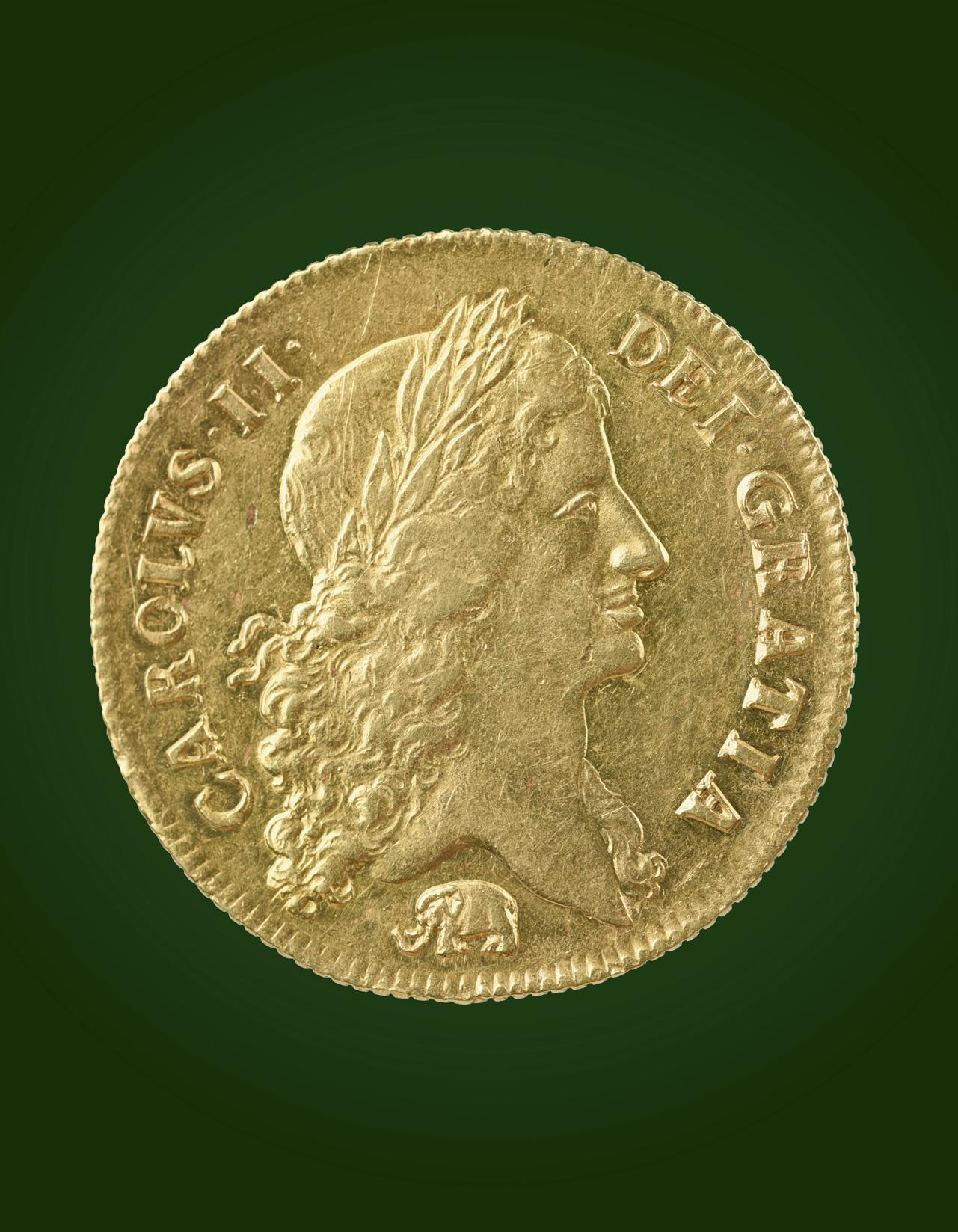
MEDALS & COINS, ARMS & ARMOUR
TUESDAY 3RD JUNE 2025


MEDALS & COINS, ARMS & ARMOUR
TUESDAY 3RD JUNE 2025
20th & 21st Asian Art, Chinese Paintings & Japanese Works of Art
1st The Butler Hoard
2nd & 3rd Furniture, Works of Art & Clocks
9th & 10th Fine Jewellery
15th & 16th Silver & Objects of Vertu, including the Michael Baggott Collection (Part I)
3rd
Medals & Coins, Arms & Armour
4th Modern British & 20th Century Art 18th Fine Arts & Crafts
2nd
British and Continental Ceramics & Glass
3rd Old Masters, British & European Paintings
17th Arts of Africa, Oceania and the Americas
Dates may be subject to change
+44 (0) 1722 424500 info@woolleys.live
5161 Castle Street, Salisbury, SP1 3SU www.woolleyandwallis.co.uk
Lot 238
Francisco Targarona of Madrid: a fine and rare cased pair of Spanish 22 bore convertible ‘Madrid’ lock pistols from the personal collection of Prince Augustus Frederick 1st Duke of Sussex (17731843)
Estimate £20,0003,000
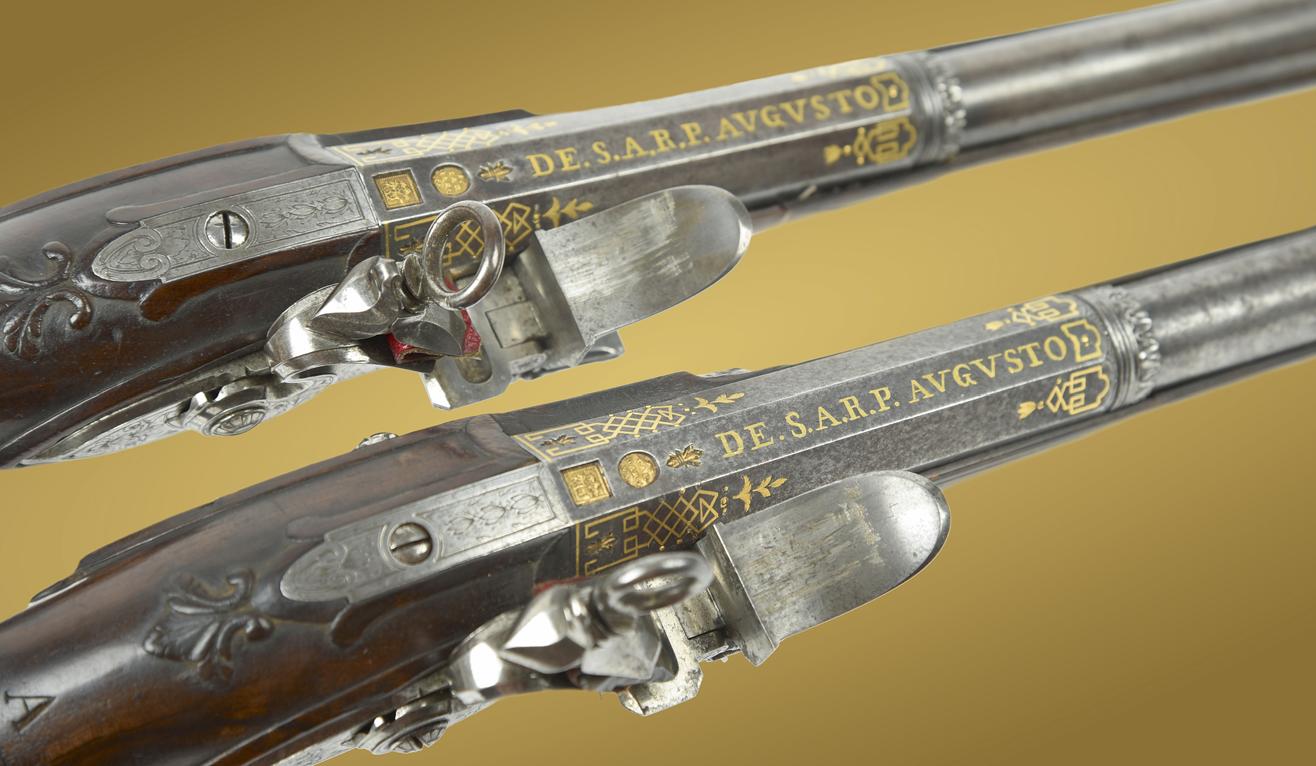
TUESDAY 3RD JUNE 2025
10.00AM
AT OUR CITY CENTRE SALEROOMS, SP1 3SU
VIEWING AT OUR CITY CENTRE SALEROOMS, SP1 3SU
Friday 30th May By Appointment Only
Saturday 31st May 10.00am – 1.00pm
Monday 2nd June 10.00am – 4.00pm
Tuesday 3rd June By Appointment Only
Selected medal lots will be available to view at the Britannia Medal Fair, Victory Services Club, London, W2 2HF
Sunday 11th May 9.30am – 1.00pm
BUYER’S PREMIUM
Each lot is subject to a Buyer’s Premium of 26% plus VAT
CONDITION OF LOTS
Buyers are advised to obtain a full condition report prior to bidding, as descriptions do not normally list faults.
COLLECTION OF LOTS BY APPOINTMENT
Please call 01722 446950 or 01722 424500 to make an appointment to collect from our warehouse
Unit 1B, Castle Gate Business Park, Old Sarum, Salisbury, SP4 6QX
Please instruct carriers accordingly and note, the warehouse is closed over weekends.
All accounts to be settled prior to collection
EXPORT AND CITES LICENCES
Some lots will require export or CITES licences in order to leave the UK or Europe, please refer to the department for guidance.


Ned Cowell 01722 341469 nc@woolleys.live
Molly O’Reilly 01722 446980 mor@woolleys.live
bid.woolleyandwallis.co.uk



Instagram: @woolleyandwallisarmsandarmour @woolleyandwallismedalsandcoins @woolleyandwallissalerooms
Facebook: @woolleyandwallis
Pinterest: Woolley and Wallis
Front cover: Lot 13
Back cover: Lot 68
Catalogue £10.00 (£15.00 by post)

1
An O.B.E. and E.D. group of seven medals: The Most Excellent Order of the British Empire, military division, Officer’s Breast Badge (O.B.E.), second type; 193945 Star; Africa Star, 8th Army clasp; Italy Star; Defence Medal; War Medal 193945; Efficiency Decoration (Territorial), George VI, reverse dated 1951; mounted for wearing, very fine or better [7]; accompanied by a mounted set of corresponding dress miniature medals; together with an unassociated Grant of Dignity for an O.B.E. to Captain Ernest Hubert Pease, 1919.
£150200

2
The Most Exalted Order of the Star of India: a miniature breast badge, gold and enamel with a hardstone cameo portrait of Queen Victoria to the centre, straight bar suspension involving a silver star, original silk ribbon with top brooch.
£250350

3
Jordan Hashemite Kingdom: the Order of the Star, a set of Second Class insignia comprising: neck badge, silver, silvergilt and enamel, 52mm wide; and star, 97mm wide; in fitted Arthus Bertrand case with vacant space for a dress miniature badge, minor wear and enamel damage, very fine or better [2]
£150200
4
France Third Republic: National Order of the Legion of Honour, a knight’s breast badge, gilt and enamels, court mounted for wearing with a horizontal pin, some loss to enamel, very fine; together with a corresponding miniature badge, similarly mounted, very fine, [2]; in an associated case.
£3040

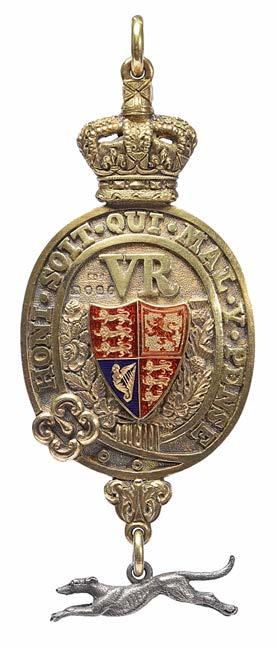
A Victorian Queen’s Messenger’s Badge, silver, silvergilt and enamel, the oval badge bounded by a garter, enamelled arms to the centre within a relief engraved wreath and under the VR cyper, crown suspension with a loose ring, below the badge a pendant silver greyhound running left, London 1875, good very fine or better
Provenance: The Bamber Collection.
£2,5003,000
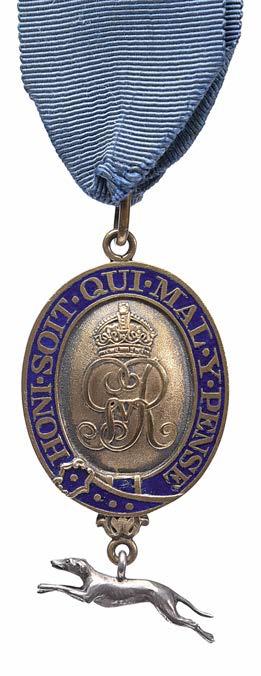
A George V King’s Messenger’s Badge, silver, silvergilt and enamel, the oval badge with convex centre bearing the crowned royal cypher in relief, bounded by a blue enamelled garter, reverse engraved ‘No 17’, below the badge a pendant silver greyhound running left, in fitted case by Garrard & Co. and complete with original garter blue neck riband, minor enamel damage, good very fine.
Provenance: The Bamber Collection
Notes: Allocated during the reign of Queen Elizabeth II to Lieutenant Colonel L. A. Villiers who was a Queen’s Messenger from 195767.
Afterwards returned and sold to Garrards.
£1,5002,000 7
A very rare War Department Messenger’s lapel badge, silver, giltbronze and enamel, oval badge with a central crown and ‘ON SPECIAL SERVICE 1920’ to a blue enamelled border, below the badge a silver pendent greyhound running left, the reverse with lapel fitting and engraved ‘KING’S MESSENGER No 16’, in its fitted case by A. H. Baldwin & Sons Ltd, some enamel damage to the border and the central plaque seemingly lacking its white enamel ground, otherwise very fine.
Provenance: The Bamber Collection.
Notes: During the First World War an increase in the need for sensitive material to be couriered abroad coincided with a contraction in the size of the corps of King’s Messengers. The War Office addressed this situation by creating its own temporary corps of messengers, distinguished by badges of this type.
£400500
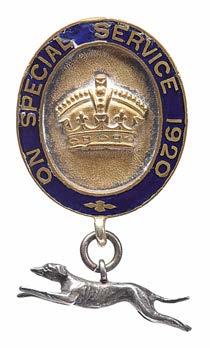
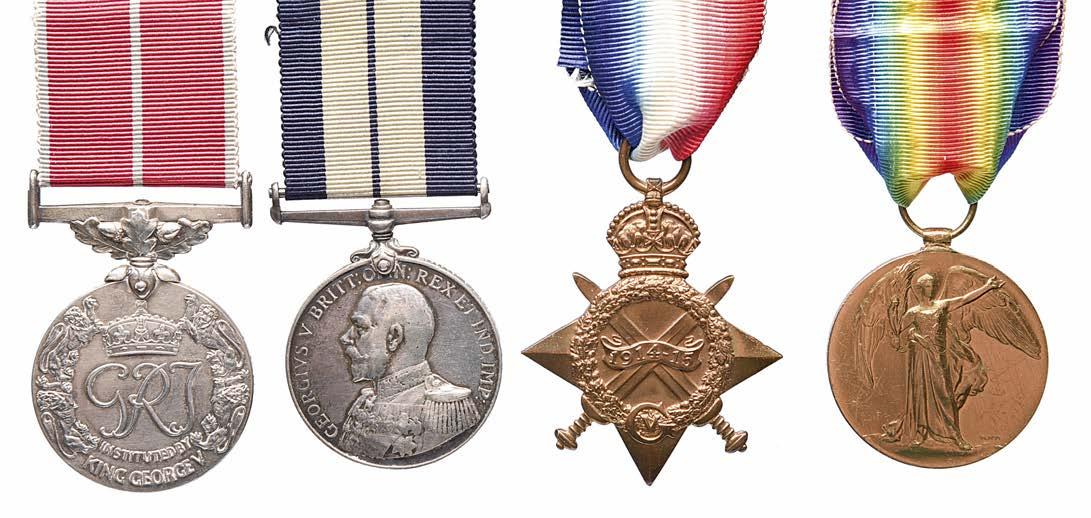
The B.E.M. and D.S.M. with part campaign group to Chief Petty Officer Writer William Charles Bond, Royal Navy, who was awarded the D.S.M. for the action between H.M.S. Alcantara and S.M.S. Greif in 1916: The Medal of the Order of the British Empire for Meritorious Service (British Empire Medal), George VI, GRI cypher (C.P.O. WR. WILLIAM C. BOND, D.S.M., P/MX. 5731), in case of issue, extremely fine; Distinguished Service Medal, George V (M.10262. W. C. F. BOND, 3RD. WR. H.M.S. ALCANTARA. 29. FEB. 1916), very fine or nearly so; 191415 Star (350523, W. C. BOND. S.B.S., R.N.), good very fine or better; Victory Medal (350523 W. C. BOND. CH. S.B.S. R.N.), good very fine, [4]; together with a collection of associated items including the recipient's journal with notes on the sinking of S.M.S. Greif by the Alcantara, press cuttings, correspondence, an ALCANTARA cap tally, a portrait photograph of the recipient, two of the recipient's warrants, a silver presentation tankard to the recipient from the officers of H.M.S. Europa (C.J. Vander Ltd., London 1945) and other items.
Notes: B.E.M. London Gazette 11/07/1940
D.S.M. London Gazette 20/06/1916
William Charles Bond was born in Portsmouth on the 7th of September 1896 and he joined the Royal Navy in November 1914. In 1916 he was serving as Third Class Writer in H.M.S. Alcantara, an armed merchant cruiser employed in the naval blockade of Germany. On the 28th of February, Admiral Jellicoe was made aware that a German commerce raider had entered the North Sea accompanied by a UBoat and he deployed vessels to intercept her. In the previous month Britain had lost the battleship H.M.S. King Edward VII to mines laid by a similar enemy ship, S.M.S. Möwe, which had gone on to sink several allied merchant vessels, and preventing the new threat S.M.S. Greif from escaping into open seas was of great importance. On the 29th of February the Alcantara encountered Greif, disguised as a Norwegian merchantman, northeast of the Shetland Islands, and made preparations for boarding her. A surprise attack from Grief initiated a ferocious gun battle in which both ships were sunk. The battered Alcantara developed a heavy list prior to sinking and William Bond observed a badly wounded marine on the lee side. In spite of having a hernia he slid down the deck to assist and, being unable to drag the man up the sloping deck to the raised side, he helped him off the lower side before following him into the frigid water to take care of him. Leaving a capsizing and sinking ship in this manner is extremely dangerous and Bond's courageous and selfless act was observed by the Alacantara's commander Captain Thomas Wardle, who recommended him for the D.C.M. Bond had already performed a valuable service of another kind by securing the ship's ledger in its special watertight container and for some time afterwards he was uncertain which deed had resulted in the award.
Although he had originally enlisted "for [the] period of hostilities" William Bond went on to have a naval career that spanned both World Wars, and in 1940 he was awarded the B.E.M. "in recognition of services during the war". In addition to the medals offered here he was awarded the British War Medal 191420 and the R.N. L.S.G.C. medal.
£8001,200
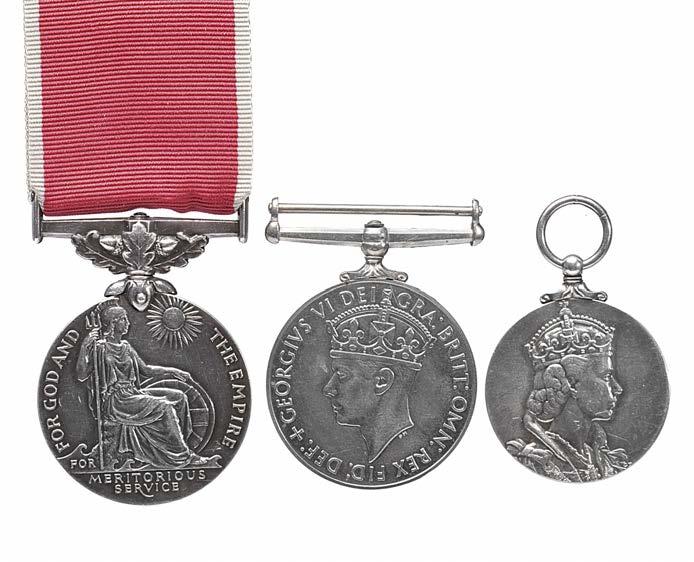
A Manchester Blitz B.E.M. group of three medals to Constable William George, Manchester City Police: The Medal of the Order of the British Empire for Meritorious Service (British Empire Medal), George VI, GRI cypher (WILLIAM GEORGE); Police Long Service and Good Conduct Medal, George VI (CONST. WILLIAM GEORGE); Coronation Medal 1953, unnamed as issued, in card box of issue, all extremely fine or nearly so. [3]
Notes: Constable William George was awarded the BEM for his action during the Manchester “Christmas” Blitz of 22/23 December 1940. “During an enemy air raid PC George went to several places where unexploded time bombs had fallen. He displayed a calm devotion to duty, making thorough observations and arranging for the evacuation of persons within the danger area. At one such incident the bomb exploded, and the Constable was blown against a wall by the blast. Despite the shock he refused to go off duty and gave valuable help at other incidents.”
William George was born near Monmoth and joined the Police on the 18th of February 1925 at the age of 26 and a half years, having previously served in the Royal Navy. He was pensioned on the 27th of December 1958.
B.E.M. London Gazette 21/03/1941. Offered with research.
£500800
A William IV Royal Naval Long Service and Good Conduct Medal to Master at Arms William Walker, H.M.S. Galatea, anchor type obverse (WILLM WALKER Master at Arms H.M.S. GALATEA 25 Years), reverse officially engraved, nearly extremely fine.
Notes: Award confirmed 17th of February 1832.
£8001,200
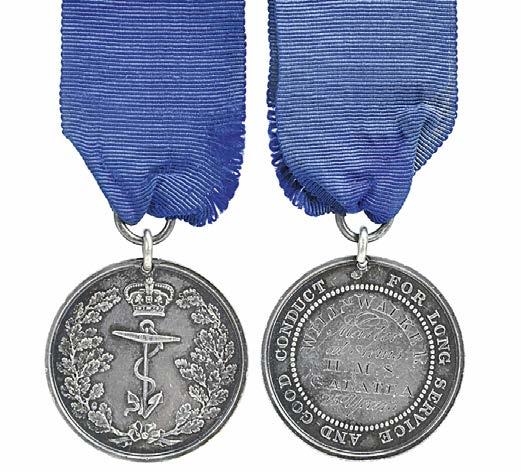

11
A Third Battle of Ypres M.C. attributable to ActingCaptain (later Major) Servais FitzWalter Marius Del Court, M.C. and Bar, Middlesex Regiment, who was twice wounded at Ypres and received the Bar to his M.C. for gallantry in the North Russian Intervention in 1919: Military Cross , George V, reverse privately engraved ‘CAPTAIN S. F. W. DEL COURT YPRES AUG. 16TH 1917’, some contact marks, very fine.
Notes: M.C. London Gazette 18/10/1917
(Bar to M.C. London Gazette 21/01/1920)
Servais Del Court was born in Bruges on the 18th of December 1895, to an English mother and a Dutch father. He was commissioned 2nd Lieutenant in the Middlesex Regiment on the 23rd of December 1914. It was on the 16th of August 1917, during the Third Battle of Ypres, that Del Court now Lieutenant and Acting Captain won his first M.C.
“For conspicuous gallantry and devotion to duty. He was senior officer with the troops of an assaulting battalion. During the attack, when the flank of the battalion became exposed and the advance endangered, with great initiative and coolness under heavy machinegun fire he directed the operations so as to enable the advance to continue. Though wounded, he continued in command with great contempt of danger until severely wounded a second time. When brought back he went first to Battalion H.Q. to make a personal report on the situation.”
Del Court was taken prisoner by the Germans in May 1918, being repatriated in January 1919. He served in the North Russian intervention of 1919, performing the act for which the Bar to his M.C. was awarded:
“For gallantry and good leadership. He ably commanded the company in every action from 15th May till 18th Aug., 1919, particularly on 23rd June, when the enemy was encountered in strength three miles north of Siding 9. Under very difficult conditions he was responsible for driving off the enemy armoured train with rifle grenades, and finally held reinforced enemy in check until ordered to withdraw.”
He returned to civilian life between the World Wars, before being recommissioned in the Middlesex Regiment for the Second World War, having also qualified as an interpreter of ‘Holland Dutch’ in 1938.
£200300
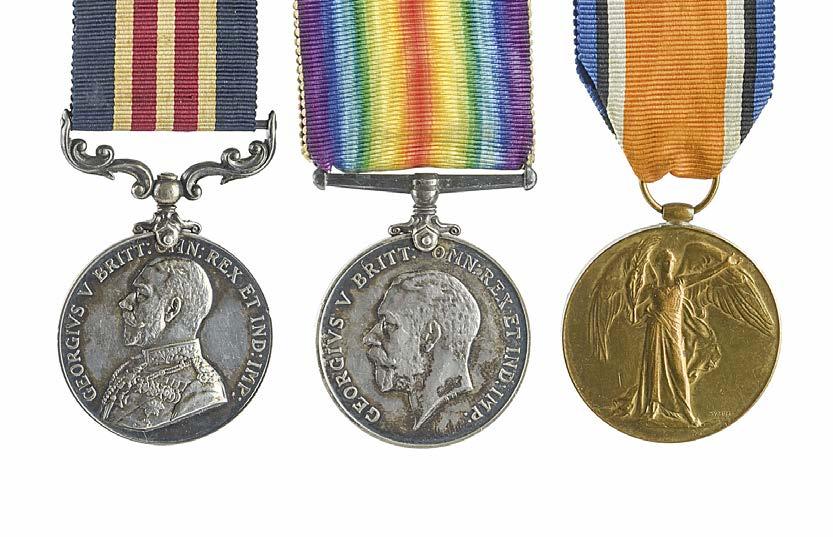
12
A Great War M.M. group of three medals to 2nd Lieutenant F. Armstrong, Royal Artillery: Military Medal, George V (L12478 CPL F. ARMSTRONG. A.160/BDE: R.F.A.), nearly extremely fine and toned; British War Medal 191420 and Victory Medal (2. LIEUT. F. ARMSTRONG.), very fine, [3]; together with a Defence Medal and a War Medal 193945 in postage box to Mr C. C. Armstrong (presumably the first officer’s son).
Notes: M. M. London Gazette 18/06/1917
M.I.D. London Gazette 18/05/1917
Corporal F. Armstrong’s award of the Military Medal was probably for the Battle of Arras, 9th of April to 16th of May 1917. He appears to have been discharged to a commission in May 1918.
Ref. Williamson, Vol 1, P. 407.
£150200
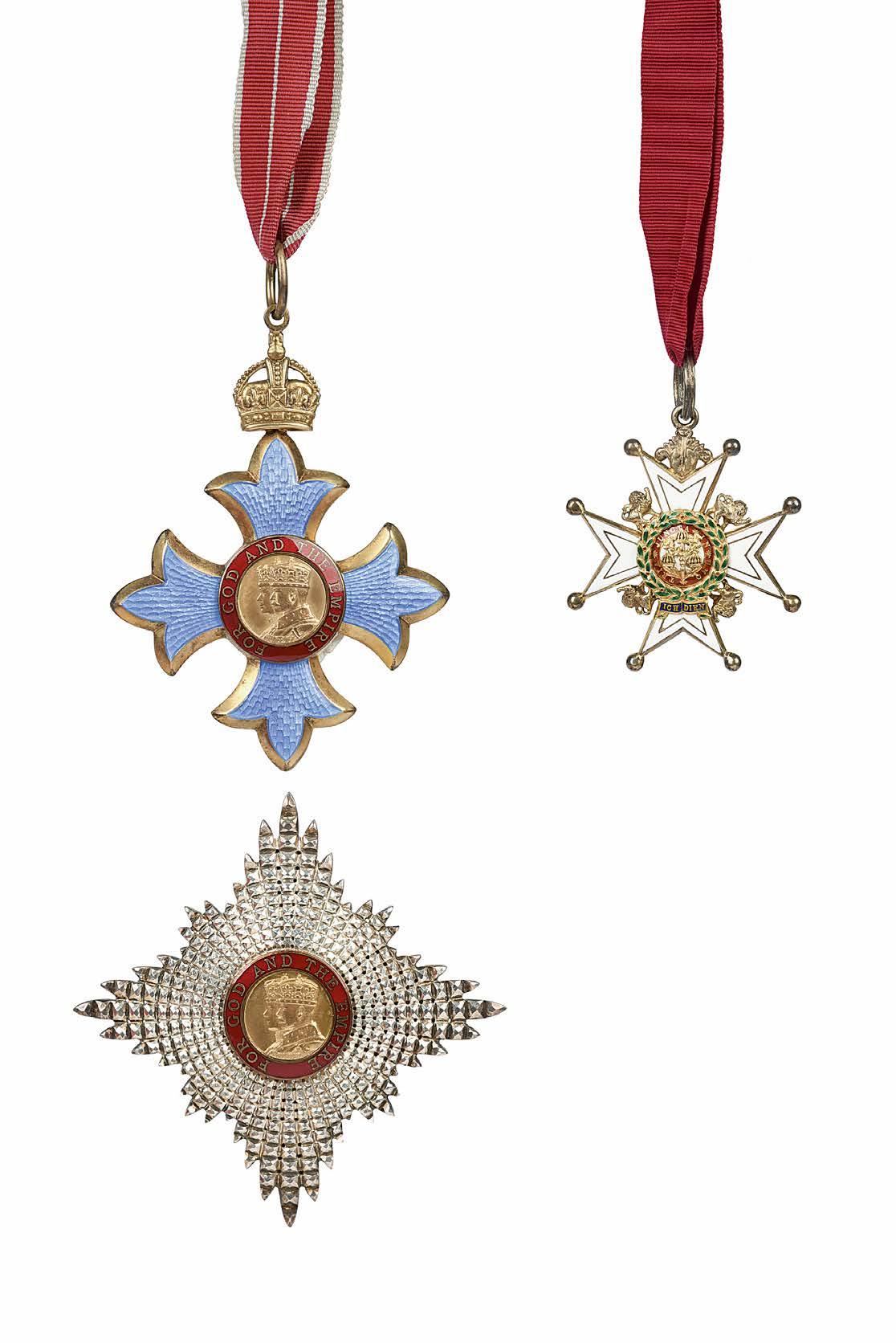
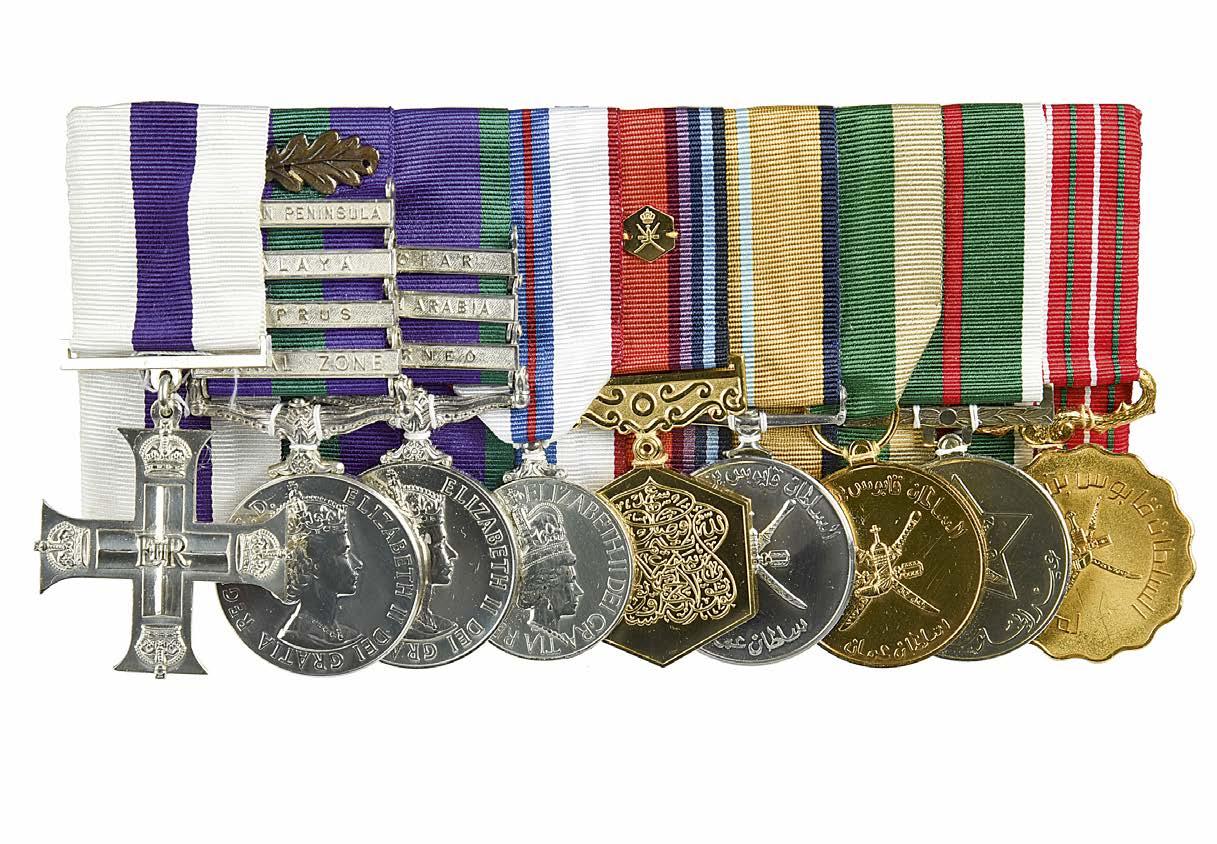
The rare and historically important SAS Military Cross group of awards to LieutenantGeneral Sir John Peter Barry Condliffe Watts, K.B.E., C.B., M.C., Royal Ulster Rifles and 22 Special Air Service Regiment, comprising: The Most Excellent Order of the British Empire, Military Division, Knight Commander's Neck Badge and Star, silvergilt and enamels, in Garrards's case of issue; The Most Honourable Order of the Bath, Military Division, Companion's Neck Badge (C.B.), silvergilt and enamels, in Collingwood's case of issue; Military Cross, Elizabeth II, reverse dated 1959; General Service Medal 191862, Elizabeth II, with Mention in Despatches emblem, 4 clasps: Canal Zone, Cyprus, Malaya, Arabian Peninsula (LT J P B C WATTS PARA), lightly engraved in plain capitals, a late issue with clasps mounted in the foregoing order*; General Service Medal 19622007, 3 clasps: Borneo, South Arabia, Dhofar (MAJOR. J. P. B. C. WATTS. M.C. R.U.R.), officially impressed; Jubilee Medal 1977, unnamed as issued; Oman: Order of the Special Royal Emblem; Accession Medal; Peace Medal; 10th National Day Medal; 15th National Day Medal; the last nine awards court mounted, the order insignia extremely fine, the mounted group good very fine or better [11]; offered with the following associated items:
The recipient's court mounted set of dress miniature medals, corresponding in most respects to the forgoing medals and including miniatures for the Order of Sultan Qaboos and the Order of Oman**; Grants of Dignity for the recipient's C.B.E., C.B. and K.B.E., each with covering letter; a typed signed letter from Lt Gen David Mostyn, on MOD letterhead, dated December 1984 and advising the recipient of his admission to the Order of the Bath; a typed signed letter from Maj Gen Desmond Rice, C.V.O., C.B.E., Deputy Secretary of the Order of the Bath, dated 9th of May 1985, explaining procedural aspects of the order; statute books for the Order of the Bath and the Order of the British Empire; a small collection of the recipient's insignia and medals ribbon bars, and his dress spurs.
“[A] formidable SAS commando … tough and, some would say, ferocious .. he used every opportunity to get onto active service.” 1
“… a great deal of the success [of the assault on Jebel Akhdar] can be attributed to his courage and leadership.” 2
“..an extremely brave and fearless commander as well as … an outstanding tactician.” 3
“It has been as a result of his overriding direction and training that the Special Air Service have [sic] played such a significant role in counter-terrorism … few officers have done so much to contribute to the overall defeat of terrorism.” 4
“The name of the Special Air Service, already a legend in its own right, has been enhanced even more during his period in command.” 4
John Peter Barry Condliffe Watts (19302003) was a gallant soldier and an exemplary special forces officer and is a towering figure in the postwar history of the SAS. He excelled at all levels of command, combining fearlessness, fortitude and tactical acuity with exceptional leadership qualities and uncommon powers of diplomacy.
Born in Portsmouth on the 27th of August 1930, John Watts went to school in Cornwall before joining his mother and stepfather on the North West Frontier of India, where he spent much of his boyhood and early education. He later attended Westminster School and Andover Academy in Massachusetts, USA. Watts’s military career began in 1949 when he was called up for National Service in the King’s Royal Rifle Corps. He subsequently attended the Officer Cadet School at Eaton Hall and, his leadership potential having been recognised, proceeded to the Royal Military Academy Sandhurst whence he was commissioned 2nd Lieutenant in the Royal Ulster Rifles on the 30th of March 1951. He was promoted Lieutenant in 1953, and after two years in Hong Kong with the RUR he volunteered for the Parachute Regiment and he joined the 3rd Battalion in Suez in 1954.
The British Special Air Service (SAS), famous for the groundbreaking methods that it employed in the Second World War, had been reformed in the Territorial Army in 1947, and its regular army regiment was raised in 1952 as 22 SAS. The recipient’s long and distinguished association with the regiment began in 1955 when his company was attached to 22 SAS for an Operational tour in Malaya. In 1957 he passed selection and embarked upon direct service in the SAS. In this period he also served with 1 RUR in Cyprus before being recalled to Malaya to command D Squadron 22 SAS. By this time a Captain, he took his squadron deep into the jungle in a series of raids against Communist guerillas. He led with great courage and panache and was mentioned in despatches following this tour.
In 1957 a long standing contention between the Britishsupported Sultan of Oman and the Saudibacked tribes of Oman’s hostile interior regions had escalated into a fullblown conflict known as the Jebel Akhdar War, sonamed for the commanding massif that forms part of the Hajar Mountain range separating the coastal plain of Oman from the arid interior, and which provided the rebel forces with a virtually impregnable base.
A combination of regular British personnel and the Sultan’s armed forces under the command of mainly British ‘contract officers’ succeeded in securing certain key locations and in restricting the movements of the rebels, but they were unable to address the overwhelming challenge of assaulting them in their mountain fastness. It was decided that the task must fall to the SAS, and at the request of the leader of the Sultan’ Armed Forces – Colonel David Smiley, on secondment from the Blues – Captain John Watts arrived from Malaya at the head of D squadron in the last week of November 1958.
The Jebel Akhdar had last been scaled against armed opposition by the Persians in the 18th century, at great loss of life. Its central plateau stands at 6,600 feet above sea level and its highest peak at 9,902 feet. The heights are approached by narrow and precipitous trackways, and the altitude, gradients, and extremes of temperatures make it one of the harshest environments on earth. Immediately upon his arrival Captain Watts, appraised by Smiley as “a stocky, tough, and dedicated professional” 5, set about acclimatising his men to their unforgiving surroundings and mounting a series of aggressive operations that cut off the rebel’s supplies and probed the approaches to the Saiq Plateau, where three key rebel villages and their entrenched position at Aquabat al Dhafar were situated.
The final assault took place on the 26th January 1959. Watt’s squadron had been joined in theatre by A Squadron, and a plan had been formed to circumvent the pathways – which were guarded and take the heights in a surprise attack up a narrow, trackless ridge while the rebels were distracted by a demonstration against their main position. It was a risky undertaking and in the final stage of the ascent, when even his pack animals had proved unequal to the task, Watts made the difficult decision to order packs abandoned and to lead his men on with only their rifles in an arduous race to the top. Opposition was encountered but the firstclass planning and execution of the operation meant that British casualties were light and the raid was a complete tactical success in the best traditions of the British special forces. For this action Captain Watts was awarded the Military Cross.
Following the Jebel Akhdar War Captain Watts rejoined the RUR in the British Army of the Rhine, and went on to serve as GS02 at Headquarters Berlin. He was promoted to Major on the 9th of February 1964, in which year he rejoined 22 SAS in Borneo, where the British were supporting the recently formed state of Malaysia, who’s territory in the North of the island was under attack by Indonesia in the South.
The campaign in Burma involved intensive fighting patrols in dense and inhospitable jungle along a 900 mile border to intercept and defeat the relentless incursions of the Indonesians. In addition, the SAS undertook the extremely high risk and at the time clandestine task of crossing the border into Indonesian territory to gather intelligence and conduct ambushes against the enemy. Major Watts was once again in his element. He raised and trained a new B Squadron which mounted raids up to an unprecedented six miles behind enemy lines.
In 1965 Major Watts took B squadron to Aden where the British supported federal government was under pressure from an Egyptian and Yemeni backed insurgency. This was a vicious and bloody campaign, in which the SAS was employed in a covert capacity, and Major Watts displayed enormous flair in intelligence gathering and anticipating the actions of his enemy.
Various other postings followed and in 1967 Major Watts returned to Hong Kong as brigade commander of the 48th Gurkha Infantry Brigade. In the following year he was promoted Lieutenant Colonel in the Royal Irish Rangers (newly formed by the amalgamation of the RUR with the Royal Irish Fusiliers and the Royal Inniskilling Fusiliers), and in December 1969 he resumed his special forces role upon being appointed CO of 22 SAS.
In 1965 the Omani province of Dhofar had risen in rebellion against the increasingly unpopular and illiberal Sultan Said bin Taimur, and in the summer of 1970 Said was overthrown by his son, the progressive Qaboos bin Said. Qaboos wished to enact a program of reform but before reconstruction could begin in Dhofar the threat posed by the communist sponsored Adoo rebels had to be confronted. Lieutenant Colonel Watts masterminded a comprehensive plan that included the recruitment of local irregular fighters known as Firqats, and extensive intelligence gathering activities. The responsibilities that he assumed were not restricted to the military sphere, and his sagacity and organisational powers were brought to bear on such matters as agriculture, civic reform, and medical and veterinary aid – all vital to the stabilisation and reconstruction of the wartorn region.
In October 1971 John Watts led elements of 22 SAS supported by a regiment of the Sultan’s Armed Forces and the Firqats in a major effort to seize control of the rebel dominated hill country under the codename ‘Operation Jaguar’. During this protracted period of hard fighting his preference for leading from the front saw him accompanying his troopers on patrol and the example of his bravery and coolness under fire “spurred the men under his command to greater efforts in spite of fighting under extremely difficult conditions against a highly skilled enemy” 3. When one of his men was badly wounded giving covering fire to a firquat in a forward position, Watts risked his life to bring the casualty in under fire 6. On the conclusion of this tour he was made an Officer of the Order of the British Empire (O.B.E.)
A posting as an instructor at the Staff College, Camberley, was followed by promotion to Colonel and a job in the Ministry of Defence. Then, on the 26th of September 1975, John Watts was made Director SAS and Commander SAS Group, in the rank of Brigadier. He took on the huge responsibilities of this prestigious appointment with his accustomed skill and energy, meeting the political demands of the job with the same adroitness that he brought to military matters. The fearsome warlike qualities that weighed so heavily against his adversaries were matched by a warmth and humanity that enabled first class relations with colleagues and collaborators at every level, from soldiers to senior politicians at home and abroad.
The 1970s saw an increase in global terrorism, and under Watts’s guidance the SAS rose to the challenge, growing and adapting to become, in the words of one of his superiors, “… the finest counterterrorism force in the world.” 4. The scope of their activities was considerable, with operations conducted in Northern Ireland and around the world. Brigadier Watts excelled in an advisory and diplomatic role with foreign powers, an example being the assistance given the West Germany in saving the lives of the hijacking victims of Lufthansa Flight 181 in Mogadishu in 1977. In recognition of this outstanding devotion to duty and “… effort … consistently … beyond that which his job requires” 4 he was elevated to Commander in the Order of the British Empire (C.B.E.) in 1979.
Brigadier Watt’s tour as Director SAS concluded at the end of 1978, and in April of the following year he was called on to return once again to Oman. The post of Commander of the Sultan’s Land Forces was still being filled by officers on secondment from the British Army, and in 1979 Sultan Qaboos rejected the British Government’s nominee and out of the confidence and esteem in which he held John Watts, requested him instead. Long experience and his affection for the people of the region made Watts ideal for the job, and, by now a MajorGeneral, he applied himself to the modernisation of the Sultan’s forces, with the particular aim of transferring the balance of control to Omani officers. In 1984 he was raised to the position of Chief of Defence Staff in the Sultan’s Government and made a Companion of the Order of the Bath (C.B.), and in 1987 he was promoted to LieutenantGeneral and was knighted by progression to Knight Commander of the Order of the British Empire (K.B.E.).
After leaving the Sultan’s service LieutenantGeneral Sir John Watts remained his friend and frequent guest. He also hosted many Omani friends in his retirement in Wiltshire. He died in December 2003 after a life of extraordinary courage and attainment, and of dedication to the security of the United Kingdom and the success and prestige of her armed forces.
M.C. London Gazette 25/08/1959
C.B. London Gazette 31/12/1984
K.B.E. London Gazette 31/12/1987
Obituary, The Times, 15/12/2003
2. Recommendation for the Military Cross, WO 373/125/1
3. Brigadier R.F. Semple in his recommendation for the OBE. WO 373/174/341
4. Maj. Gen. M. B. Farndale in his recommendation for the CBE, WO 373/177/232
5. David Smiley, ‘Arabian Assignment, Operations in Oman and the Yemen, 19581961 and 19631968’, p. 93
6. Obituary, The Daily Telegraph, 15/12/2003
Other sources: John Hayward, Diana Birch and Richard Bishop, ‘British Battles and Medals’; P. E. Abbott and J. M. A. Tamplin, ‘British Gallantry Awards’; S. Monick, ‘Victory in Hades: The Forgotten Wars of the Oman, 19571959 and 19701976’.
*The order in which the clasps are mounted, and the late naming style, may be connected to the fact that the Canal Zone clasp was authorised close to the end of the recipient's life.
** fullsize insignia not present.
£40,00060,000


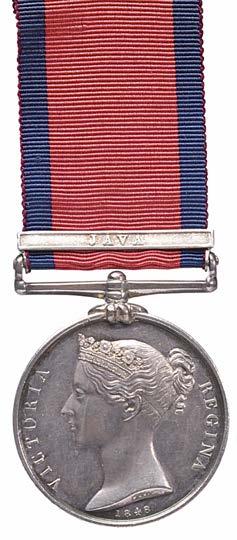
A Military General Service Medal 17931814 to Lieutenant Charles Lowrie, 69th Regiment of Foot, who was severely wounded in Java 1811 and was also entitled to the Naval General Service Medal 17931840 with the very rare clasp Otter 18 September 1810, clasp: Java (CHAS LOWRIE, LIEUT 69TH FOOT), good very fine or better
Notes: Charles Lowrie was commissioned into the 69th Foot on the 17th of December 1802, and was promoted Lieutenant on the 14th of July 1804, Captain on the 11th of June 1812, and Major on the 29th August 1826. He served in Grenadier Company of the 69th at the capture of Java in 1811 and was severely wounded (shot through the body) during the storming of Fort Cornelis on the 26th of August 1811. Lowrie had also been present on HMS Otter on the 18th of September 1810 when, in the company of Staunch and Boadicea, it captured the French 40gun frigate Venus, recaptured the 38gun HMS Ceylon and rescued Major General Abercromby and his staff. He was thereby entitled to the NGS with the very rare clasp Otter 18 September 1810 but appears not to have claimed it. Of the 75 officers and soldiers of the 69th present at the action only Private Benjamin Pratt is confirmed as having claimed the medal.
Offered with copy research.
£2,0002,500
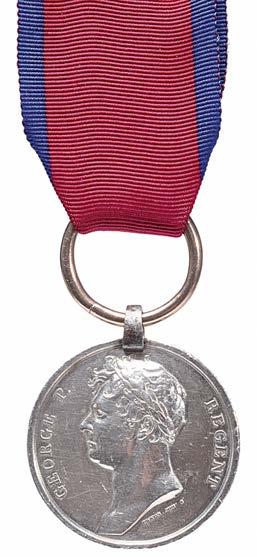
A Waterloo Medal 1815 to Private John Smith, 4th Regiment of Foot, a veteran of the Peninsular War and the War of 1812 and a Waterloo casualty (JOHN SMITH, 1st BATT. 4th REG. FOOT.), iron clip suspension with privately fitted gold ring, some edge bruising, otherwise good very fine.
Notes: John Smith enlisted in the 4th Foot in April 1810 and was discharged in June 1818. He was present at a number of battles in the Peninsula including Corunna and Badajoz (MGS not claimed) and was wounded during the retreat from Burgos. In America during the War of 1812, he was present at the Battles of Bladensburg and North Point, the burning of Washington and the operations against New Orleans. In 1815 John Smith fought at the Battle of Waterloo where he received a lance wound in the elbow. According to his pension papers (copy included) his father sold the medal at Bury St Edmunds in about 1824.
This man is the only John Smith on the 4th Foot Waterloo medal roll. Very unusually, his Soldier’s Small Book still survives and is held at the National Archives. In addition to details of his military service it contains interesting notes on his family and work.
Smith died in 1883 aged 92 and is buried at St Nicholas’s Church, Thelnetham, Suffolk. His headstone still exists and has the following inscription “JOHN SMITH / A BRAVE SOLDIER AND GOOD / CHRISTIAN. HE SERVED HIS KING AND / COUNTRY IN ALL THE BATTLES AND SIEGES / IN THE PENINSULAR WAR IN AMERICA AND WATERLOO. / HE DEPARTED THIS LIFE IN THE FAITH AND / FEAR OF CHRIST / JAN 12TH 1883 / AGE 92 YEARS.
Offered with copy research.
£1,5001,700
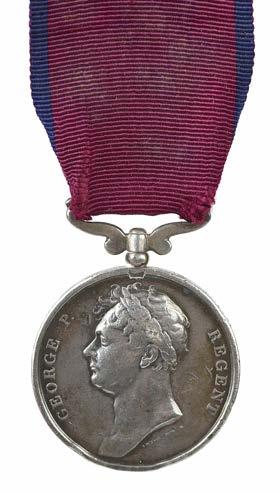
A Waterloo Medal 1815 to Private Charles Rosson, 33rd Foot, (CHARLES ROSSON. 33RD REGIMENT FOOT.) privately fitted swivelling suspension with a small scrolling bar; worn and with edge bruising including a dent partially obscuring the initial letter of the surname, good fine.
Notes: Recipient not traced on rolls, though naming appears correct and official.
£400500
A China Medal 1842 to Lieutenant William Haskoll, Royal Navy, a veteran and Prisoner of War of the War of 1812 (W. HASKOLL, LIEUT, H.M.S. CRUIZER.), private swivelling suspension, good very fine.
Notes: William Haskoll entered the Navy on the 1st of March 1809 on board H.M.S. Victorious and served in her until August 1814. He served in the Walcheren expedition and in the War of 1812 and was taken prisoner by the Americans when, in the ship’s boats, he was attempting to cut out the Diomede. Haskoll commanded the second division of boats at the taking of Fort Macao on 13 Mar 1841 and was in charge of the gunboats at the capture of the fort below the Folly for which he was promoted to Commander.
Upon retirement as a Captain he held various posts at Radley College, Oxford, the website of which contains many photographs and other information relating to Captain Haskoll including a fine photograph of him wearing his medal.
O
ffered with copy research including the aforementioned portrait.
£1,0001,500
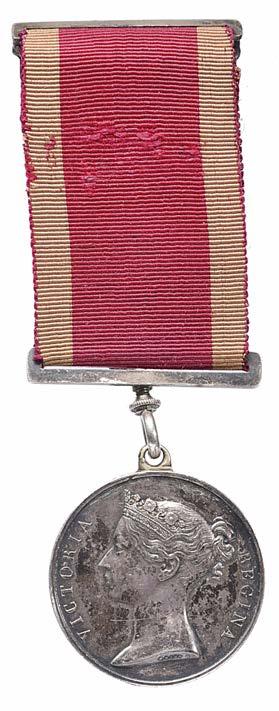
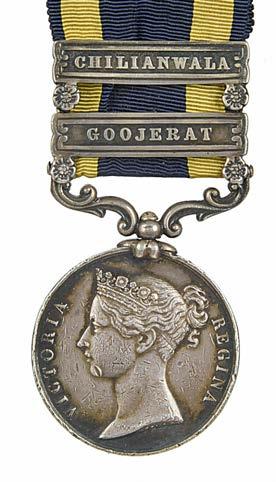
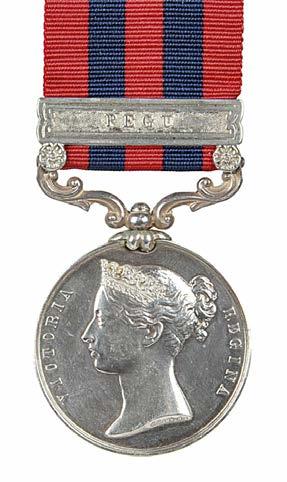
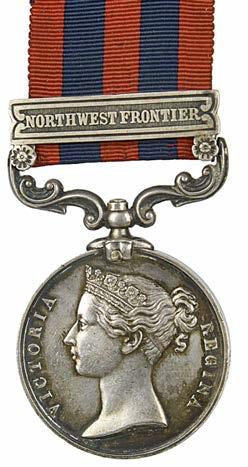
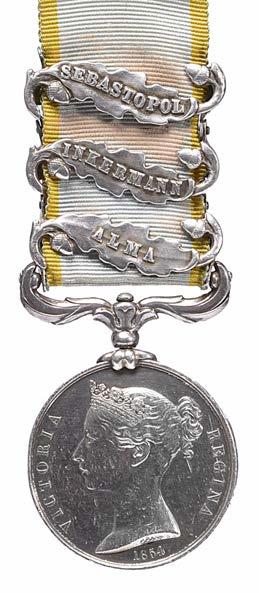
18
A Punjab Medal 184849 to Private John McSweeney, 9th Lancers, 2 clasps: Goojerat, Chilianwala (J. MCSWEENEY, 9TH LANCERS.), contact marks and some edge bruising, very fine.
Notes: Also served in the first AngloSikh War (entitled to Sutlej Medal with Sobraon reverse) and the Indian Mutiny (entitled to medal with clasp: Delhi).
£150200
19
An India Medal 184995 to Private David Davies, 51st Light Infantry, clasp: Pegu (DAVID DAVIES. 51ST K.O. LT. INFY.), impressed in serif capitals, extremely fine or early so; together with another to Private Charles Goddard, 3rd Battalion the Rifle Brigade, clasp: Northwest Frontier (947 PTE C. GODDARD. 3RD BN RIF. BDE), impressed in serif capitals, good very fine. [2]
Notes: David Davies was born in Merionethshire and attested for the 51st Light Infantry in Chester, 1832, aged 21 years. He served with his regiment in the campaign against the King of Ava in 1852/53, and was discharged in 1854, being no longer fit for duty. He ended his career having been tried three times by courtmartial, though also possessing two good conduct badges.
Charles Goddard served under Brevet Colonel Macdonell against Sultan Muhammed Khan 5th December 1863 to 2nd January 1864. Also previously served in the Indian Mutiny and entitled to the medal with clasp for Lucknow.
£150250
20
A Crimea Medal 185456 to Private Thomas Berry, 47th Regiment of Foot, 3 clasps: Alma, Inkermann, Sebastopol (PRIVATE THO’S. BERRY, 47th REGT.), engraved in serif capitals by Hunt & Roskell, contact marks to both fields and bust, near very fine.
Notes: Thomas Berry joined the 47th Regiment in 1838 and took part in the battles of Alma, Inkermann and Sebastopol. He was invalided home from the Crimea in October 1855 and discharged from the Army in 1860. He kept a diary throughout the Crimean campaign which currently held at the Birmingham City Library. Following his discharge from the army he served in the militia and was the landlord of a number of public houses in Great Yarmouth until his death in 1893.
£500600
21
A Crimea Medal 185456, clasp: Sebastopol, unnamed as issued, good very fine.
£100150

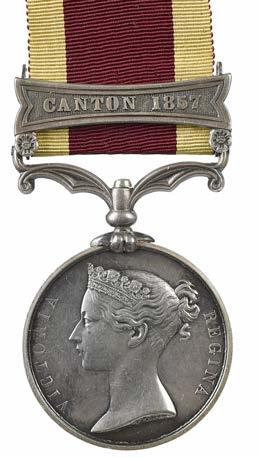
A Second China Medal 185660, clasp: Canton 1857, unnamed as issued, good very fine with some light toning.
£150200

A South Africa Medal 187779 to Private J. Brown, 1st Battalion 13th Regiment of Foot, clasp: 18789 (1453. PTE.. J. BROWN. 1/13 FOOT.), officially engraved, good very fine or better
£300400 24
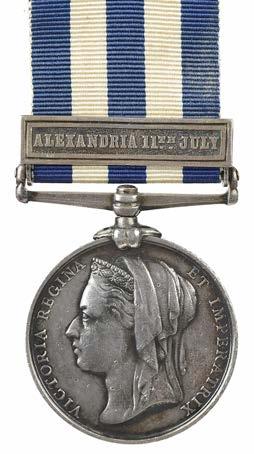
An Egypt and Sudan Medal 188289 to Lamp Trimmer Luther William Walters, Royal Navy, dated reverse, clasp: Alexandria 11th July (L. W. WALTERS. LAMP TR.. H.M.S. TEMERAIRE), contact marks from a Khedive’ Star, otherwise very fine.
Notes: Born in Southsea on the 3rd of April 1861. Served in H.M.S. Temeraire between the 15th of December 1880 and the 14th of April 1884.
£200300

25
An Egypt pair to Lieutenant Rowland Winn, Lord St Oswald of Nostell, 1st Battalion Coldstream Guards: Egypt and Sudan Medal 188289, undated reverse, clasp: Suakin 1885 (LIEUT: R. WINN. 1/COLDM. GDS..), about very fine; Khedive’s Star, 18846 obverse, unnamed as issued, very fine. [2]
Notes: Rowland Winn served with the Coldstream Guards in Egypt in 1885 and was present at the action at Hasheen and the attack on the convoy of the 24th of March, and at the action at Tamaai. He later became Lord St Oswald, JP for West Riding and MP for Pontefract.
He kept a detailed diary of his military service including his time in Egypt (46 pages) and this is held by the West Yorkshire Archives in Leeds.
Offered with research.
£600700
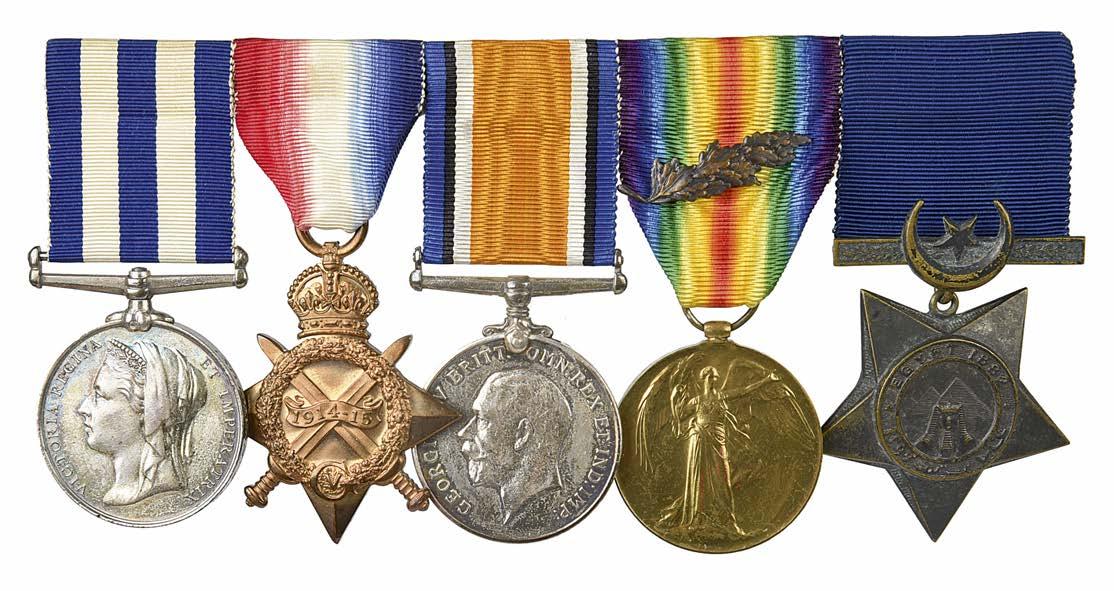
A group of five medals to Paymaster Commander Scarlett de Verde Taylor, Royal Navy: Egypt and Sudan Medal 188289, dated reverse, no clasp (S DE V. TAYLOR. CLERK. R.N. H.M.S. EURYALUS), engraved; 191415 Star (FT. PAYR. S. DE V. TAYLOR. R.N.); British War Medal 191420 (PAYR. COMMR. S. DE V. TAYLOR. R.N.); Victory Medal, MID emblem to the ribbon (PAYR. COMMR S. DE V. TAYLOR. R.N.); Khedive’s Star, 1882 obverse; mounted for wearing, Egypt Medal with contact marks from the Khedive’s Star, otherwise very fine, Great War trio good very fine, Khedive’s Star very fine. [5]; together with a mounted set of corresponding dress miniature medals, all in a tailor’s case.
Notes: The recipient was the son of a sea Captain, and he was born at sea near the Cape Verde Islands (from which circumstance his unusual name derived) on the 14th of November 1861. He entered the service as an assistant clerk in H.M.S. Duke of Wellington on the 15th of July 1878. Following his service in the Egyptian Campaign of 1882 he rose steadily in rank and his service included six years in the Royal Yacht Osbourne where he earned the approval of the future King Edward VII. During the Great War he came under fire while serving in H.M.S. Albion in the Dardanelles Campaign and was wounded in the leg. He died in Folkestone on the 17th of October 1925.
£300500
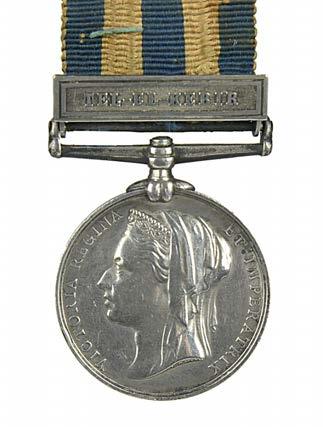


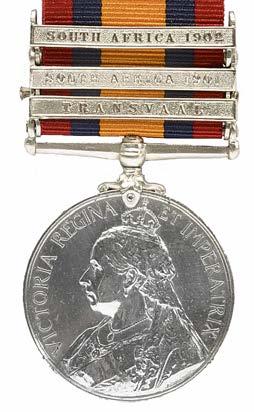
27
Three Egypt and Sudan Medals 188289: the first to Gunner J. Shaw, Royal Artillery, dated reverse, clasp: TelElKebir (32935, GUNR. J. SHAW, A/1. BDE. R.A), bruise to obverse rim at 8 o’clock, otherwise very fine or better; the next to Private William Ringer, 2nd Battalion Scots Guards, undated reverse, clasp: Suakin 1885 (5697. PTE. W. RINGER. 2/SCOTS. GDS.), very fine; the last to Private J. E. Bell, Medical Staff Corps, undated reverse, clasp: Suakin 1885 (5419. PTE. J. E. BELL. M.S. CORPS), very fine or better [3]
£200300
28
An India Medal 18951902 to a Sapper of the (Queen’s Own) Madras Sappers and Miners, 4 clasps: Punjab Frontier 189798, Samana 1897, Tirah 189798, Relief of Chitra 1895 (508 Sapper [name unclear] No 4 Coy Q.O. Madras S&M), very fine.
Notes: Clasp entitlement not verified.
£150200
29
An East and West Africa Medal 18871900 to Private J. Osborne, 1st Battalion West India Regiment, 5 clasps: 18878, 1892, 189394, 189798, Sierra Leone 189899 (2808. PTE. J. OSBORNE. 1/W.I.RGT.), engraved in serif capitals, lacks ribbon, good very fine or better
Notes: Entitlement can only be confirmed for the first two clasps. £200250
A Queen’s South Africa Medal 18991902 to Private T. Newcombe, 1st Battalion Devonshire Regiment, second type reverse, 3 clasps: Transvaal, South Africa 1901, South Africa 1902 (5439 PTE T. NEWCOMBE. DEVON: REGT), mounted in a glazed frame by Spink & Son Ltd., very fine.
£70100

31
An Ashanti Medal 1900 to Private Lawani Kafi, Lagos Battalion West Africa Frontier Force, first type obverse, clasp: Kumassi (282 PTE LAWANI KAFI. LAGOS BTN: W.A.F.F.), good very fine or better
£300400
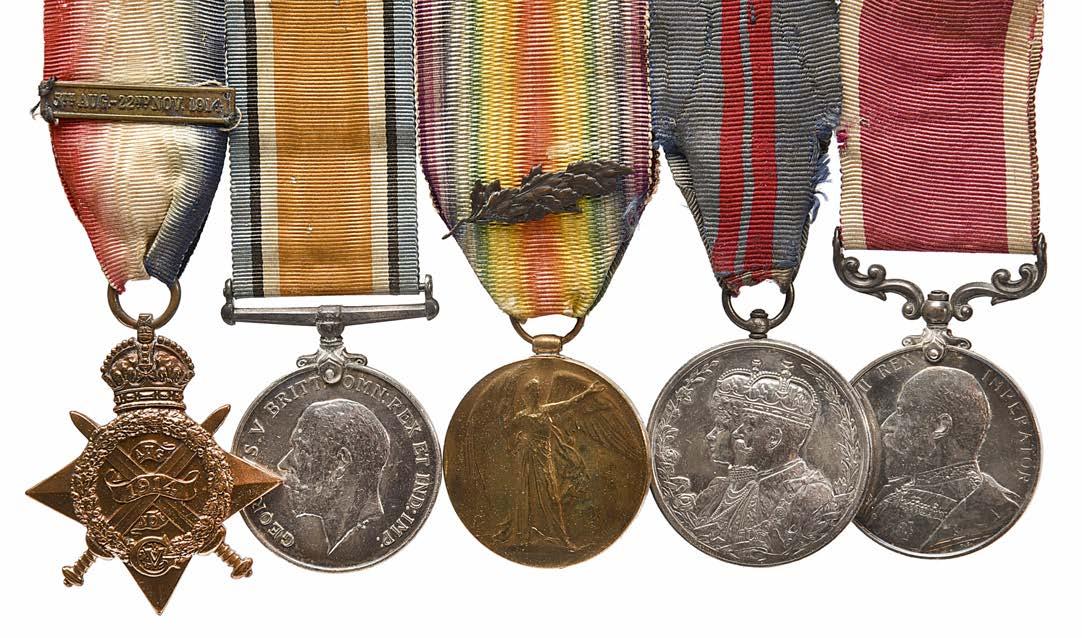
Five medals to Driver Henry Wood, Royal Field Artillery: 1914 Star, with clasp (93511 DVR: H. WOOD. R.F.A.); British War Medal 191420 and Victory Medal (93511 DVR. H. WOOD. R.A.); Delhi Durbar Medal 1911, silver (DR. H. WOODS. 25TH BTY: R.F.A.), privately engraved in serif capitals; Army Long Service and Good Conduct Medal, Edward VII (93511 DVR: H. WOOD. R.F.A.); mounted for wearing, good very fine or better [5]
Notes: Awarded the LSGC Medal in 1911. Stationed in India and confirmed for the award of the Delhi Durbar medal of that year. Entered France and Flanders on the 6th of October 1914. Mentioned in a despatch of Sir Douglas Haig of the 9th April 1917 (London Gazette 18/05/1917)
£200300

33
Four medal to Driver Wilfred H. Robins, Royal Artillery: British War Medal 191420 and Victory Medal (329030 DVR. W. H. ROBINS. R.A.); Territorial Force War Medal 191419 (91 DVR. W. H. ROBINS. R.A.); Territorial Efficiency Medal, George V (329030 DVR. W. ROBINS. R.G.A.), very fine [4]; in a contemporary looking oak frame with Devonshire R.G.A. shoulder titles, and R.A. buttons.
Notes: Served with the Devonshire R.G.A. (T.F.) and 159 Heavy Battery £150250
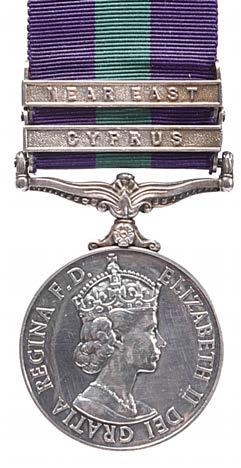
A highly desirable Suez Crisis El Gamil airborne operations General Service Medal 191862 to Private Joseph Charles Selby, 3rd Battalion Parachute Regiment, Elizabeth II, 2 clasps: Cyprus, Near East (23197514 PTE. J. SELBY. PARA.), nearly extremely fine; with envelope of issue.
Notes: Joseph Charles Selby enlisted on the 10th of November 1955 and passed parachute training on the 30th of January 1956 before joining the 3rd Battalion of the Parachute Regiment. Posted to Cyprus he returned to the UK on 16 Aug 1956 for refresher parachute training before taking part in the last operational parachute drop carried out by the British army when six hundred men of 3 PARA parachuted onto El Gamil airfield as the first wave of Operation MUSKETEER and captured it from the Egyptians on the 5th of November 1956. Offered with a copy of the recipient’s service record confirming the aforementioned details.
£1,4001,600

A small collection of honour insignia and similar items, comprising: a Knight Batchelor’s badge, silvergilt and enamel, in Royal Mint case of issue, London 1937, extremely fine or nearly so; The Most Honourable Order of the Bath, civil division, a companion’s neck badge (C.B.), silvergilt, by Garrard and in the maker’s case of issue, London 1919, much loss to gilding, otherwise extremely fine; The Most Distinguished Order of St Michael and St George, a companion’s neck badge (C.M.G.), silvergilt and enamel, in Garrard’s case of issue, about extremely fine; Jubilee Medal 1935 and Coronation Medal 1937, unnamed as issued and accompanied by a dress miniature for the latter; a ceremonial key, Astley Bridge Parochial Hall, silvergilt, the ornate bow formed as a crowned shield supported by acanthus scrolls, inscribed ‘PRESENTED TO THE RIGHT REV. LORD BISHOP OF MANCHESTER FEB. 22ND 1915’, in case of issue, Marples & Beasley, Birmingham 1912; and another presentation key, Lybster H. G. School 24th March 1937, silvergilt, stepped bow engraved ‘J. W. PECK ESQ. C.B.’, in case of issue, James Fenton, Birmingham 1936. [8]
£300500
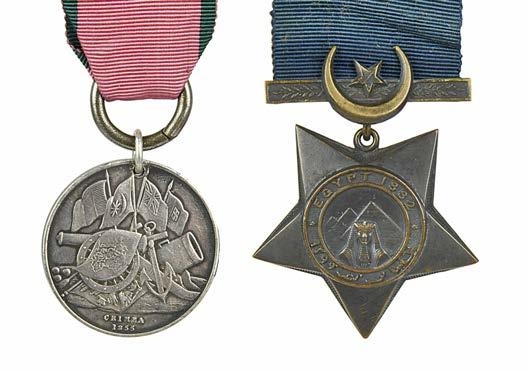
37
A Turkish Crimea Medal, Sardinian type, privately impressed (7694. J. MURDEN. 3. BN. G. GDS.)*, replacement foliate suspension, fine; together with another, British type, unnamed as issued, good fine; and a Khedive’s Star 1882, unnamed as issued, good very fine; also with a small quantity of mainly British medals and insignia, including: 193945 War Medals (5), a Defence Medal, a W.V.S. Civil Defence lapel badge, a pair of RFA shoulder titles, various cap badges, and other items. [qty]
Notes: * Private John Murden, also entitled to the British medal with clasp for Sebastopol.
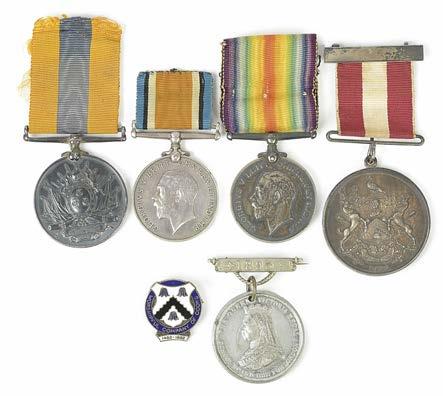
36
A collection of campaign medals and similar items, comprising: A Khedive’s Sudan Medal 18961908, no clasp (3551 Sepoy Said Nazir 26th Bl. Infy.), good very fine and toned; two British War Medals 191420, (73258 PTE. H. E. EDWARDS. R. W. FUS.), (42432 PTE. H. E. WOODS. HAMPS. R.), each about very fine; The Worshipful Company of Cooks: a silver Livery Badge, company arms, reverse engraved , extremely fine; an associated lapel badge, silver and enamels; and a white metal school attendance medal for 1893. [6]
Warshipful Co Cooks x2 plus School medal [3]
£150250
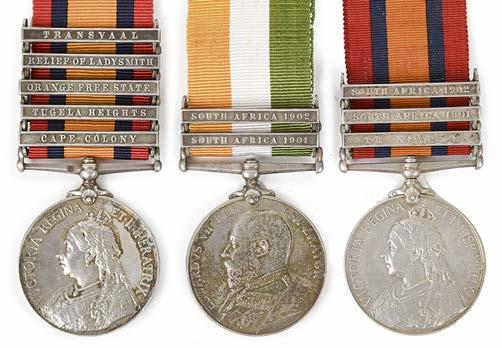
£150200 38
2nd AngloBoer War: a pair of medals to Private J. Smith, Royal Fusiliers: Queen’ South Africa, 2nd type reverse, 5 clasps: Cape Colony, Tugela Heights, Orange Free State, Relief of Ladysmith, Transvaal (3621 PTE J. SMITH, 2ND RL: FUS:); King’s South Africa with both dated clasps (3621 PTE G. SMITH. RL: FUSILIERS.), inconsistent initial also on roll; together with a Queen’s South Africa Medal to Private P. Prescott, Rifle Brigade, 3 clasps: Transvaal, South Africa 1901, South Africa 1902 (7381 PTE P. PRESCOTT. RIFLE BRIGADE); all about very fine or a little better. [3]
£150250
A Royal Navy Long Service and Good Conduct Medal to Carpenter Benjamin James Bond, H.M. Coastguard, Edward VII (158270 B. J. BOND, DIV. CARPR.. H.M. COAST GUARD.), nearly extremely fine and toned; together with the Memorial Plaque issued in respect of this man’s brother (WILLIAM CHARLES BOND); also a Silver War Badge issued to 19612 Private Leonard Haswell, Hampshire Regiment. [3]
Notes: Benjamin James Bond was born in Portsmouth in 1868 and enlisted in the Royal Navy in 1890. After a number of seagoing and shore postings he concluded his career in various Coastguard stations in Scotland. His L.S.G.C. Medal was awarded in 1906. His Brother William Charles Bond was Chief Sickberth Steward in H.M.H.S. Plassy when he died of acute gastritis in August 1916. He had been in the Plassy since the start of the war and was almost certainly on duty during the Battle of Jutland when his ship took on casualties from the battlecruisers Lion and Princess Royal.
£150
200

40
A collection of Great War campaign medals, comprising: a trio of 1914 Star, British War Medal and Victory Medal (30306 SJT E. J. LACEY. R.F.A.)*, good very fine or better; four 191415 Stars (16194 PTE S. J. SHUTE. DEVON: R., S7874 PTE T. GREEN. RIF: BRIG:, LIEUT. A. M. ROOME. R.A.M.C., SE4083 PTE. G. FIELDEN. A.V.C.); a British War Medal 191420 (J. 82350 S. E. RILEY. ORD. R.N.); three Victory Medals (60613 GNR. M. COOKSON. R.A., 35933 PTE. F. W. GODFREY. THE QUEEN’S R., 906 DVR. GHULAM. MOHD. 14 M.C.); and an alloy commemorative medal, 1919; varying grades. [12]
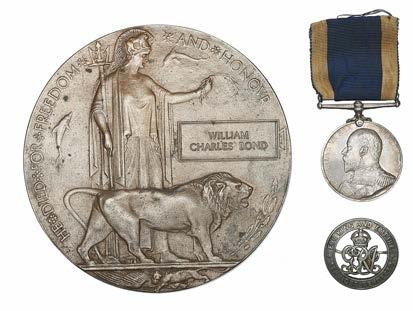
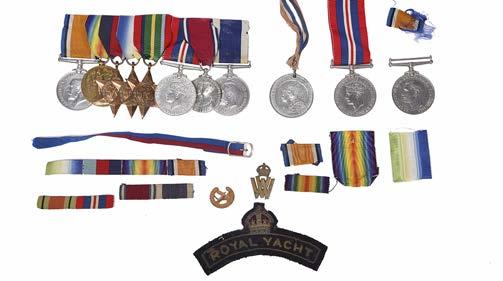
Notes: *Sergeant Ernest James Lacey, R.F.A., entered France and Flanders 16/08/1914. Discharged 17/05/1915 and entitled to a silver war badge. Died 23/03/1919 and buried at Nunhead Cemetary. £80120 41
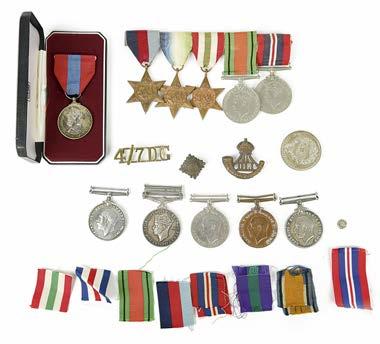
42
A quantity of medals, comprising: I.S.M. (DONALD TAPLIN), cased, extremely fine; British War Medal 191420 (37524 PTE. W. R. KING. GLOUC. R.), very fine; a pair: British War Medal 191420 and Mercantile Marine War Medal (SIDNEY A. KIMBER), near very fine; a mounted group of five: 193945 Star, Atlantic Star, Italy Star, Defence and War Medals, unnamed as issued, very fine; a General Service Medal 191862, clasp: Palestine 194548 (14453392 TPR. P. KING. 4/7 D.G.), very fine; and a small quantity of insignia and other items. [qty]
£150200
A group of eight medals named or attributed to Alfred William Archibald Penfold, Royal Marines: British War Medal 191420 and Victory Medal (R.M.A. 14919 GR. A.W.A. PENFOLD.); 193945 Star; Atlantic Star; Pacific Star; War Medal 193945; Jubilee Medal 1935; Royal Navy Long Service and Good Conduct Medal, George V (PO. 2 14919 A,W.A. PENFOLD, MNE. R.M.); mounted for wearing, all about very fine, [8]; together with an Admiralty medal slip 193945 endorsed for 4 awards, a Royal Yacht fabric shoulder title, a loose War Medal 193945, and other items.
Notes: The recipient was born in Frimley on the 19th of November 1897. He worked as a postman before enlisting in the Royal Navy on the 4th of April 1916, serving in the Royal Marine Artillery and later in the SuperDreadnought H.M.S. Canada. He reengaged in October 1927 and his Long Service and Good Conduct medal was issued in 1931. He twice served in the Royal Yacht Victoria & Albert in the interwar years. During WWII he was assigned to the administrative establishment H.M.S. President III, indicating probable service as a gunner in a Defensively Armed Merchant Ship.
£150250

43
A small collection of medals, including: India General Service 194995, clasp: Burma 18857 (4792 Pte. W. Wilkes. 1st.. Battn. Rifle Brigade.), engraved in cursive script, contact marks to rim, otherwise very fine; a renamed and unofficially awarded King’s South Africa Medal, both dated clasps (195. BOMB. H. VOORSANGER. 18TH BATT. R.F.A.), reengraved in plain capitals, good fine; a France and Germany Star, unnamed as issued; and other items. [qty]
Notes: Private William Wilkes was also entitled to the Burma 18871889 clasp. Bombardier Voorsanger was entitled to the QSA with clasps: Belmont, Modder River, Paardeberg and Johannesburg. His entitlement to a KSA is unconfirmed.
£150250
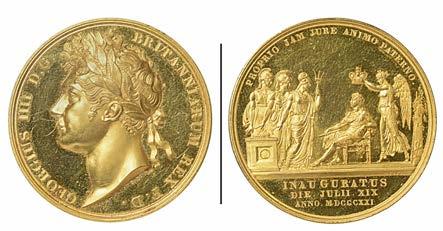
45
The Fall and the Crucifixion, a cast silver medal by Hans Reinhart (fl. 153568), Adam and Eve taking apples from the Tree of Knowledge, legend in field ‘MVLIER. DE DIT MIHI. ET. COMEDI. GE. Z.’, the tree with applied foliage; rev. Christ Crucified, legend in field ‘MIS ERERE. NO BIS. DOMI NE’, circa 1536, 56 mm, good very fine or better
£1,0001,500
44
Coronation of George IV 1821, a gold medal by Benedetto Pistrucci, laureate head left; rev. the King seated left, crowned by Victory, and with Britannia, Hibernia and Scotia in attendance, legend in exergue; in its maroon leather case, 35 mm (E 1146a), some hairlining and light surface marks, otherwise good extremely fine.
£2,0003,000
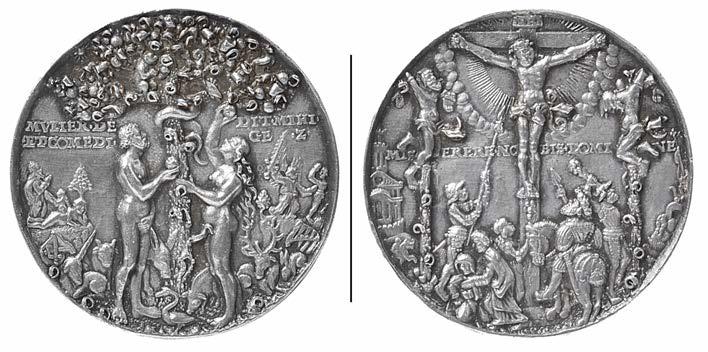
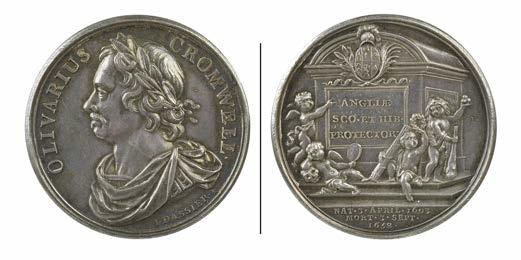
47
Charles II, a silver presentation medal by J. Roettier, c. 1683, armoured and draped bust right, rev. arms with supporters and crest, in a tooled and gilt leather case, 53 mm (E 267), about extremely fine and toned.
£400600
46
Oliver Cromwell, memorial 1658, a silver medal by Jean Dassier, laureate armoured bust left, rev. a decorated monument, ex. birth and death dates, struck in 1731 as part of Dassier’s English kings and queens series, 38 mm (E 203), extremely fine and toned.
£150250
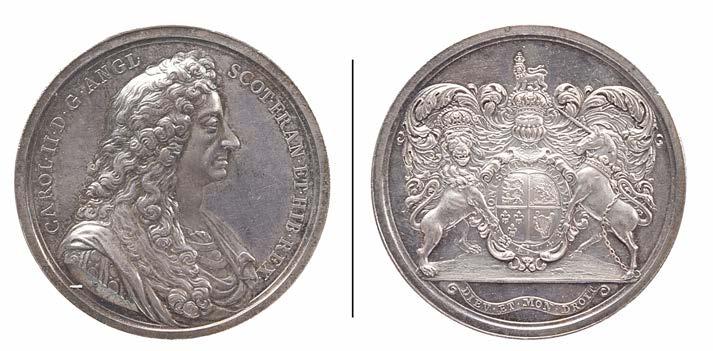
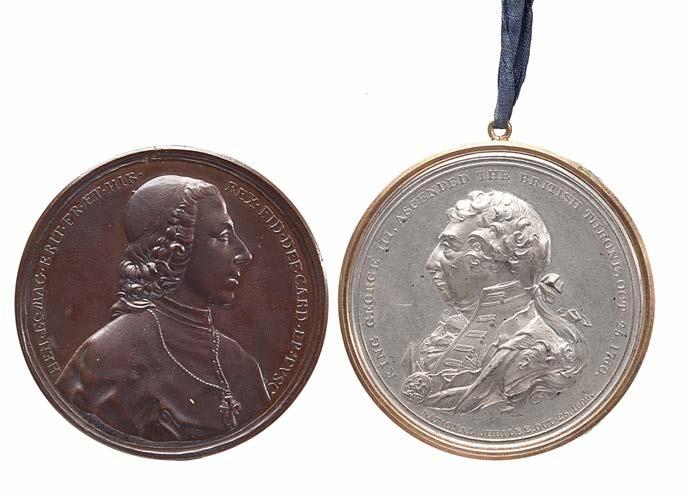
49
Nuremberg Leopold II, coronation as Holy Roman Emperor 1790, a silver medal by Johann Peter Werner, bust right, LEOPOLDUS. II. D. G. ROM. IMP. SEMP. AUG.; rev. Imperial regalia on a plinth, SALUTIFER ORBI VENIT.; ex. CORONATUS MENSE OCTOB: 1790., 45 mm, extremely fine and scarce.
£300500
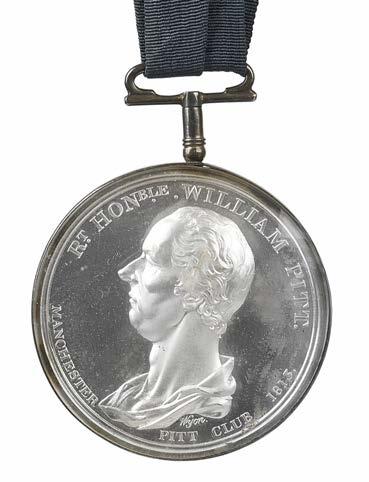
51
Pharmaceutical Society of Great Britain 1852, a silver prize medal by L. C. Wyon, Galen and Avicenna supporting a tablet with the motto ‘HABENDA RATIO VALETUDINIS’, rev. text in seven lines within a wreath, edged impressed to Clement John Wain (CLEMENT JOHN WAIN MATERIA MEDICA. SESSION 188889.), 70 mm (E 1472), extremely fine or better and attractively toned; with an elaborate giltgesso and velvet fitted glazed presentation frame.
Notes: Registered as Chemist & Druggist on 22 Feb 1889. Awarded Materia Medica Silver Medal in 1890. Alderman and prominent businessman in Newcastle for many years. Offered with copy research.
£50150
48
Death of Prince Charles 1788, a copper medal by G Hamerani, bust right in clerical cap and robes, rev. Religion standing with a cross, St Peter’s Basillica beyond, 53 mm (E 823), struck from slightly rusted dies, extremely fine or nearly so; together with: National Jubilee 1809, a white metal medal by W. Wyon, uniformed bust of George III left, rev. Victory below a radiant sun, in a gilt metal mount with suspension loop, 54 mm including mount, some corrosion to the reverse, otherwise very fine, obverse better. [2]
£200300
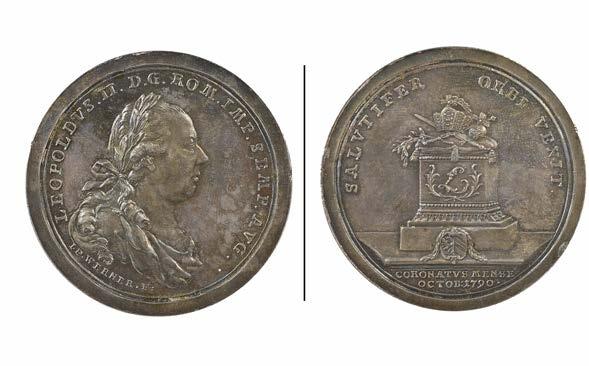
Manchester Pitt Club: a silver medal by Wyon, 50 mm, bust of William Pitt left, ‘RT. HONBLE. WILLIAM PITT.’, ‘MANCHESTER PITT CLUB 1813’, rev. Pitt in allegory defending Britain from anarchy, ex. ‘HIMSELF AN HOST’, frosted and set between glass lunettes in a silver frame with a watchtype suspension loop on a blue ribbon (E 1039), extremely fine or better
£150250
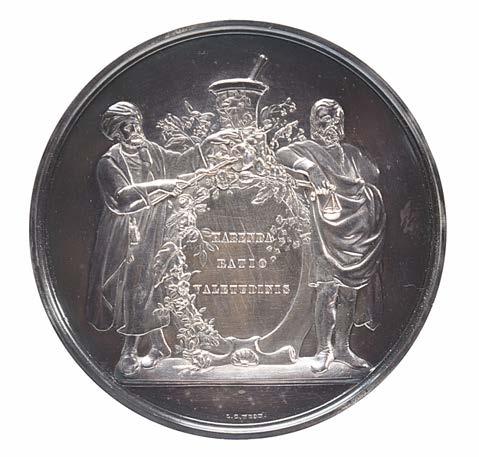
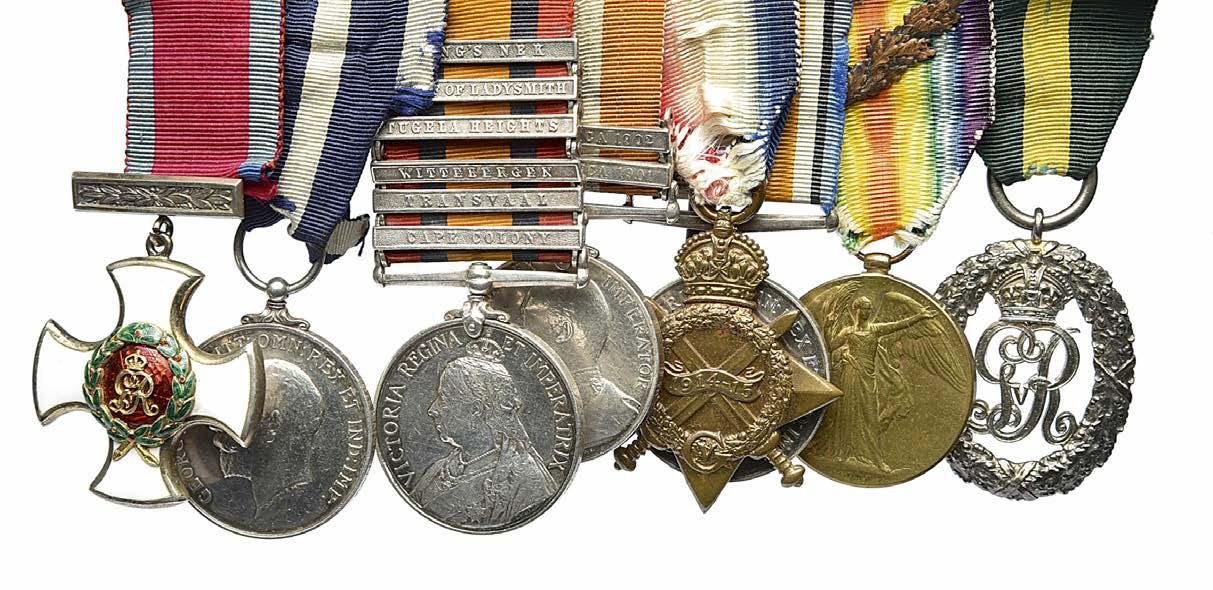
52
The DSO and King’s Police Medal group to Lieutenant Colonel William Henry Wyndham Murphy DSO, Leinster Regiment, London Regiment and Zanzibar Police: Distinguished Service Order, George V, light scuffing to enamel and wear to gilding; King’s Police Medal, George V 1st type (LT COL. WILLIAM H.W. MURPHY, D.S.O., COMMDT. ZANZIBAR POLICE.), engraved in serif capitals; Queen’s South Africa Medal, 2nd reverse, 6 clasps: Cape Colony, Transvaal, Wittebergen, Tugela Heights, Relief of Ladysmith, Laing’s Nek (Lieut. W.H. MURPHY. Leins. Rgt.), engraved; King’s South Africa Medal, 2 dated clasps (LIEUT: W.H. MURPHY. LEINSTER REGT), impressed in plain capitals; 191415 Star (unnamed); British War Medal 191420 and Victory Medal with oak leaf emblem (LT. COL. W. H. MURPHY.); Territorial Decoration, George V; mounted for wearing, all about very fine or nearly so, ribbons worn and frail in places, mounting with loose elements [8]; together with an associated photograph and an associated watercolour of an officer of the Leinster Regiment.
Provenance: The Paul Morrissey Collection
Notes: D.S.O. L.G.: 18/02/1918 & 18/07/1918
K.P.M. L.G.: 31/12/1927
Lt. Col. Murphy was first commissioned 2nd Lieutenant in the Leinster Regiment on the 19th May 1900, having previously served as a Lance Sergeant in Thorneycroft’s Mounted Infantry. He was promoted Lieutenant 22nd March 1902, and by 1909 was in the Reserve of Officers and employed in the Bechuanaland Protectorate Police. He served in the Great War with the 18th Battalion the London Regiment, earning the D.S.O. as a Major, and ending the war as a Lieutenant Colonel. His Territorial Decoration was gazetted on the 27th May 1919. He returned to colonial service after the war his Medal Index Card giving his address as C/O Tanganyika Administration Darussalam. He was awarded the King’s Police Medal in 1927.
The deeds for which Murphy was awarded the D.S.O. took place in the Bourlon Salient in November and December 1917, during the Battle of Cambrai; at which time he was in command of his regiment, having taken over in April when Lt. Col D.B. Parry D.S.O. was admitted to hospital sick: “..he reconnoitered the whole of the position and was continually in the front line...on the occasion of an attack he successfully led his battalion at very short notice and in darkness. Later, he directed the withdrawal with remarkable skill, and on another occasion, when the outpost line held by his battalion was was attacked in large force.....he reestablished the line of posts....maintaining them until relieved. He displayed magnificent courage, leadership and ability...”
The recommendation for his King’s Police Medal states that he “Successfully reorganised the force and made it efficient [and] was instrumental in breaking up dacoity gangs which had persisted for many years”
£1,8002,200
53
The Military Cross to fatal casualty Captain John Harold Standrick, 2nd/18th Battalion London Regiment (London Irish Rifles): M.C. George V, reverse privately engraved “CAPTAIN J.H. STANDRICK M.C. 2/18
LONDON IRISH RIFLES. FOR CONSPICUOUS GALLANTRY AND GOOD LEADERSHIP ON THE FIELD. GAZA. Novr 1917. DIED OF WOUNDS FEB. 21ST 1918 AGED 25 YRS”, about extremely fine; together with the Memorial Plaque and Memorial Scroll issued in commemoration of this officer’s sacrifice; mounted and framed with a replica Great War pair and award details; also a good archive of original documents principally comprising many letters of condolence to this officer’s parents, as well as the P.O. telegram informing them of his death.
Provenance: The Paul Morrissey Collection.
Notes: M.C. London Gazette 18/02/1918 and 18/07/1918 (citation).
“...It was due to his skill and ability...that the success of the operations against the enemy defence line was so marked. His task was one of great responsibility, as his company was the directing pivot...for the final assault.....he showed exceptional skill..and a complete indifference to danger.” This deed took place during the successful assault on the Kauwaukah defences, 6th November 1918. Offered with research.
£400600
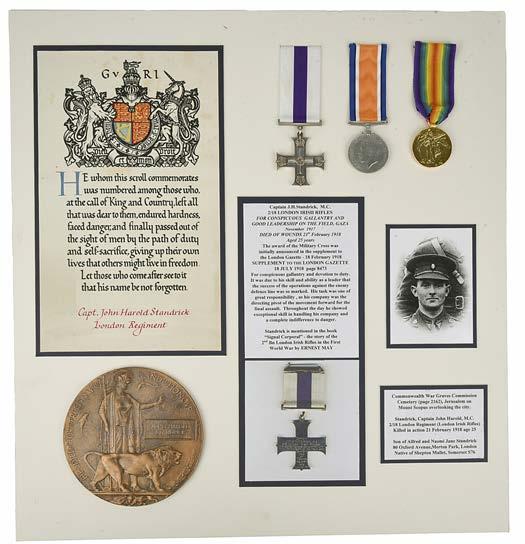
54
A Great War M.M. group to Sergeant Walter MacFarlane, 18th Battalion London Regiment: Military Medal, George V (2166 L.SJT: W.W. MACFARLANE. 18/LOND:R. T.F.); 191415 Star (2166. PTE. W. W. MACFARLANE, 18LOND. R.); British War Medal 191420 and Victory Medal (2166 SJT. W. W. MACFARLANE. 18LOND.R.); later mounted for wearing, good very fine. [4]
Provenance: The Paul Morrissey Collection
£200300
55
The M.M. to fatal casualty Lance Sergeant Frederick Thomas Vinson, 18th Battalion London Regiment, Military Medal, George V (1828 L. SJT: F. T. VINSON. 18/LOND: R. T.F.), extremely fine, some toning.
Provenance: The Paul Morrissey Collection
Notes: Frederick Vinson was killed in action on the 15th of September 1916, the day after his M.M. had been gazetted. He had been in theatre in France since the 9th of March 1915.
£150200
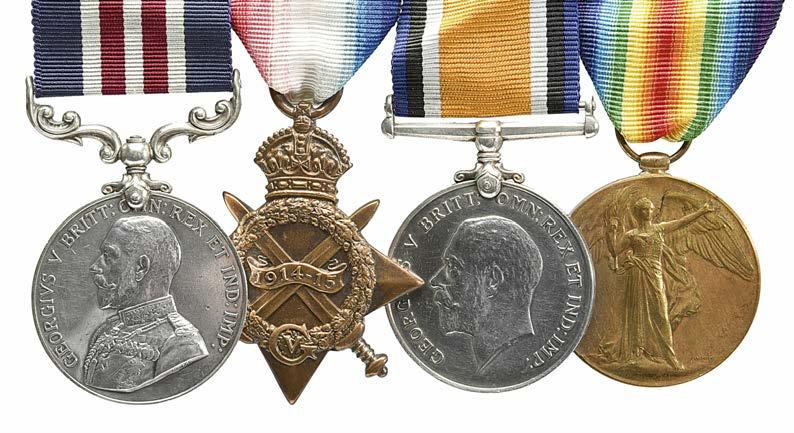
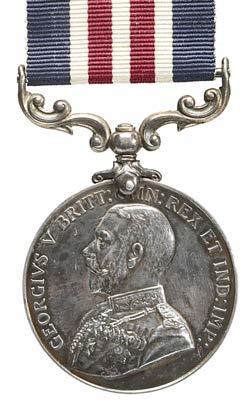
56
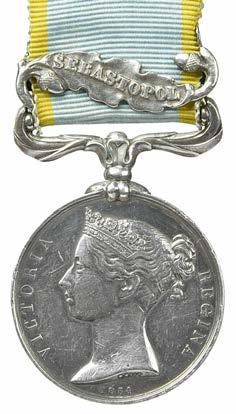

A Crimea Medal 195456 to Captain of the Mizzen Top Henry Palmer, Royal Navy, clasp: Sebastopol (HY PALMER, CAPTN MZN TOP HMS ALGIERS 1856), engraved in serif capitals, near very fine
Provenance: The Paul Morrissey Collection
Notes: Born in Town Malling, Kent, in 1824. Served as an Ordinary Seaman in HMS Trafalgar from June 1846. Subsequently served in HMS Southampton, Highflyer and Maeander. Served in HMS Algiers May 1854 to February 1856, becoming a Leading Seaman 11/06/54 and Captain of the Mizzen Tops 17/07/55. The first medal that Paul Morrissey acquired.
£100150
57
A Queen’s South Africa Medal 18991902 to Trooper John Howard Taylor, Imperial Yeomanry, second type, clasp: Cape Colony (34500 TPR J. H. TAYLOR. 89TH COY IMP. YEO.), good very fine; together with a 191415 Star trio to J.H. Taylor, South African Field Telegraph and Postal Corps and 2nd South African Infantry believed to the the same man, very fine [4]; offered with research.
Provenance: The Paul Morrissey Collection £150250
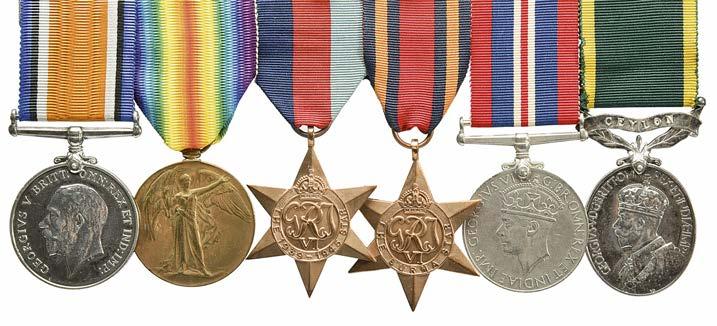
58
Six medals named or atttributed to Private Eric Walsh, 18th Battalion London Rifles and Ceylon Planters Rifle Corps: British War Medal 191420 and Victory Medal (590893 PTE. E. WALSH. 18LOND. R.), 193945 Star, Burma Star, British War Medal 193945; Efficiency Medal, George V, Ceylon (RFM E. L. WALSH. C.P.R.C.), engraved; later mounted for wearing, all about very fine. [6]
Provenance: The Paul Morrissey Collection £200300
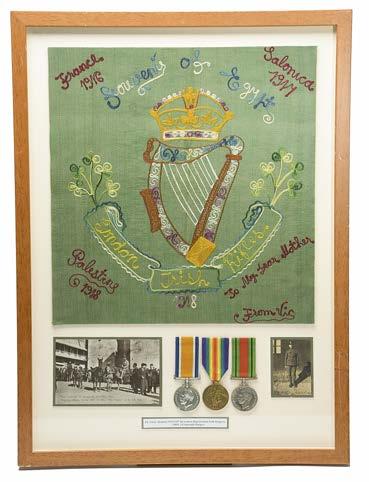
59
A collection of display mounted medal groups, comprising: the Great War pair and Memorial Plaque to Lieutenant Stanley Muir Toms, London Regiment, in a glazed frame with associated ephemera; two 191415 Star trios (Privates Percy James Waterman and Walter Waterman, both 18th London Regiment) together with a Second World War group (193945 Star, France and Germany Star, Defence Medal and War Medal) attributed to Corporal John Francis Waterman 13th/18th Hussars, mounted together in an unglazed frame; a Great War pair and Defence Medal (3199 PTE. V. ABSOLOM. 18LOND. R.), in a glazed frame with an L.I.R. woolwork souvenir; and seven medals named or attributed to Patrick McKenna, Royal Engineers and London Irish Rifles: 193945 Star, Africa Star with 1st Army clasp, Italy Star, France and Germany Star, Defence Medal, War Medal 193945, Efficiency Medal and bar, Territorial, Elizabeth II (2197956 RFN. P. McKENNA. L.I.R.), in an unglazed frame with associated badges; offered with some research for Lieutenant Toms and the Watermans. [qty]
Provenance: The Paul Morrissey Collection £150200
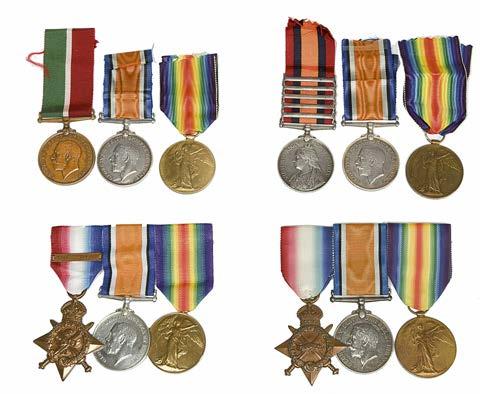
60
Five Medal groups, viz.: three medal to Archibald N. Crofts, Royal Navy: British War Medal 191420 (J. 64966 A.N. CROFTS. A.B. R.N.), good very fine; Mercantile Marine War Medal (ARCHIBALD N. CROFTS), good very fine; Victory Medal (J. 64966 A.N. CROFTS. A.B. R.N.), light corrosion to edges, otherwise good very fine; three medals to Corporal William Baker, Imperial Yeomanry and Army Service Corps: Queen’s South Africa, 2nd type reverse, 5 clasps: Cape Colony, Orange Free State,
Transvaal, South Africa 1901, South Africa 1902 (34447 PTE W. BAKER. 95TH COY IMP: YEO:), impressed; British War Medal 191420, Victory Medal (M2 131997 A. CPL. W. BAKER. A.S.C.), all good very fine or better; a Great War trio to Lieutenant Sidney England Charlton, Honourable Artillery Company, 18th London Regiment and Machine Gun Corps: 1914 Star, with good tailor’s copy clasp (662 PTE. S.E. CHARLTON. H.A.C.), British War Medal 191420 and Victory Medal (LIEUT. S.E. CHARLTON), later mounted on modern ribbons, very fine or better; and a Great War trio to Lance Corporal Harry Nieuwoudt, South African Irish Regiment and 4th South African Infantry: 191415 Star (PTE H. NIEUWOUDT S.A. IRISH RGT.); British War Medal 191420 (L/CPL H. NIEUWOUDT. 4TH S.A.I.); Victory Medal, bilingual reverse (PTE H. NIEUWOUDT. 4TH S.A.I.); very fine or better. [qty]
Provenance: The Paul Morrissey Collection
Notes: William Baker was born St Martins, London, in 1872, and attested for the Imperial Yeomanry in March 1901, having previously served in the 3rd Volunteer Battalion Royal Fusiliers. He served with the 95th Company (Metropolitan Mounted Rifles), and was discharged at Shorncliffe, as medically unfit, in April 1902. He married Myra Emma, a widow, in 1906, and together they had two children. He reenlisted in the Army Service Corps in October 1915; Sidney Charlton was born in Epsom 12/02/1893. Attested for the H.A.C. 18/09/1911 and, being mobilized on the outbreak of war, entered France with the 1st Battalion in September 1914. His battalion was under fire in the period from late September until 27/11/1914; and it seems certain that he was entitled to a clasp for his 1914 Star, though he does not appear to have applied for it officially. He was discharged to a commission in the 3rd/18th Battalion London Regiment (London Irish Rifles) 06/06/1915; Harry Nieuwoudt served on the Western Front, suffering various wounds. Repeatedly subject to disciplinary measures for such infractions as being “unshaven at 11. a.m.”, and “Using threatening language to his superior officers.”
£200300
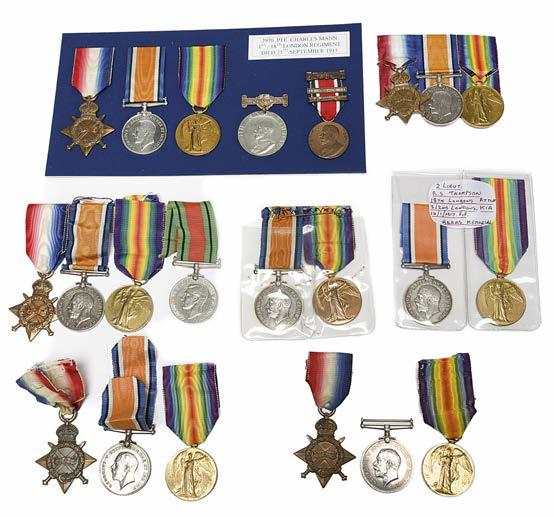
61
A collection of Great War campaign medals, as follows: a trio comprising 191415 Star, British War Medal 191420 and Victory Medal (2582. PTE. F. J. ADAMS, 18LOND.R.); another such trio (2970. PTE. C. MANN. 18LOND. R.), with two associated school attendance medals; another trio (3339, PTE. G. MILLINGTON. 18LOND.R.); another trio (1944 CPL. H. E. READ, 18THLOND. R. / 1944 W.O. CL. 2. H. E. READ. 18LOND.R.); a 19145 Star trio and Defence Medal (1999 PTE. T. G. CROWE. 18LOND. R.); a pair comprising British War Medal 191420 and Victory Medal (593171 PTE. I. E. BUNNETT. 18LOND. R.); and another pair (2. LIEUT. R. S. THOMPSON.); all but the last offered with research. [qty]
Provenance: The Paul Morrissey Collection
Notes: Private Frederick James Adams was killed in action on the 25th of September 1915, as was Private Charles Mann; and Private Thomas George Crowe sustained a gunshot wound to the right arm on the same day and was later discharged and received a Silver War Badge. Private George Albert Millington was killed at High Wood on the 19th of September 1916. 2nd Lieutenant R. S. Thomson, 18th London Regiment, was killed in action on the 16th of January 1916 while attached to the 2/2nd London Regiment.
£150200

62
A collection of British and Commonwealth Second World War campaign medals, some offered with attributions and research, some associated with the London Irish Rifles and related units; and other items. [qty]
Provenance: The Paul Morrissey Collection £150200
63
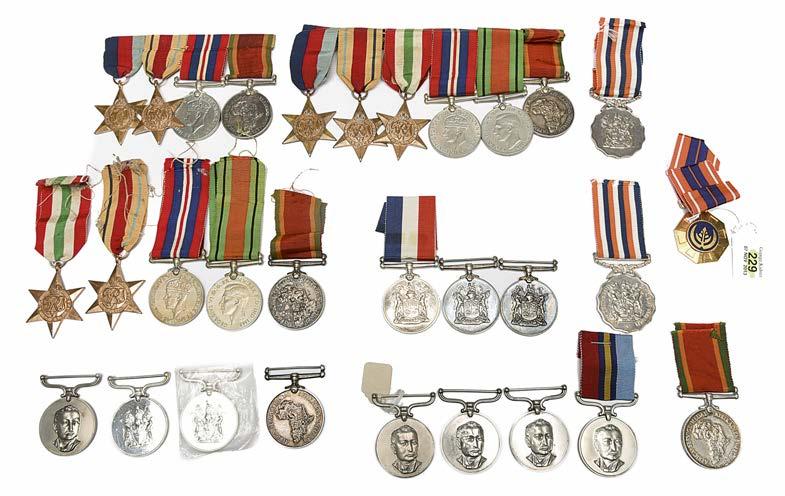
not to scale not to scale
A collection of South African Medals, comprising: a mounted group of six: 193945 Star, Africa Star, Italy Star, War Medal 193945, Defence Medal, Africa Service Medal 193945 (83528 J. FRASER); a mounted group of four: 193945 Star, Africa Star, War Medal 193945, Africa Service Medal 193945 (3216 A. C. O’BRIEN); a group of five: Africa Star, Italy Star, Defence Medal, War Medal 193945, Africa Service Medal 193945 (30146 T. FLINT); three pairs of War Medal and Africa Service Medal 193945, with copy research (M10923 I. DANIELS / 143997 G. L. LANGRIDGE / 140830 J. C. DAVIDSON); two single Africa Service Medals, with copy research (543271 J. S. FOURIE / C301753 E. PULLEN); two further Africa Service Medals (N3661 D. DUBE / 115390 G. VAN DER MERWE); three South African Medals for War Service 193946, unnamed as issued; four Rhodesia General Service Medals (20747 CONST. MAFUKIDZE / PR21564 SPR. J. P. BERRY / 13844 D/CONST AMOS / PR5526 CPL. P. NEAUM); a Union Medal (92); a Permanent Force Good Service Medal (843); a Pro Patria Medal, link suspension (7964); and three various specimens medals; all at least very fine, Fourie’s medal with officially altered number [qty]
Provenance: The Paul Morrissey Collection £200300
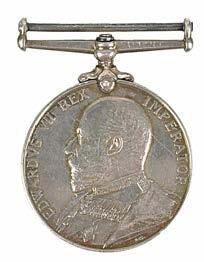

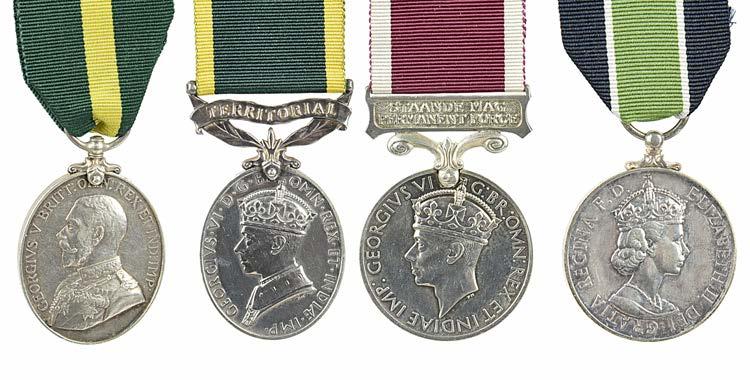
64
A collection of long service and good conduct awards, comprising: Volunteer Long Service Medal, Edward VII (3555 PTE. R. SINDALL. 2ND V.B. ROYAL FUS:); Territorial Force Efficiency Medals (2), George V (590019 C. S. MJR: W. F. WILLIAMSON. 18/LOND:R. and 119 CPL. W. T. STUART. 18/LOND: REGT); Efficiency Medal (Territorial), George VI (7013353 RFMN. D. C. SIMPSON. LOND. IR. RIF. R. U. RIF.); South Africa Permanent Force Long Service and Good Conduct Medal, George VI(B) (NO. P. 3609 SGT. A. L. SMITH Q.S.C.), engraved; Colonial Police Long Service Medal, Elizabeth II (9877 AFR/CONST. ZIMENE, B.S.A.P.), officially renamed; good very fine and better, [6]; offered with some research.
Provenance: The Paul Morrissey Collection £150200
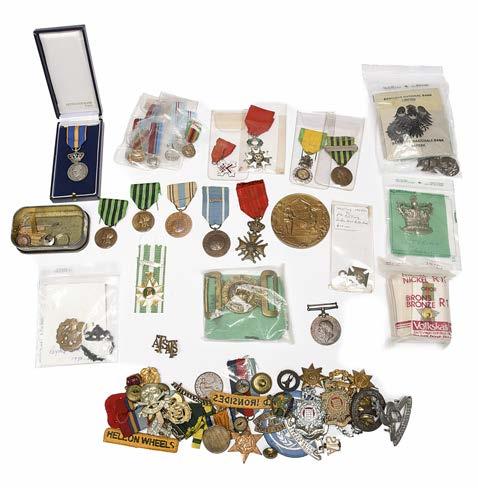
65
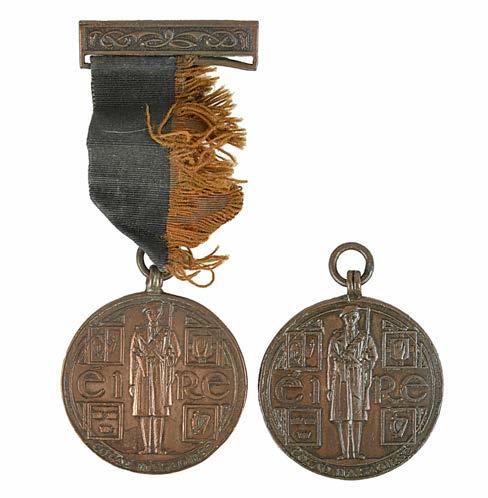
not to scale part, not to scale
A quantity of medals and badges, and associated militaria, including: a Belgian Croix de Guerre; various awards of the French Republic, including a Legion d’Honneur badge and an Engagé Volontaire medal; a South Vietnam Campaign Medal, with loose ribbon and 1960 clasp; British Army cap badges, various units; a South African 1st infantry brass shoulder title, and another ‘S.A.A.F. S.A.L.M.’; a London Irish Rifle Club medal (Aggregate 3rd won by Pth Cutting 1905); a small number of South African dress miniature medals; medal ribbons, a replica British War Medal 191420 in bronze, and other items. [qty]
Provenance: The Paul Morrissey Collection
£150200
66
Ireland Free State: General Service Medal 191721, noncombatant’s type, unnamed, with top ribbon brooch; and another, also unnamed, lacking ribbon and brooch; together with a collection of Emergency Service Medals 193946, comprising: Army/Air Corps/Navy issue (2), each with two clasps; Local Defence Force Issue (4); Volunteer Aid (Red Cross) issue; and Local Security Force Issue (2), each with one clasp; all with ribbons and top brooches, fine to very fine, much wear to ribbons. [11]
Provenance: The Paul Morrissey Collection
£200300

67
Charles II, gold five guineas, 1679, second laurelled bust, edge TRICESIMO PRIMO (S 3331, F 281), blemish around 3 o’clock to both sides and involving a deep pit to reverse, otherwise near very fine.
£3,0004,000

68
Charles II, gold two guineas, 1664, first bust with elephant below (S 3334), good very fine.
£4,0006,000
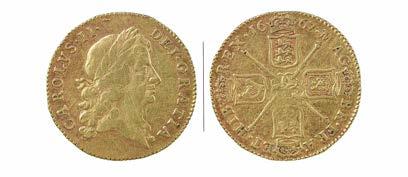
69
Charles II, gold guinea, 1667, third laurelled bust (S 3342), good fine.
£8001,200
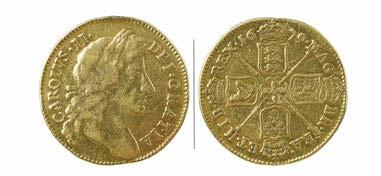
70
Charles II, gold guinea, 1679, fourth bust (S 3344, F 287), fine, reverse better.
£400500
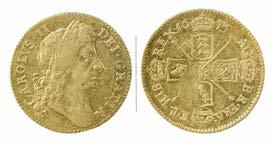

71
Charles II, gold guinea, 1680, fourth bust (S 3344), good fine,
£400500
72
Charles II, gold half guinea, 1673, second bust (S 3348, F 290), near very fine.
£300400
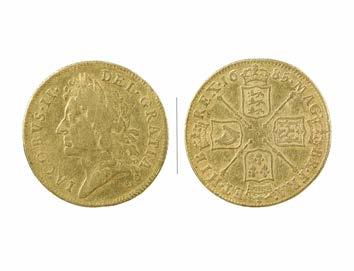
73
James II, gold guinea, 1685, first bust (S 3400, F 295), good fine or a little better.
£7001,000
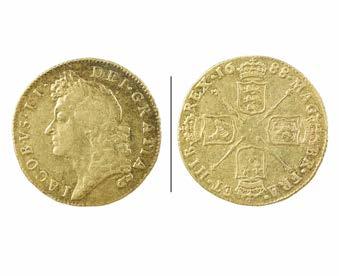
James II, gold guinea, 1688, second bust (S 3402, F 295), near very fine.
£7001,000
75

William and Mary, gold five guineas, 1694, conjoined busts, edge SEXTO (S 3422), about fine.
£3,0004,000
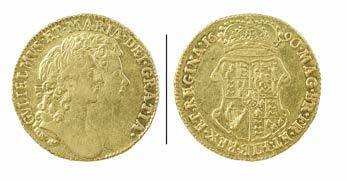
76
William and Mary, gold guinea, 1690 (S 3426), very fine or better
£1,2001,800
77
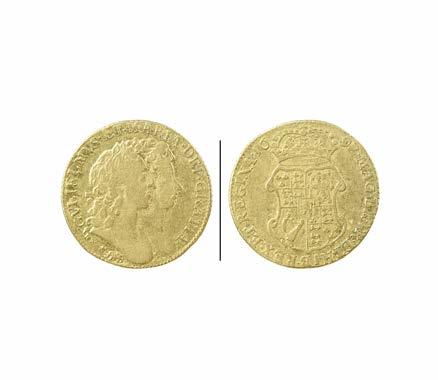
William and Mary, gold guinea, 1692, conjoined busts with elephant below (S 3428), fine or better
£8001,000
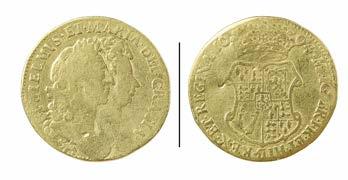
78
William and Mary, gold guinea, 1694, conjoined busts with elephant and castle below (S 3427), very slightly creased, near fine.
£7001,000

79
William III, gold guinea, 1698 (S 3460), some haymarking, otherwise very fine with some lustre.
£1,0001,500
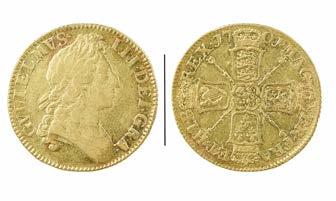
80
William III, gold guinea, 1701, second bust, rev. narrow crowns (S 3463), good fine or better, reverse better with some lustre.
£8001,200
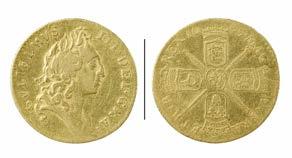
81
William III, gold half guinea, 1695 (S 3466), good fine.
£350450
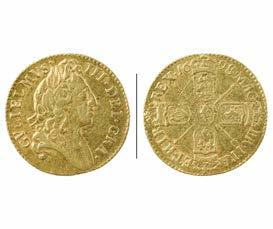
82
William III, gold half guinea, 1698 (S 3468), near very fine.
£400500
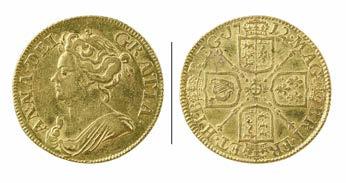
83
Anne, gold guinea, 1712 (S 3574), a few haymarks, near very fine.
£1,0001,500
86

1,000
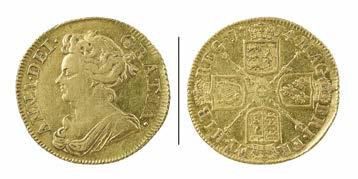
85
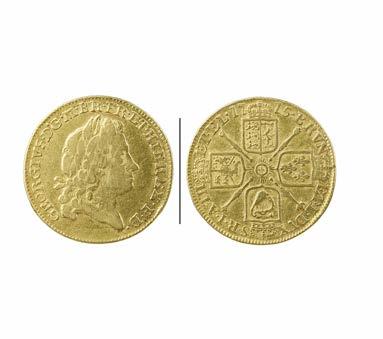
700
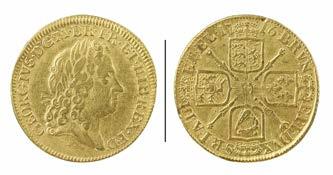
87
£7001,000
88
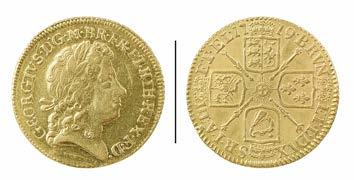

89
92
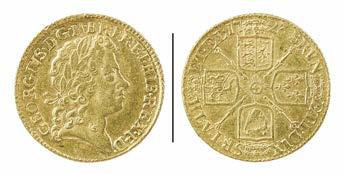

91
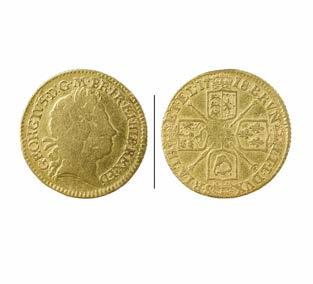

93
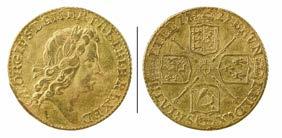
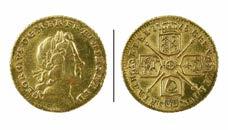
95
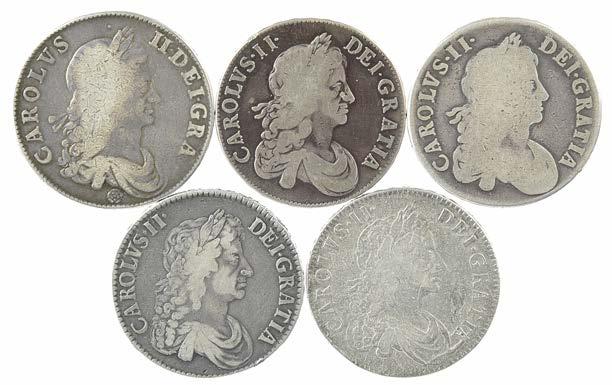
not to scale
Charles II, silver crowns (5): 1662, first bust with rose below, undated edge (S 3350), fair to fine; 1664, second bust, edge XVI (S 3355), near fine, reverse better; 1668 (S 3357), good fair; 1671, third bust, edge V. TERTIO (S 3358), good fine; 1672 (S 3358), fine. [5]
£300400
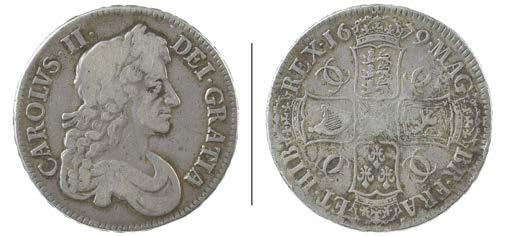
Charles II, silver crown, 1679, third bust, edge V. PRIMO (S 3358), about fine.
£150200
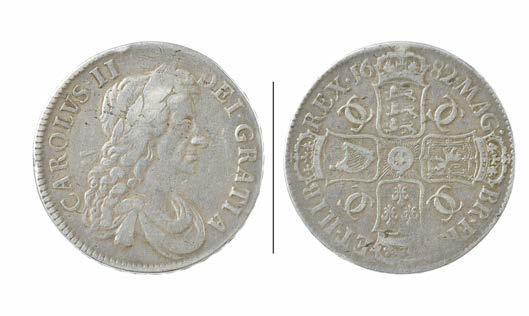
100
Charles II, silver crown, 1682, fourth bust, edge T. QUARTO (S 3359), near very fine.
£200300

97
Charles II, silver crown, 1676, third bust, edge V. OCTAVO (S 3358), good very fine or better
£300400
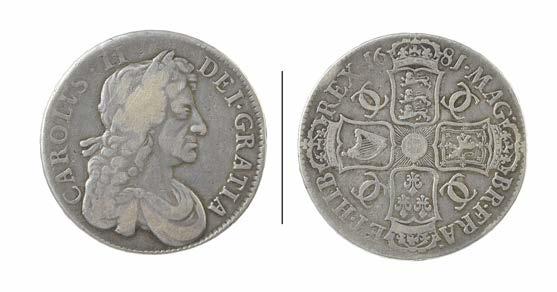
II, silver crown, 1681, fourth bust (S 335), good fine.
£150200

101
Charles II, silver half crown, 1663, first bust (S 3361), good fine.
£150250

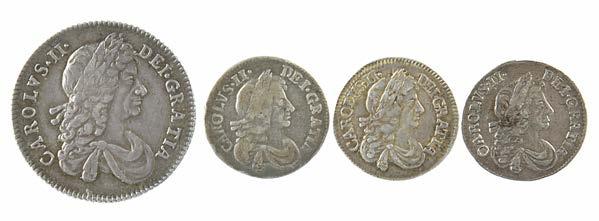
not to scale not to scale
102
Charles II, silver halfcrowns (7): 1670, third bust (S 3365), fair to fine; 1671 (S 3366), fair to fine; 1676, fourth bust (S 3367), fine, reverse better; 1677 (S 3367), fair to fine; 1678 (S 3367), fair, reverse better; 1679, edge T. PRIMO (S 3367), near very fine; 1683 (S 3367), good fine [7]
£450550
103
Charles II, silver coins (4): shilling, 1668, second bust (S 3375), good very fine with some lustre; threepence, 1676 (S 3386), fine; threepence, 1679 (S 3386), clash marks to obverse, very fine; threepence, 1680 (S 3386), near very fine. [4]
£200300
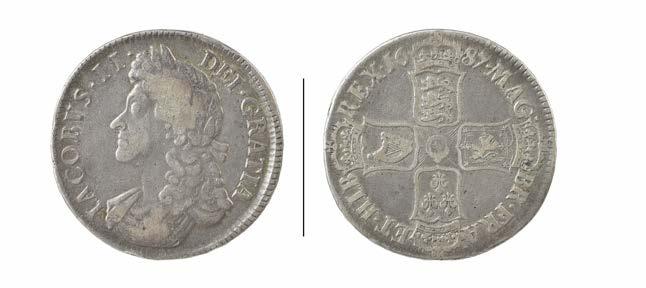
James II, silver crown, 1687, second bust (S 3407), good fine.
£150250

105
James II, silver crown, 1688/7, second bust (S 3407), good fine.
£150200
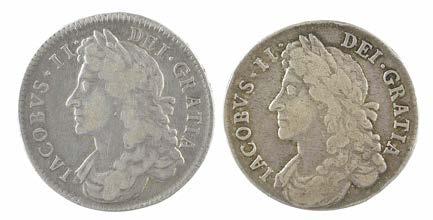
106
James II, silver half crowns (2): 1686, first bust, edge SECUNDO; 1687, edge TERTIO (S 3408), each at least good fine. [2]
£300500

107
James II, silver shilling, 1686 (S 3410), good very fine.
£300400

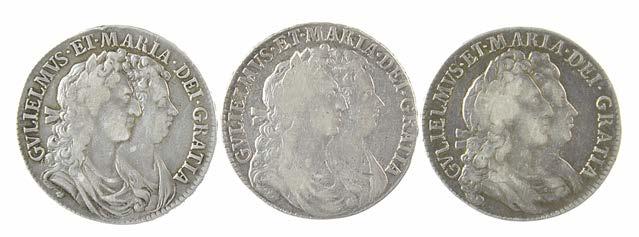
109
William and Mary, silver crowns (2), 1691, 1692 (S 3433), fair to fine, reverses better [2]
£250350
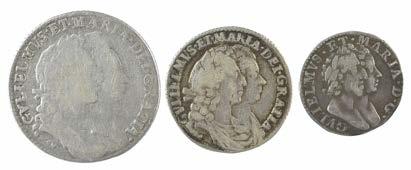
110
William and Mary, silver coins (3): shilling, 1693 (S 3437), near fine, reverse better; sixpence, 1693 (S 3438), fine; threepence, 1689, first conjoined busts, LMV over MVS (S 3441), good fine. [3]
£150250
William and Mary, silver halfcrowns (3): 1689 (2), first conjoined busts (S 3434), one very fine or nearly so, the other good fine, reverse better; 1692, second busts, edge QVARTO (S 3436), near very fine, reverse better. [3]
£250350
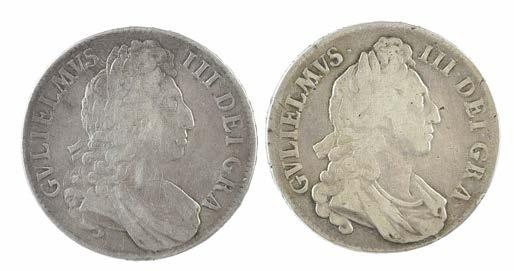
111
William III, silver crowns (2): 1695, edge SEPTIMO (S 3470), fine; 1696, edge OCTAVO (S 3470), good fine. [2]
£150200
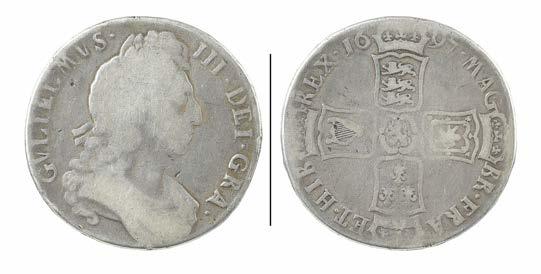
112
William III, silver crown, 1697, edge NONO (S 3473), near fine, rare.
£7001,000
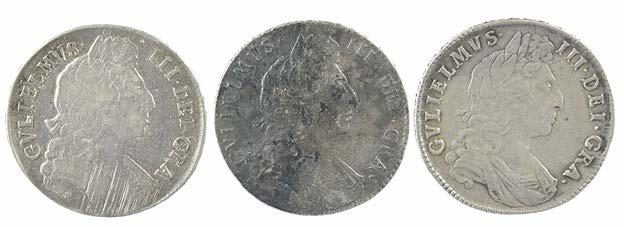
William III, halfcrowns (3): 1696, edge OCTAVO (S 3487), areas of scraping and date rubbed, therefore fine; 1697, edge NONO (S 3487), fine; 1698, modified large shields, edge DECIMO (S 3494), near very fine. [3]
£150250

William III, silver sixpence, 1697, third bust, later harp, large crowns (S 3538), about extremely fine.
£100150
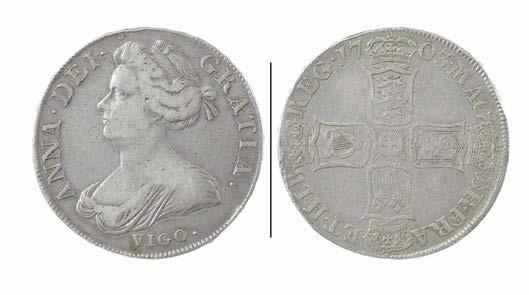
117
Anne, silver crown, 1703, first bust, VIGO, rev. preunion shields, edge TERTIO (S 3576), good fine.
£400600
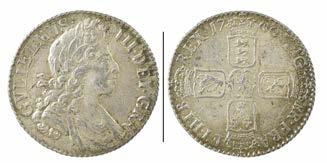
114
William III, silver shilling, 1700, fifth bust (S 3516), nearly extremely fine.
£100150

116
William III, silver coins (4): shilling, 1696, first bust (S 3497), pitted, fine; sixpence, 1695, first bust, early harp (S 3520), fine; sixpence, 1696, Exeter, first bust, early harp (S 3523), good fine; threepence, 1701 (S 3550), good fine. [4]
£150200
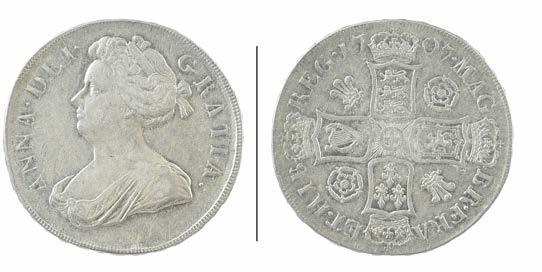
118
Anne, silver crown, 1707, first bust, rev. roses and plumes in angles, edge SEXTO (S 3578), sometime cleaned, near very fine
£300500
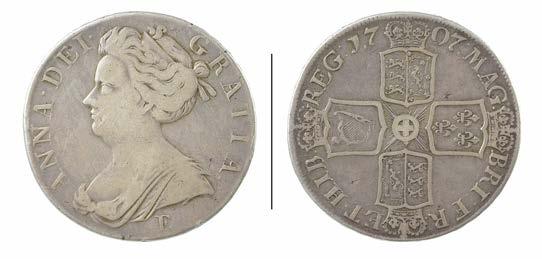
119
Anne, silver crown, 1707, Edinburgh, second bust with E below, edge SEXTO (S 3600), fine, reverse better
£100150
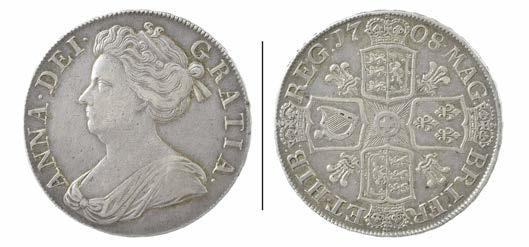
120
Anne, silver crown, 1708, second bust, rev. plumes in angles, edge SEPTIMO (S 3602), very fine, reverse much better, toned.
£300500

121
Anne, silver crown, 1708, Edinburgh, second bust with E below, edge SEPTIMO (S 3600), good fine
£150200

122
Anne, silver crown, 1713, third bust, rev. roses and plumes, edge DVODECIMO (S 3603), fine, reverse better
£200300
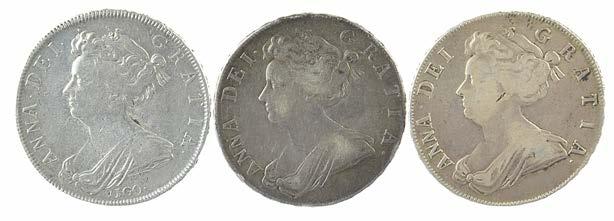
123
Anne, silver halfcrowns (3): 1703, first bust, VIGO, rev. preunion shield, edge TERTIO (S 3580), fine; 1704, rev. plumes in angles, edge TERTIO (S 3581), good fine; 1706, rev. roses and plumes, edge QVINTO (S 3582), fair to fine, reverse better. [3]
£200300
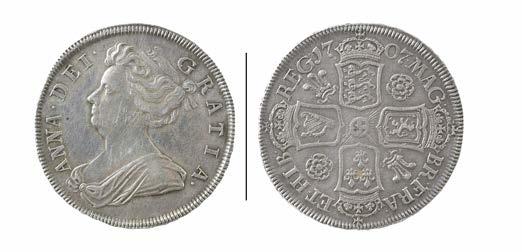
124
Anne, silver halfcrown, 1707, first bust, rev. preunion shields, roses and plumes in angles, edge SEXTO (S 3582), struck on a wide flan, very fine or better
£150250
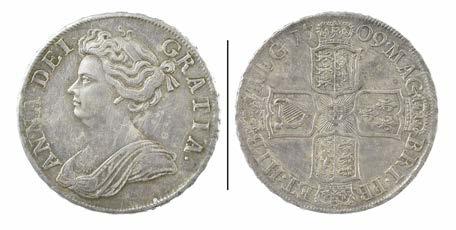
125
Anne, silver halfcrown, 1709, rev. postunion shields, plain angles, edge
OCTAVO (S 3604), very fine, reverse better, some lustre.
£300400

126
Anne, silver halfcrown, 1710, rev. roses and plumes, edge NONO (S 3607), haymarks and some scratches, near very fine.
£150200
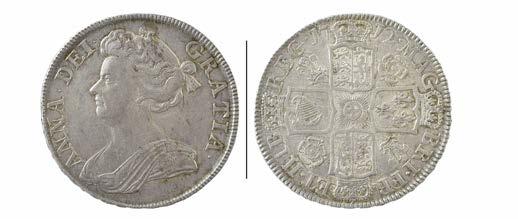
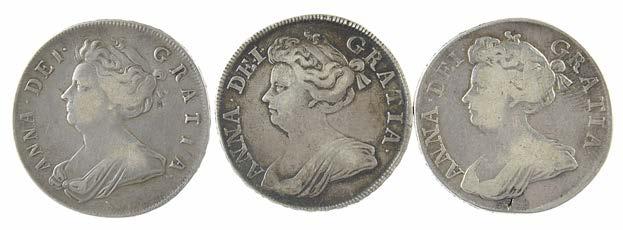
127
Anne, silver halfcrown, 1712, rev. roses and plumes, edge UNDECIMO (S 3607), about very fine, reverse better, some lustre.
£200300
128
Anne, silver halfcrowns (3): 1708, rev. plumes, edge SEPTIMO (S 3606), good fine, reverse better and toned; 1713, rev. plan angles, edge
DVODECIMO (S 3604), near fine; 1713, rev. roses and plumes, edge
DVODECIMO (S 3607), fine, reverse better [3]
£200300
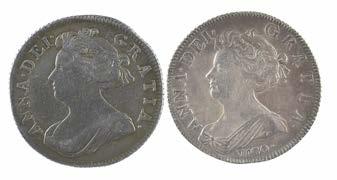
129
Anne, silver shillings (2): 1702, first bust, rev. plain angles (S 3583), good fin or better and toned; 1703, second bust, VIGO (S 3586), about very fine. [2]
£200300
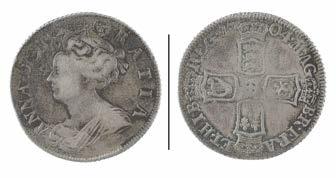
130
Anne, silver shilling, 1704, rev. plain angles(S 3587), bust rubbed, otherwise fine and rare.
£400600

131
Anne, silver shilling, 1705, rev. plain angles (S 3587), about fine and rare.
£200300
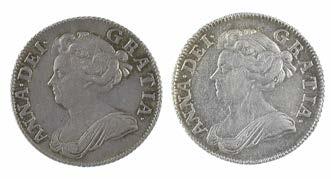
132
Anne, silver shillings (2): 1707, third bust, rev. plain angles (S 3610), good very fine with some lustre; 1708, third bust, rev. plumes in angles (S 3611), sometime cleaned and scratches to bust but very fine. [2]
£200300

133
Anne, silver shillings (5): 1707, third bust, rev. plan angles (S 3610), fine; 1710, rev. roses and plumes (S 3614), good fine or better and toned; 1711, fourth bust, rev. plain angles (S 3618), good fine or better; 1712, rev. roses and plumes (S 3617), near very fine; 1714, rev. roses and plumes (S 3617), fine, reverse better. [5]
£300400
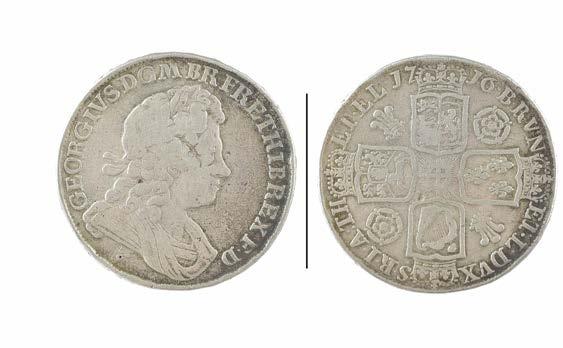
135
George I, silver crown, 1716, rev. roses and plumes, edge SECVNDO (S 3639), fine, reverse a little better.
£200300

134
Anne, silver coins (4): sixpence, 1711 (S 3619), edge nick at 7 o’clock, fine; threepences (3): 1706, second bust (S 3596A), good fine; 1708, third bust (S 3596B), very fine or nearly so; 1710 (S 3596B), very fine or better. [4]
£4060

136
George I, silver shillings (4): 1715, first bust, rev. roses and plumes (S 3645), near very fine; 1718 (S 3645), very fine or nearly so and lightly toned; 1720, first bust, rev. plain angles (S 3646), very fine or better and toned; 1723, SSC (S 3647), fine; together with: sixpence, 1723, SSC (S 3652), haymarks, cleaned, otherwise about very fine; and threepence, 1721 (S 3655), good fine. [6]
£250350
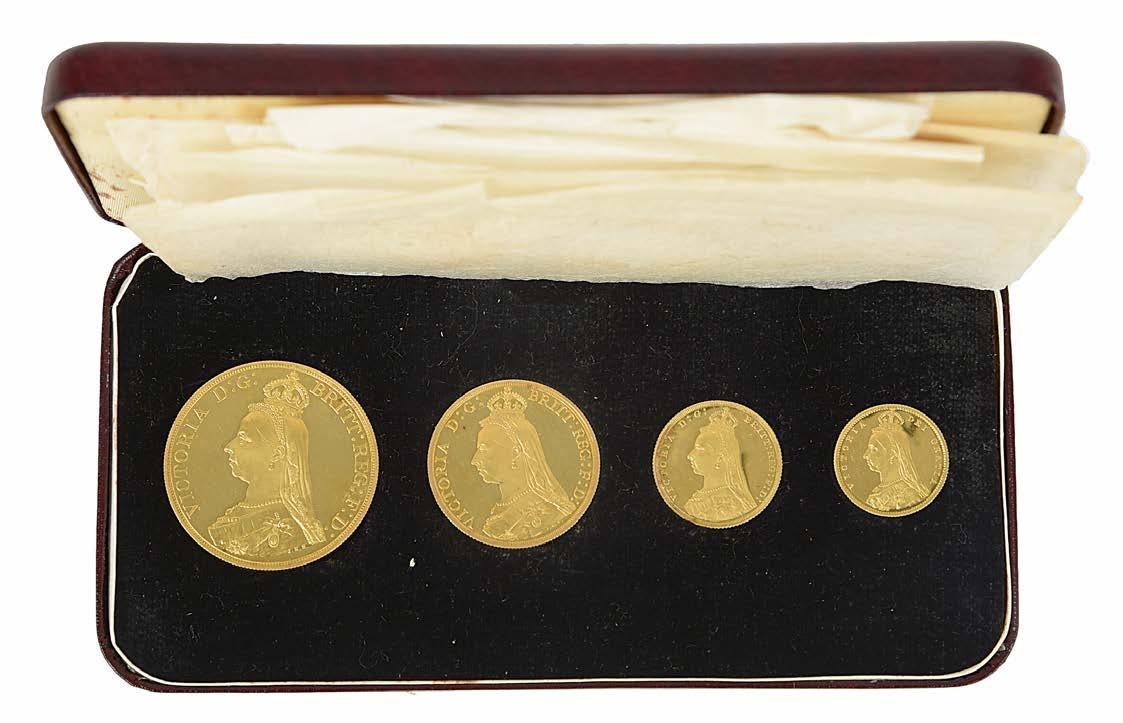
137
Victoria, gold proof coins (4), 1887, five pounds, two pounds, sovereign and half sovereign (S 3864, 3865, 3866B, 3869), in a later fitted case, hairlining, otherwise good extremely fine. [4]
£3,0005,000
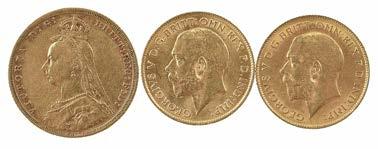
138
Victoria, gold sovereign, 1888, Melbourne Mint, repositioned legend (S 3867B), good fine; George V, half sovereigns (2), 1912, 1914 (S 4006), very
fine or better. [3]
£600700

139
George VI, gold proof coins (4), 1937, five pounds, two pounds, sovereign and half sovereign, plain edges (S 4074, 4075, 4076, 4077), in red card fitted case, some hairlining, otherwise good extremely fine. [4]
£5,0007,000
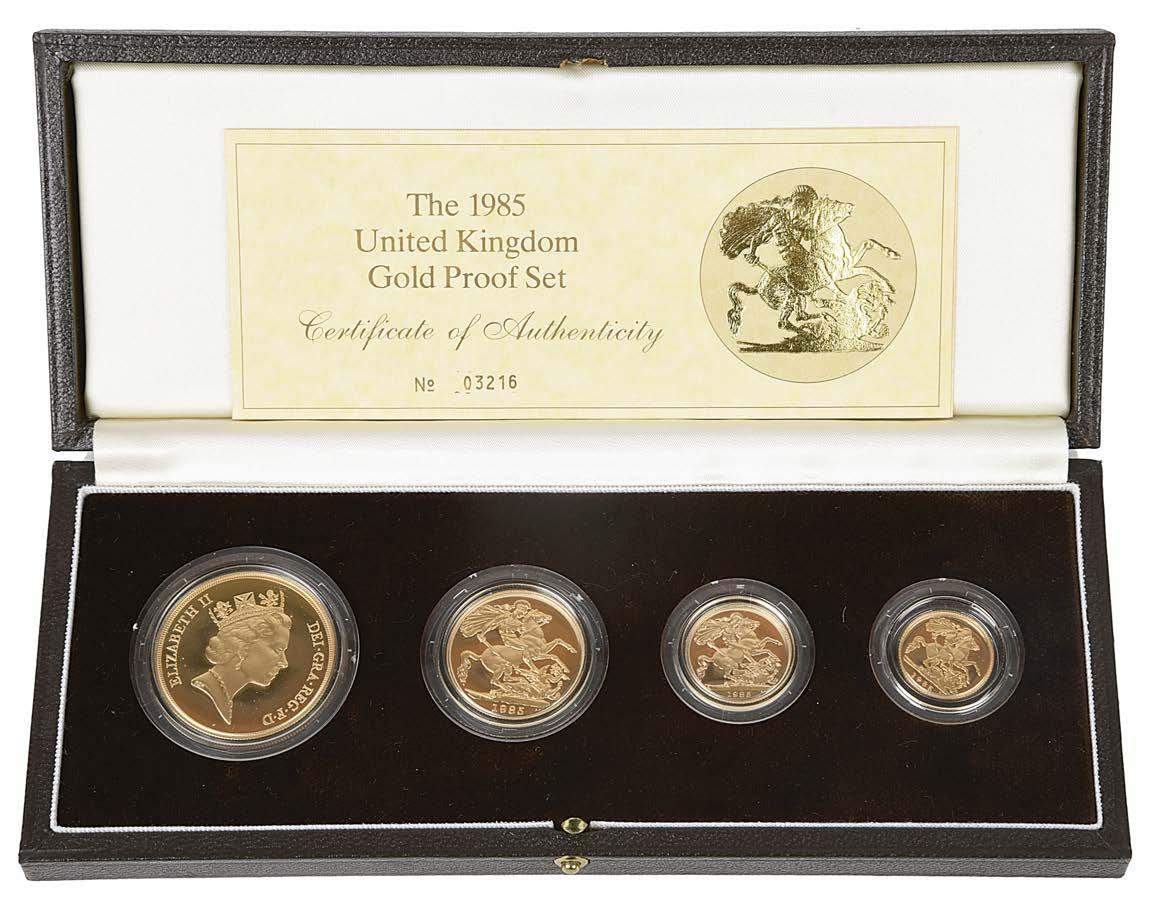
not to scale
140
Elizabeth II, gold proof set, 1985, four coins, five pounds to half sovereign (S PGS06), cased with certificate, about as struck. [4]
£2,0003,000

141
Elizabeth II, gold proof set, 1980, four coins, five pounds to half sovereign (S PGS01), cased with certificate, about as struck. [4] £2,0003,000
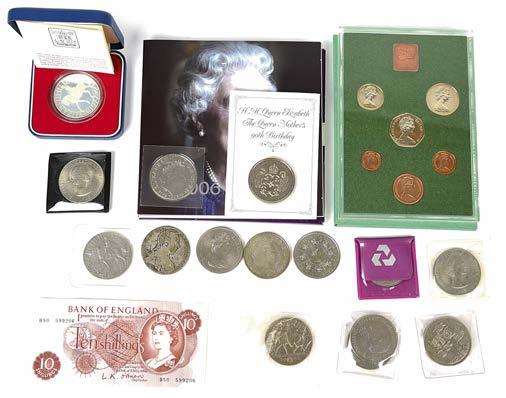
142
A small quantity of coins, including: Elizabeth II, silver proof crown, 1977, cased with certificate; specimen set, 1975, six coins plus Mint medal in plastic case with card sleeve; various commemorative crowns; and other items. [qty]
£3040

143
Elizabeth II, silver proof crown, 1977, cased with certificate, as struck; specimen set, 1974, six coins plus Mint medal, in plastic case with card slip, as struck; crown, 1972, nearly extremely fine. [8]
£3040
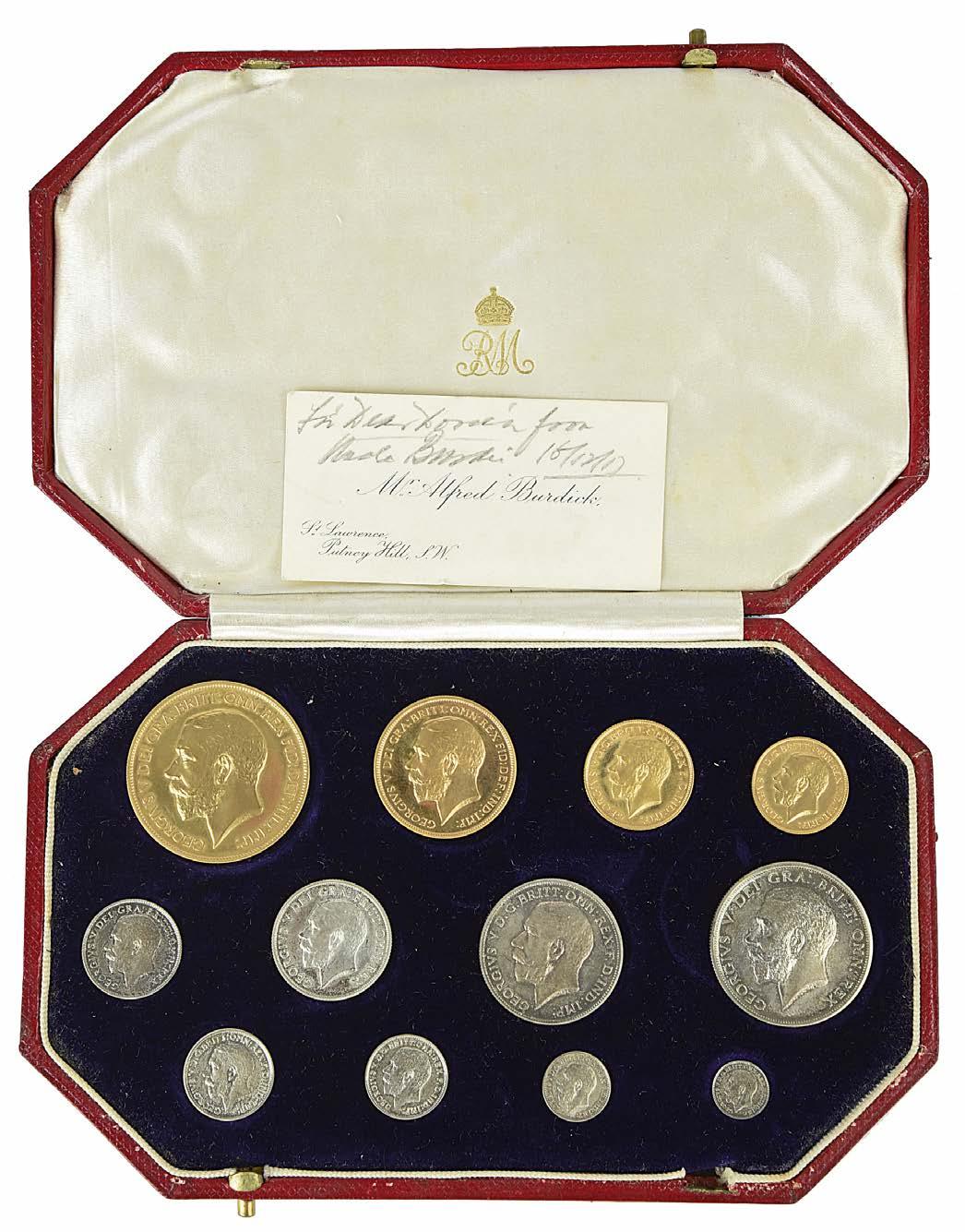
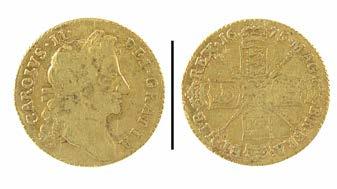
145
Charles II, gold guinea, 1675, fourth bust (S 3344), traces of lacquer or varnish, good fine.
£550650
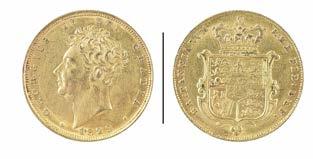
146
George IV, gold sovereign, 1829, bare head, rev. crowned shield (S 3801, F 377, KM 696), good very fine.
£600800

147
British East India Company, regal series, William IV, gold mohur, 1835, head right, rev. lion and palm tree (FF 1593, KM 451.1), edge worn and faces bruised, possibly once worn in a loose mount, about good fine.
£1,2001,600

148
United States of America: gold twenty dollars, 1908, Arabic numerals, no mm., rev. no motto below eagle (KM 127, F 183), nearly extremely fine.
£1,6002,000

149
Ottoman Empire: Abdul Mejid (183961), gold one hundred kurush (piastres), regnal year 16 (1854), (F 18, KM 679), fine.
£300400
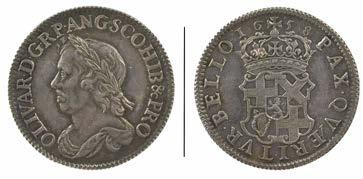
150
Oliver Cromwell, silver shilling, 1658 (S 3228), about extremely fine and toned.
£1,0001,500
151
Victoria, silver crown, 1847, ‘gothic’ type, edge UNDECIMO (S 3883), very
fine or better, scarce.
£8001,200
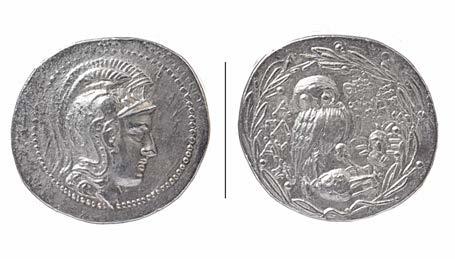
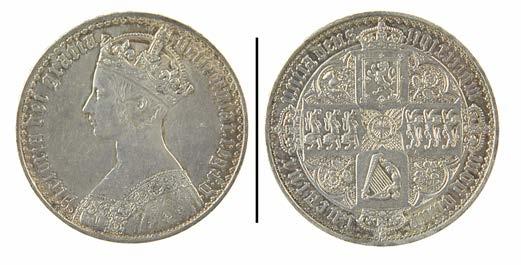
152
Athens: silver tetradrachm (19687 BC), helmeted head of Athena right, rev. an owl standing on an amphora, head of helios, good very fine.
Provenance: The Richard Stagg Collection.
£150250
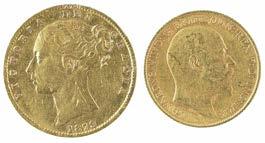
153
Victoria, gold sovereign, 1879, Sidney Mint (S 3855, F 11), some scratches, otherwise very fine; and Edward VII, half sovereign, 1906 (S 3974B), good fine or better [2]
£500600
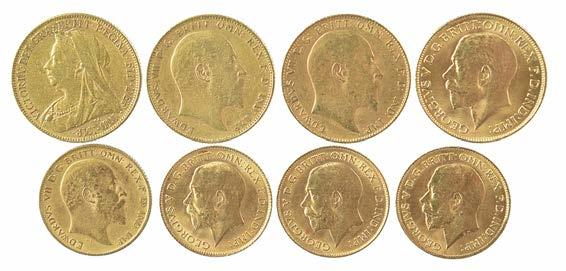
154
A collection of British gold coins, comprising: Victoria, sovereign, 1898, Melbourne Mint (S 3875), good fine; Edward VII, sovereign, 1903, Perth Mint (S 3972), near very fine; sovereign, 1910 (S 3969), very fine; half sovereign, 1905 (S 3974B), very fine; George V, sovereign, 1913 (S 3996), extremely fine or nearly so; half sovereigns (3), 1914 (2), 1915 (S 4006), nearly extremely fine. [8]
£2,2002,800
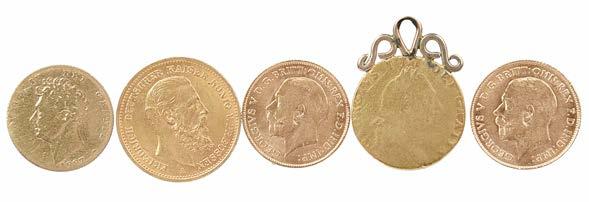
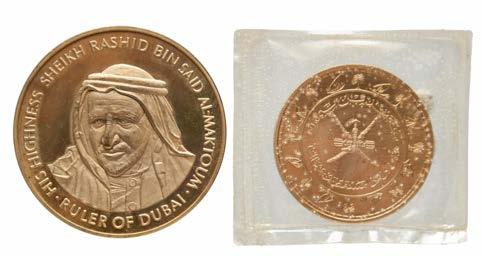
not to scale not to scale
155
A small collection of gold coins, comprising: England: George III, half guinea, 1788 (S 3735), soldered scroll mount, poor; George IV, half sovereign, 1827 (S 3804), fair; George V, half sovereigns (2), 1925, 1926, Pretoria mint (S 4010), extremely fine; German Empire, Prussia, Frederick III, twenty marks, 1888 (F 3828), extremely fine or nearly so. [5]
£1,2001,600
156
Sultanate of Muscat and Oman, gold rial, 1970, commemorative issue to mark the introduction of the new Saidi currency (KM 31b), cased with certificate and typed explanatory note, light hairlining, otherwise as struck; together with: Dubai, opening of the Intercontinental Hotel 1975, a giltmetal commemorative medal, in Spink case, about as struck. [2]
£3,0004,000

157
Victoria, silver crowns (4), 1845, young head coinage (S 3882), some edge bruising, otherwise about fine; 1889, Jubilee coinage (S 3921), fine; 1893, 1894, veiled head coinage (S 3937), near very fine or a little better. [4]
£150250
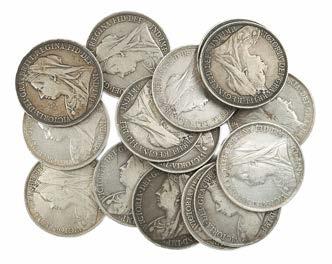
158
Victoria, silver crowns (15), veiled head coinage, 1895 (3), 1897 (5), 1898, 1899 (2), 1900 (4) (S 3937), most about very fine, some a little better [5]
£250350
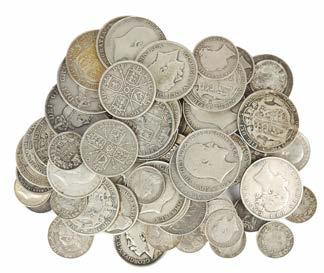
159
Victoria to George V, a collection of British silver coins, including: double florins (2), 1887, 1890 (S 3922, 3923), good fine, reverses better; half crowns (22); florins (10); and various smaller denominations, grades mainly in the mid ranges. [qty]
£300400

160
British Colonies, trade dollars (5), 1897B, 1898B, 1899B (2), 1900B (KM T5), all about very fine, one of the 1899 examples with chop marks to either side. [5]
£200300

161
British India, Victoria, silver rupees (7): Victoria as Queen, 1862, bust with 3.75 panels in jabot, rev. closed flower at top, slanted ‘1’ in date, flower at bottom with seven pearls (KM 473.1), good very fine; Victoria as Empress, 1882, bust A, rev. I, Bombay, very fine, reverse a little better; 1886, bust C, rev. I, Calcutta, incuse ‘C’, nearly extremely fine; 1888, bust C, rev. I, raised ‘B’, very fine; 1891 (2), bust C, rev. I, incuse ‘B’, good very fine or a little better; 1900, bust C, rev. I, incuse ‘B’, near very fine; (KM 492). [7]
£200300
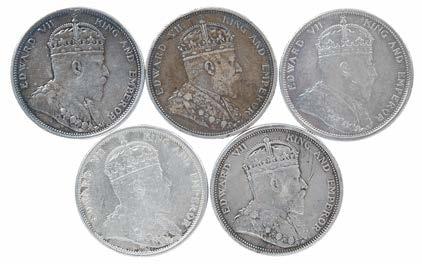
162
Straits Settlements: Edward VII, silver dollars (5), 1903, 1904 (4) (KM 25), very fine, very fine and better [5]
£300400
163
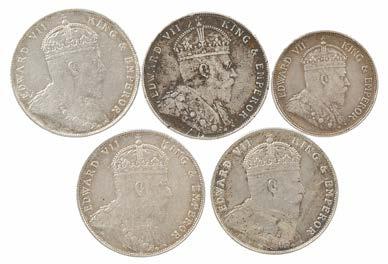
not to scale
Straits Settlements: Edward VII, silver dollars, 1907 (2), 1908, 1909 (KM 26); silver fifty cents, 1907 (KM 24); very fine, reverses generally a little better [5]
£200300
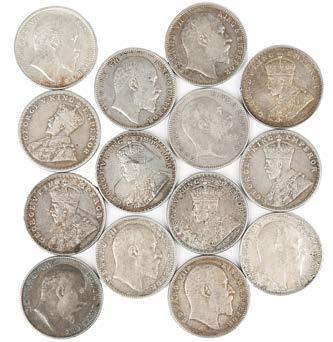
not to scale

164
A small collection of British Imperial silver coinage, including: Mombasa, Imperial British East India Company, rupee, 1888H (KM 5), very fine; Bikanir, Victoria as Empress, rupee, 1897 (KM 72), good very fine with some lustre; Cyprus, Victoria, eighteen piastres, 1901 (KM 7), good fine, reverse better; Ceylon, Edward VII, fifty cents, 1910 (KM 99), about very fine; British West Africa, George V, two shillings, 1918 (KM 13), about very fine; and British India, Edward VII and George V, various half ruppes and small denominations. [12]
£150250
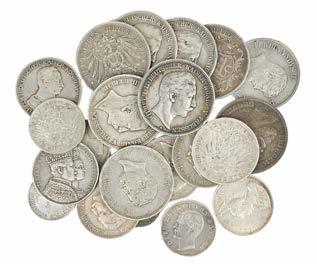
165
British India, silver rupees (14): Edward VII, 1904, Bombay, very fine; 1905 (2), Bombay, good very fine; 1906, Bombay, good very fine; 1906, Calcutta, very fine; 1907, Bombay, good fine; 1907, Calcutta, good fine; 1910, Calcutta, about very fine (KM 508); George V, 1911, Bombay, type I ‘pig’ obverse, good very fine or better; 1911, Calcutta, type I obverse, about very fine (KM 523); 1913, Bombay, good fine; 1919 (2), Bombay, very fine, reverses better; 1920, Calcutta, very fine or better (KM 524). [14]
£300400
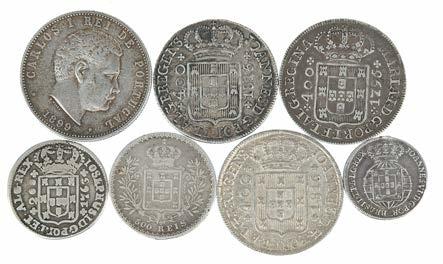
167
166
Central and Southern Europe, a collection of silver coins, crown equivalents and fractions, including: Naples, Ferdinand II, 120 grana (2), 1854, 1855 (KM 370), fine, very fine; German States Baden, Friedrich I, five marks, 1875 (KM 263.1), very fine and toned; Hamburg Free City, five marks, 1904 (KM 610), very fine; Prussia, William I, coronation thaler, 1861 (KM 488), near very fine, reverse better; William II, five marks (5), 1895, 1900, 1903, 1904, 1907 (KM 523), fine to very fine; Imperial issues including: German East Africa, rupee, 1910J (KM 10), good very fine, reverse better; and others. [qty]
£200300
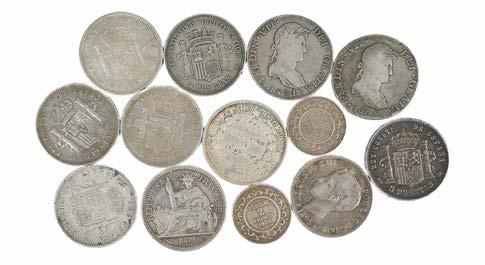
not to scale not to scale
Portugal: a small collection of silver coins, including: Maria I, four hundred reis, 1795 (KM 288), good fine or a little better; John VI, four hundred reis (2), 1815, 1816 (KM 331), the first very fine, the second about extremely fine with some lustre; Charles I, one thousand reis, 1899 (KM 540), good very fine, reverse nearly extremely fine; and three smaller coins. [7] £150200
168
Western Europe and colonies: a small collection of silver coins, comprising: Spanish Mexico: Ferdinand VII, eight reales (2), 1820, 1821 (KM 111), near fine, reverses better; Spain, Provisional Government, five pesetas, 1870 (KM 655), small rim dent, good fine; Alphonso XII, five pesetas, 1885 (KM 688), very fine and toned; Alphonso XIII, five pesetas (3), toddler’s head, 1888 MPM, 1891 (2) (KM 689), about very fine; five pesetas (2), child’s head, 1898 (KM 707), fine or better; French IndoChina, piastre, 1889 (KM 5), near very fine; piastre, 1902 (KM 5a.1), very fine; Tunisia French Protectorate: Muhammad alNasir Bey, two francs (2), 1915, 1916 (KM 239), near extremely fine and good very fine. [13]
£200300
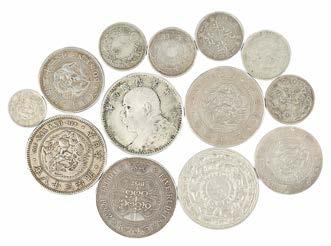
A small quantity of Far Eastern silver coins, including: China: Guangxu, twenty cents, cyclical date 1902, Jiangnan Province (Y 143a.8), good very fine; twenty cents, ND (18971907), Hubei Province (Y 125.1), good very fine; Yüan Shikai, dollar, year 3 (Y 329), about very fine; Japan: Mutsuhito (Meiji), yen, 1905 (Y A25.2), some edge bruising and contact marks, otherwise very fine; fifty sen, 1898 (Y 25), very fine; Yoshihito (Taisho), yen, 1914 (Y 38), near very fine; five other Japanese coins; together with: Ceylon, five rupees (2), 1957, 2,500 years of Buddhism (KM 126), one extremely fine, the other very fine. [13] £150250
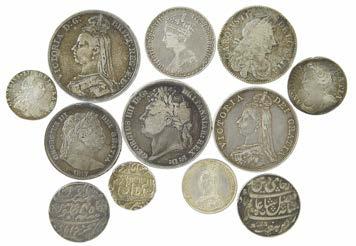
A small collection of silver coins, comprising: Charles II, half crown, 1670 (S 3365), near fine; Anne, shilling, 1712 (S 3617), fine; George III, sixpence, 1787, no semée of hearts (S 3748), near extremely fine; half crown, 1817 (S 3788), good very fine or better; George IV, crown, 1821 (S 3805), fine; Victoria, florin, 1859 (S 3891), good fine; crown, 1890 (S 3921), near very fine; double florin, 1887, Arabic 1 (S 3923), good very fine; shilling, 1887, small head (S 3926), extremely fine or nearly so; India: two rupees, and a rupee fraction, very fine and better. [12]
£400500
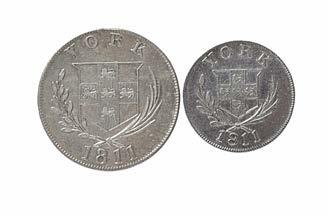
173
York: silver token shilling, 1811, arms within a wreath, rev. ‘CATTLE AND BARBER’, good very fine; and a token sixpence, 1811, the same type, near very fine. [2]
Provenance: The Richard Stagg Collection.
£4060
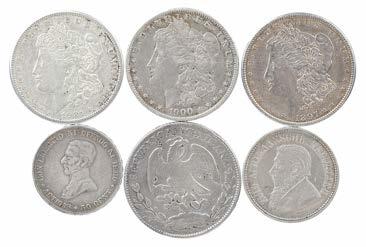
170
The Americas a small collection of silver coins, comprising: MexicoZacatecas: dollar, 1875 (KM 377.13), chop marks and an edge nick, fine; USA: dollars (3), Morgan type, 1897, 1900. 1921S (KM 110), each about very fine; Uraguay: fifty centesimos, 1917 (KM 22), fine, reverse a little better; together with a South African silver 2 1/2 shillings, 1897 (KM 7), very fine. [6]
£150200

A collection of British silver coins, comprising: Victoria, half crowns (7), various dates, heavily rubbed, fair; florin, 1862, fair; shillings (4), 1874, 1890, 1899, 1900, fair to near fine; Edward VII, florins (3), dates rubbed, fair; George V, half crowns (27), dates from 19141919 (S 4011), grades from fine to good very fine; florins (15), dates from 19121919 (S 4012), grades from fine to good very fine; shillings (27), dates from 19111919 (S 4013), grades from fine to near very fine; sixpence (26), dates from 19111919 (S 4014), grades from fine to very fine; together with five half crowns, one shilling and one sixpence, 19201926 (.500 fine silver), fair to fine. [qty]
£250350
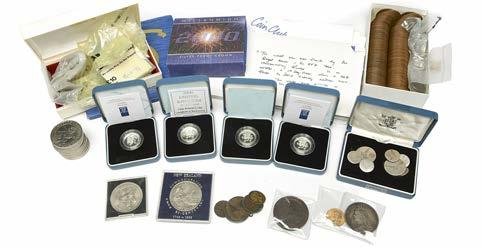
174
A collection of British coins, including: George V, gold sovereign, 1930, Pretoria mint (S 4005), extremely fine; Victoria, silver crown, 1890, Jubilee issue (S 3921), good fine or better; Elizabeth II, silver proof crown, 2000, Millennium commemorative issue with British Isles plated in gold (S 4552B), cased with certificate, as struck; silver proof pounds (3), 2000, Welsh design (S 4592), cased with certificates, as struck; George III, copper twopence, 1797, Soho mint, ‘cartwheel’ coinage (S 3776), edge pierced and scuffed as by sometime incorporation in a mount, otherwise very fine; and various other commemorative and souvenir issues, later predecimal coins, banks notes, and other items. [qty]
£500600
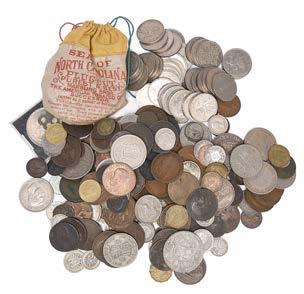
175
A small collection of coins, including: George III, copper two pence, 1797, Soho mint (S 3776), twice countermarked with crowned ‘AJ’, good fine or better; another, fine; France 2nd Empire: Napoleon III, silver five francs, 1867, near very fine; and various other 19th and 20th century issues, various nations, grades vary. [qty]
£80120
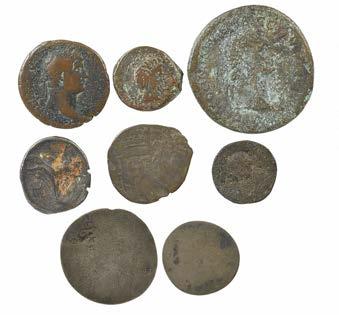
177
A small quantity of coins, including: Taras, silver didrachm, c. 3rd century BC, horseman, rev. dolphin rider, fine; three various Roman coins; and worn early modern issues. [8]
£80120
178
South Africa: Nelson Mandela, five rand, 2008, 90th birthday commemorative issue, in NGC holder with standard label, graded 65 by NGC; together with a 1/10th ounce platinum medal commemorating the same occasion, cased with certificate, about as struck; and Tanzania, 100 shilingi, 1986 (KM 18), in World Wildlife Fund 25th anniversary commemorative pack, as struck. [3]
£150250
179
A small collection of coins and associated items, including: Spain Barcelona: Jose Napoleon, silver peseta, 1813 (KM 70), value rubbed off, otherwise fine; U.S.A.: copper cent, 1845, braided hair type (KM 67), good fine or a little better; small continental silver issues in low grades, British lte predecimal issues, and other items. [qty]
£150200

176
A small collection of British silver coins, including: Edward II (130727), penny, London, central fleur of crown formed by indented wedges (S 1458), good fine or better; Edward III (132777), groat, London, much clipped with incomplete legend; Edward VI, shilling, fine silver issue (15513), facing bust and rose (S 2482), bust almost erased, reverse better, good fair; Elizabeth I, sixpence, 1574, mm. eglantine, pierced, good fair; and other items including coins of James I, Charles II, James II, and others later. [18]
£200300

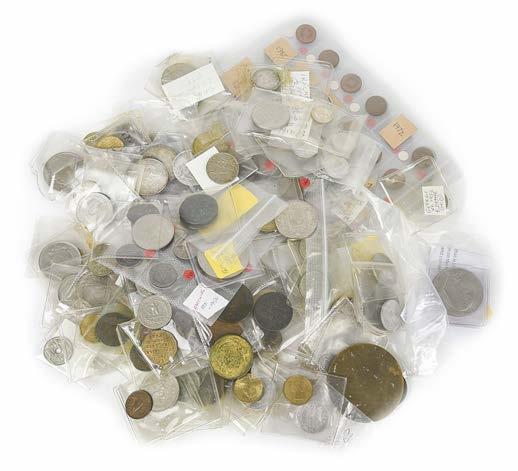

180
A Japanese Imperial Army officer’s sword (Shingunto), slender nontraditional blade of parade sword type mounted in regulation shingunto pattern hilt and scabbard, with a contemporary leather sword hanger.
Provenance: The George Geear Collection
£200300

181
A Japanese sword (owakizashi), blade 22.25 in., honzukuri, suriage, nakago with two ana and signed (Hishu Kawachi No Kami Fujiwara Masahiro), silver covered habaki with neko-gaki; mounted as a shingunto with regulation army tsuka distinguished by a tiger menuki and with a mon to the kashira, wooden saya with leather field cover.
Provenance: Received by the vendor's father, a British Army Major, from a surrendering Japanese officer in Burma, 1945.
£300500
182

A Japanese sword, blade 25.25 in., hon-zukuri, plain copper habaki, nakago with twocharacter mei, plain brass tsuba, saya of plain wood with simple iron fittings, received from the surrendering Japanese forces in 1945 and of contemporary manufacture.
£150250
183
A good Japanese bone mounted dagger (tanto), blade 11.5 in., plain brass habaki, bone tsuka and saya well carved with scenes involving a woman in a supplicant attitude before a group of warriors, peasants beyond, all set against architectural and naturalistic elements; and another dagger of similar type. [2]
£150200

λ 184
A Persian sword (shamshir), curved blade of watered steel 28.25 in., doubleedged for the upper 7.5 in., the back with undulating steps at the point of transition, the inside of the blade with a panel of foliate decoration in gold koftgari, the outside with gold and silver inlay to the forte including Islamic text to a roundel; the hilt of iron embellished with gold koftgari, long budterminal quillons, rightangled pommel with elongated iron cap, marine ivory grip scales shaped for the fingers; embossed leather covered scabbard with plain mounts, 18th/19th century.
£600800
185
Saudi Arabia: a presentation sword (saif), the blade 36 in, nearly straight with a single broad fuller to each side and etched foliate decoration, incuse and gilt roundel to the forte bearing the Saudi national emblem; giltmetal hilt with right angle terminal and budterminal quillons, multipart knuckle chain interrupted by a medallion, simulated ivory grip scales; opulent giltmetal scabbard set with paste stones in various colours; in a fitted case with inscription in gilt to the interior: "With the compliments of Eastern Province Governor His Royal Highness Prince Mohammed Bin Fahd Bin Abdul Aziz".
Provenance: The property of a lady of title. Given at a private presentation by King Fahd in 1986.
£400600
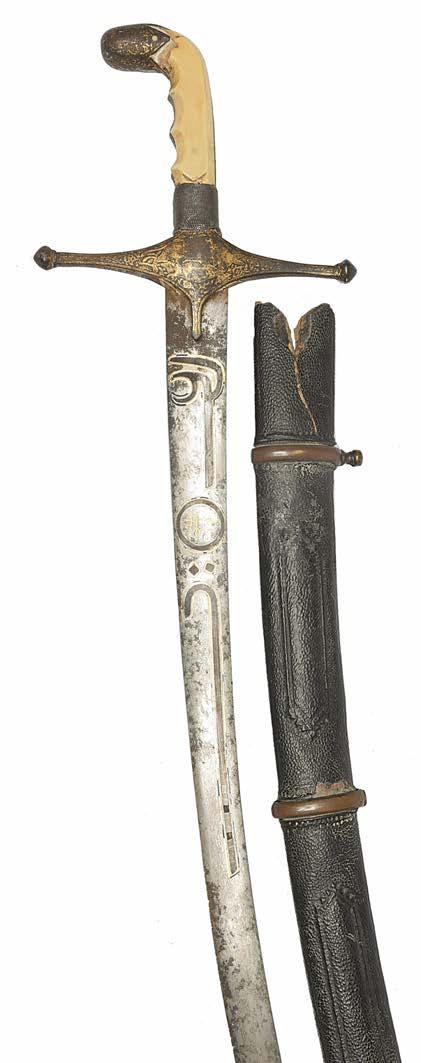

186
A 17th century English duelling rapier, slender diamondsection blade 36.5 in. steel guard formed of two oval shells pierced in a lattice pattern and supported by slender arms and side rings descending from the fluted quillon block, slender scrollterminal quillons, fluted ovoid pommel with button finial, grip bound with braided wire between Turks’ head knots, c. 1630.
£8001,200
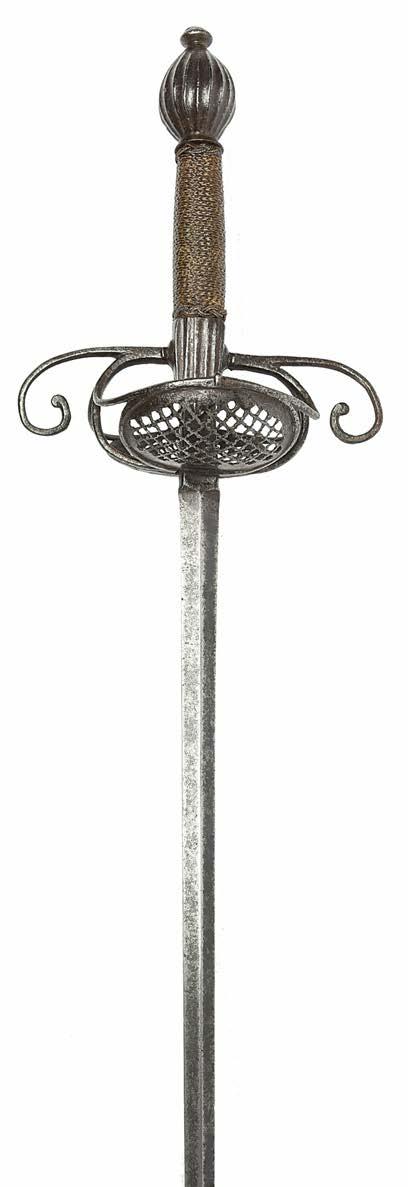
187
A 17th century cavalry sword, singleedged blade 30.25 in., narrow back fuller and running wolf mark to either side; steel hilt of ‘Walloon’ type, side rings filled with plates pierced and engraved with a pattern of nested borders, slender knuckle bow augmented by two scrolling bars to each side, large ovoid pommel with incised border to the tang button, grip later wrapped with braided wire and copper tape, probably English, c. 1670.
£1,2001,800
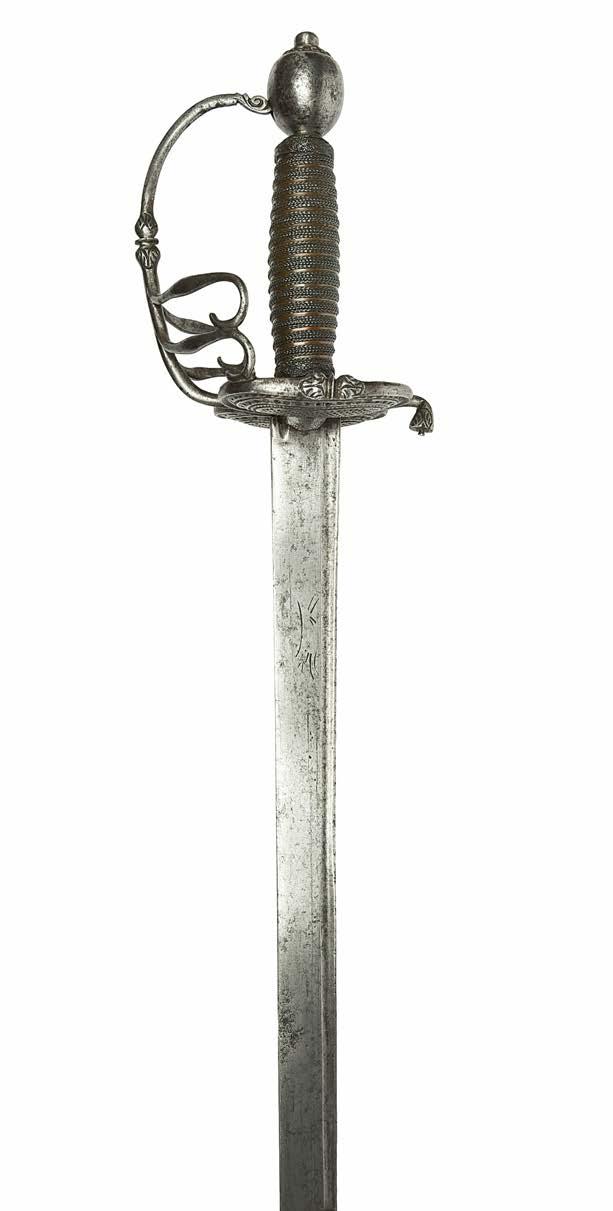
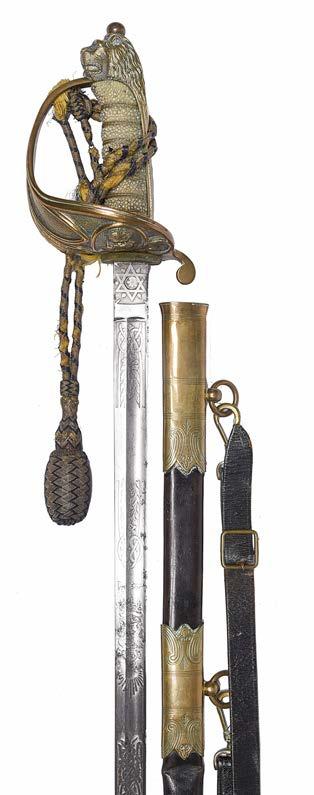
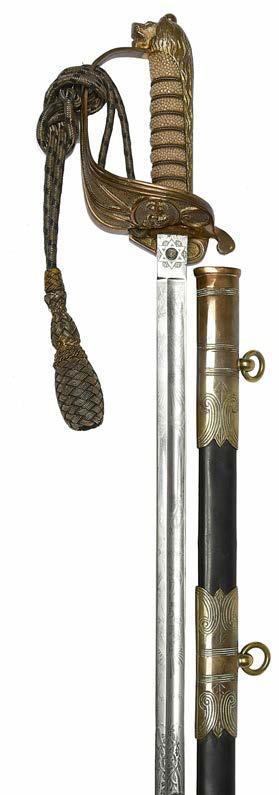


188
A British 1846 pattern Royal Naval officer’s sword attributed to Commander Charles Everard Hughes White, D.S.O., D.S.C., R.N., blade with etched decoration including a fouled anchor, retailed by J. Gieve & Sons, regulation giltbrass hilt with fouled anchor to the cartouche, folding inner guard engraved ‘C. E. H. WHITE. R.N.’, giltbrass mounted leather scabbard, with sword knot and leather hangers.
Notes: Charles Everard Hughes White was born in 1884 and entered the Royal Navy in January 1900 as a Naval Cadet. He served in torpedo boats and destroyers, and on the 1st of May 1915 he took part in the Battle of Noordhinder Bank in command of the destroyer H.M.S. Lark, assisting in the sinking of two German destroyers. On the 14th of August 1917, in command of the destroyer Melampus, he earned the approbation of the Admiralty for an energetic attack on a German submarine, and he was subsequently credited with the destruction of UC16, for which he was awarded the D.S.O., which he received at an investiture at Buckingham Palace on the 8th of May 1919. He served in both world wars and his D.S.O. was gazetted with the 1944 Birthday Honours.
£300500
189
A British 1846 pattern Royal Naval officer’s sword, light model, etched blade with George V cypher, giltbrass hilt with fouled anchor to the cartouche, folding inner guard engraved ‘CHARLES EDWARD R.’, giltbrass mounted leather scabbard, with sword knot.
£200300
190
The Royal Naval Midshipman’s dirk and 1846 pattern sword worn by Carol William Phipson Lee 191671, dirk and sword of regulation form, each with its scabbard, the sword with ‘C.W.P.LEE R.N.’ included in the etched decoration. [2]
Notes: Joined the Navy as a Midshipman in 1934 and served in H.M.S. Hood from 193436. Later a Torpedo Officer in H.M.S. Dolphin. Retired as LieutenantCommander c. 1954.
£200300
191
A British Royal Naval Midshipman’s dirk, George VI, etched blade 17.75 in., giltbrass hilt with lion head pommel and fouled anchor to the langet, brass mounted leather scabbard, the locket incorporating a spring catch and engraved ‘C.P. GILES.’.
£150200
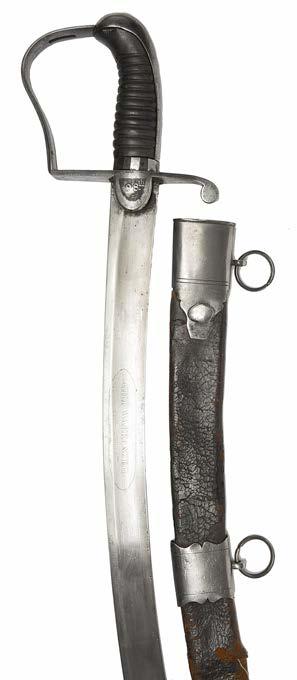
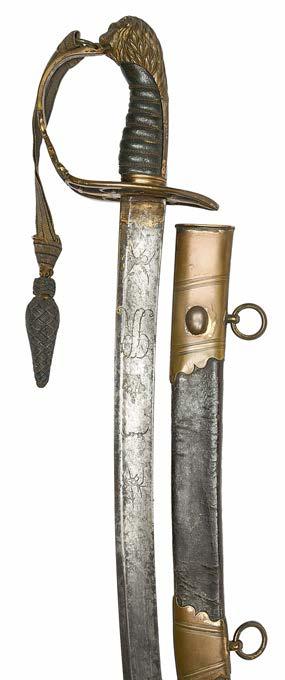



192
A Georgian light infantry officer’s sword attributable to Captain Percy Scott, 98th Foot and Isle of Wight Militia, broad and deeply curved blade 30.75 in., etched with ‘GILLs WARRANTED’ in an oval panel, steel stirrup hilt, the knuckle bow with canted edges, outer oval langet etched ‘98th’, steel mounted black leather scabbard.
Notes: Percy Scott was commissioned as an Ensign in the 98th Foot on the 22nd of July 1812, and promoted Lieutenant on the 28th of July 1815. He was subsequesntly put on half pay, and on the 17th of November 1828 he was transferred to the Isle of Wight Militia. In 1832 he was appointed CaptainCommandant of the unit, which in 1846 was granted the title Isle of Wight Light Infantry Militia.
£700900
193
A British 1803 pattern light infantry officer’s sword, curved blade 29.5 in. retaining some blueandgilt embellishment, spine marked for Runkel of Solingen, gilt brass hilt of regulation openwork form incorporating the cypher of George III, lionhead pommel, brass mounted leather scabbard retaining some gilding.
£300500
194
A British 1853 pattern cavalry trooper’s sword, slightly curved singleedged blade 35.25 in., reinforcing sleeve fitted over the ricasso, steel threebar hilt, knurled leather grips secured by washers.
£150200
195
A British 1854 pattern infantry officer’s sword, levee weight blade 32.25 in., etched decoration, giltbrass ‘gothic’ hilt with crowned ‘VR’ cypher, steel scabbard.
£80120
196
An Imperial German Naval officer’s sword, pipebacked blade 32.75 in., marked ‘DAMASTSTAHL EISENHAUER’ to the ricasso, giltbrass hilt richly embellished in relief with acanthus scrolls and a fouled anchor under an Imperial crown, folding inner and outer guards, lionhead pommel, simulated ivory grip.
£200300
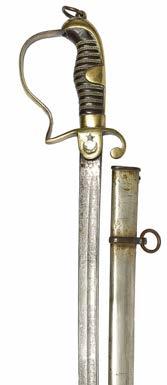
197
An Ottoman infantry officer’s sword, etched blade 29.25 in., brass stirrup hilt with oval langets the outer langet with star and crescent, polished cattle horn grip with braided wire binding, lanyard ring, steel scabbard.
£100150
198
An Eastern Mediterranean dagger (bichaq), slightly bellied blade 8 in., two back fullers, foliate etching to one side; the hilt and scabbard of paktong, impressed embellishment involving foliage and a lattice design to the hilt.
£150250
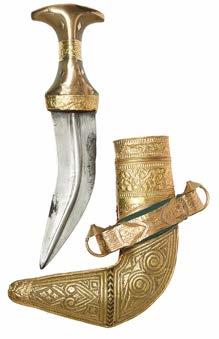
λ 199
An Omani dagger (jambiya), broad curving blade 6.25 in., rhinoceros horn hilt partclad in plain and repoussé work gold sheet, the scabbard likewise adorned with gold repoussé work and needlework.
£200300
£200300 197
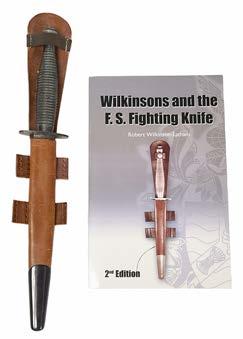
201
A Third Pattern FairbairnSykes fighting knife, by Wilkinson, doublededged blade 6.75 in., etched with maker’s details and royal arms, ringed grip, associated leather scabbard; together with a copy of ‘Wilkinson and the F.S. Fighting Knife’, by Robert WilkinsonLatham. [2]
£150200


λ 200
Four Arab daggers (jambiya), vis.: an Omani example with short curving blade, the horn hilt and the scabbard embellished with incised and repoussé work silver, characteristic suspension arrangement embodying four rings; another very similar; a Yemeni example, horn hilt with studwork decoration and set with two pseudo coins, the scabbard with applied decoration and complete with an embroidered waist belt; and a further Yemeni example, plain hide covered scabbard. [4]
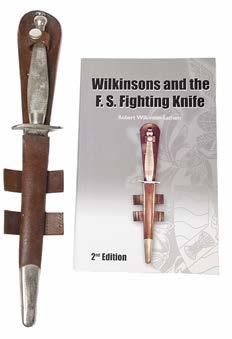
202
A first pattern FairbairnSykes fighting knife, second type, doubleedged blade 7 in. with Wilkinson’s details and royal arms etched square ricasso, curved oval cross piece, knurled grip of plated brass, associated leather scabbard with plated chape; together with a copy of ‘Wilkinson and the F.S. Fighting Knife’, by Robert WilkinsonLatham. [2]
£600800
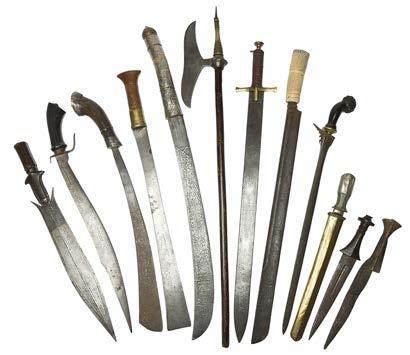
A collection of tribal edged weapons, including: a Khond axe (bulova), iron head with doublecrescent blade and striking ridge to the back of the socket; a Sumatran kris with carved horn hilt; a Naga sword (dao), broad flaring blade with square tip, a short sword of East African form, broad doubleedged blade etched with Arabic text; three various South East Asian parang; and other similar items. [11]
£300400
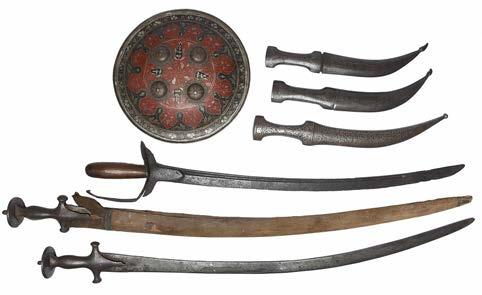
205
A small group of Indian edged weapons and associated items, comprising: two swords (tulwar), curved blades, iron hilts of ‘IndoMuslim’ form retaining traces of silver koftgari decoration, one with a fabric covered scabbard; a 19th century Persian allsteel dagger, curved watered steel blade 10 in. with medial ridge and slightly swollen point, steel hilt and scabbard with incised decoration of dense scrolling foliage inhabited by human forms and wildlife; two similar but later daggers with silver koftgari decoration; a composite sword with part of an old South Indian hilt; and a small shield (dhal). [7]
£200300
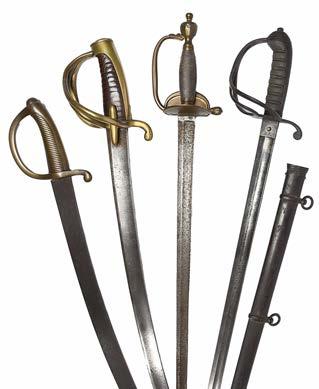
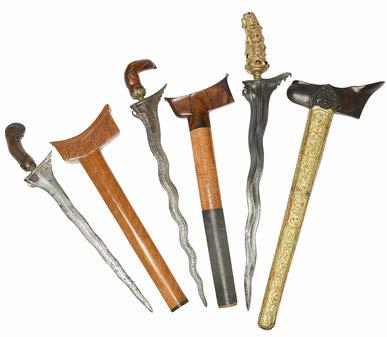
204
A Malay dagger (kris), flamboyant watered steel blade 17.25 in., ornate gilded and gemset hilt in the form of a Raksasa, hardwood scabbard with carved mendak and embossed giltmetal pendok; together with two similar, plainer, weapons. [3]
Provenance: From a private English collection, acquired in the 1950’s1960’s
£150200

206
206
Two French model 1842 bayonets, yataghan type blades, each marked for Chatellerault.1854 and 1855, steel guards and brass grips; together with a British Indian army presentation type kukri, blade with punched foliate decoration, polished horn grip with lionmask pommel, leather covered scabbard set with the emblem of the 2nd Gurkha Rifles. [3]
£80120
207
Four European military swords, vis: i) a British 1796 pattern infantry officer’s sword, spadroon type blade, giltbrass hilt with one fixed and one folding shell, slender knuckle bow and urn pommel; ii) a Victorian Royal Artillery officer’s sword, etched fullered blade, steel threebar hilt, steel scabbard; iii) a French cavalry trooper’s sword, curved blade, brass threebar hilt; iv) a French model 1804 infantry sidearm (briquet), short curved blade stamped ‘AN. 1804’, brass stirrup hilt. [4]
£300500

208
A British pattern 1853 socket bayonet, hollow triangularsection blade 17 in., socket with rotating locking rig, brass mounted leather scabbard; together with four other examples of this bayonet, without scabbards. [5]
Provenance: The George Geear Collection £150200
209
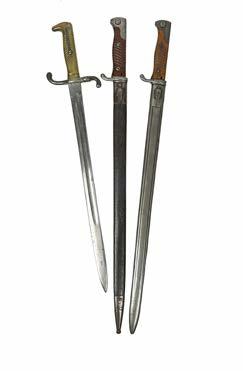
Three German sword bayonets : vis: i) a model 1871, by Weyersberg, slightly curved fullered blade 18.25 in., back stamped with Prussian control marks, cross piece stamped ‘52. R. 10. 208.’, brass grip; ii) a model 1898 n/A, by Simson & Co, slender blade 20.5 in., twopiece wooden grip, steel mounted leather scabbard; iii) another model 1898 n/A, steel scabbard. [3]
Provenance: The George Geear Collection £150200

212
Royal Navy and maritime interest: a presentation engraved silver pocket knife, ‘A. COOK from CAPT. O. BACKHOUSE C.B. XMAS 1917’, with two steel folding blades, by Walker and Hall; together with another silver pocket knife, engraved ‘Souvenir of Voyage by R.M.S. Tarquah’, with a single silver blade, Walker and Hall, Sheffield 1913; and a relief decorated souvenir pocket knife for the Red Cross Ship Henry Dunant, one side displaying the vessel, the other with details of the shipyard. [3]
Notes: Captain (later Admiral) Oliver Backhouse, C.B., was born in 1876 and entered the navy in 1890. He served (as a Lieutenant) in the Somaliland Expedition of 190304 and was promoted Commander in June 1908, and Captain in June 1914. He served in the Royal Naval Division in the siege of Antwerp in October 1914, qualifying for the 1914 Star a rare award to Naval personnel. In February 1915 he embarked for the Mediterranean with the 2nd Brigade Royal Naval Division and was made a Companion of the Bath (C.B.) for his services at Gallipoli. He commanded H.M.S. Orion at the Battle of Jutland in June 1916, and was commended for his services in the London Gazette of the 15th September that year.
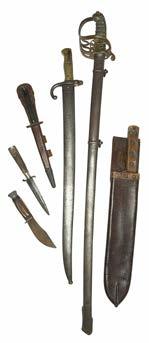
A small collection of European edged weapons, comprising: a British 1854 pattern infantry officer’s sword, etched blade with crowned ‘VR’ cypher, brass ‘gothic’ hilt retaining traces of gilding, steel scabbard; a French 1866 pattern bayonet, yataghan type blade, brass grip, steel scabbard; a British issue machete by Samuel Kitchen of Sheffield, broad blade dated 1918, grip secured by copper rivets, leather scabbard; a wooden hilted derivative of an FS fighting knife, possibly wartime RAF issue, leather scabbard with blackened copper chape ; and two stag handled knives. [6]
£150250
211
A good collection of folding pocket knives and fruit knives, including: a pair comprising knife and fork with mothero’pearl handles and silver blades, Harrison Brothers & Howson, Sheffield 1865; six further mothero’pearl and silver fruit knives; a pocket knife with blade, file, button hook and scissors, acanthus embossed silver handle, Birmingham 1892; another similar to the last, handle embossed with mistletoe; and other items. [19]
£200300

£150200 212

G.H. Daw: a .577 DawJacobs percussion sporting rifle, serial number 3417, browned twist barrel 23.75 in., with top flat matted between the sights and inscribed ‘G.H. DAW 57 THREADEEDLE STREET, LONDON’, ladder back sight, fourgroove mechanical rifling, hooked patent breech, line engraved lock inscribed ‘G.H. DAW. LONDON’, chequered half stock with iron furniture, straight hand butt with circular patch box, jag head ram rod. Section 58(2) no licence required if possessed as a curiosity or ornament.
Provenance: The George Geear collection £7001,000

Charles Lancaster: a scarce .568 Lancaster patent oval bore percussion rifle for the Australian Victoria State Force, twoband short rifle configuration, barrel 31 in., tangent back sight with vertical silver aiming line, breech stamped ‘LANCASTER’S PATENT’, London proof and bore denominator ‘25’, line engraved lock plate marked ‘CHARLES LANCASTER LONDON’, walnut full stock with steel furniture, butt plate tang marked ‘VF’ over a broad arrow and ‘288’, butt stamped twice with ‘W’ over ‘GM’ within a diamond, jag head ram rod. Section 58(2) no licence required if possessed as a curiosity or ornament.
Provenance: The George Geear collection £400600

A very rare .577 Improved Mont Storm volunteer centrefire rifle for Selwyns’s Self Ignition Cartridge, serial number 7240, barrel 32 in. with military tangent/ladder back sight, Birmingham proof, breech with forward hinged chamber raised by short handle, the top engraved ‘IMPROVED MONT STORM SELWYN’S SELF IGNITION CARTRIDGE’ in three lines, chamber locking bolt serving to drive a short firing pin captive in the rear of the chamber, vestigial nipple*, hammer serving as a cocking lever, border engraved lock plate inscribed ‘PHELPS 3 ROOD LANE LONDON’, stocked in conventional military two band configuration and with a bayonet bar to the barrel. Section 58(2) no licence required if possessed as a curiosity or ornament.
Provenance: The George Geear Collection
Notes: The presence of a nipple may indicate a dual ignition system, but the nipple does not appear to communicate with the chamber.
£1,0001,500
216

R.S.A.F. Enfield: a .577/.450 MartiniHenry Mk I Cavalry Carbine, barrel 21.5 in., back sight with leather protector, later London nitro proof, action body dated 1885 and marked ‘I. C. 1’. Section 58(2) no licence required if possessed as a curiosity or ornament.
Provenance: The George Geear Collection
£500700
Westley Richards: a scarce .500/.450 (No 2 Musket) Model 1871 improved Martini action military rifle, barrel 34.75 in. with tangent/ladder back sight and marked ‘HENRY’S PATENT RIFLING’, Nock’s form marked ‘RIFLE’ / ‘FOR No.2 CASE’, Birmingham proof, action body marked ‘WESTLEY RICHARDS PATENT’, lever safety, action lever curving under the trigger guard and with a right hand cast to fall under the thumb, military configuration full stock with steel furniture, upper barrel band with bayonet bar and lower band of Baddeley type, steel clearing rod. Section 58(2) no licence required if possessed as a curiosity or ornament.

Provenance: The George Geear Collection £500700

A late 18th century English 18 bore flintlock double sporting gun, twist barrels 29.5 in., hooked breeches with one gold and one platinum vent, retained to the stock by two wedges, engraved lock plates each inscribed ‘Harrison’, swallow tail cocks, waterproof pans, roller bearings to frizzen springs, half stock with steel furniture, engraved trigger guard with scrolling extension, chequered wrist, brass tipped wooden ram rod with concealed worm. Section 58(2) no licence required if possessed as a curiosity or ornament.
Provenance: The George Geear Collection
£400500
219

Manton: a 22 bore flintlock double sporting gun, twist barrels 33.5 in., tops inscribed ‘MANTON’ and ‘LONDON’, hooked breech with gold bands, gold lined vents, London proof, lock plates with stepped tails and each marked ‘MANTON’, roller bearing frizzens with solid bridles engraved to the outer surfaces, swannecked cocks, attenuated front trigger, chequered straight hand stock with engraved iron furniture, brass tipped wooden ram rod with worm. Section 58(2) no licence required if possessed as a curiosity or ornament.
Provenance: The George Geear Collection
£500700

220
W. Lee: a 12 bore percussion double sporting gun with patent grip safety, barrels 28 in., top rib engraved ‘W. LEE, 28 LANCASTER ST., BIRMINGHAM’, hooked breech, Birmingham proof, engraved tang with sighting groove, scroll engraved locks with ‘W. LEE’, safety lever under the grip, chequered stock with engraved steel furniture, brass tipped wooden ram rod with concealed worm. Section 58(2) no licence required if possessed as a curiosity or ornament.
Provenance: The George Geear Collection £150200
221

Newton: a 12 bore pinfire double gun, browned twist barrels 30 in., top rib inscribed ‘NEWTON, KING ST MANCHESTER’, Birmingham black powder proof, double grip rotary underlever action with back action side locks all engraved with game scenes and scrolls, chequered straight hand stock with engraved steel furniture and horn foreend cap. Section 58(2) no licence required if possessed as a curiosity or ornament.
Provenance: The George Geear Collection £150200
Ƒ

Danzig: an 8x57mm German Model 1888/05 bolt action service rifle, serial number 4540, shrouded barrel 29.25 in., ladder back sight, straight bolt handle, charger guide conversion, action ring stamped ‘S’ and with Turkish service markings, 2025 Birmingham proof. Section 1 A Firearms Certificate or RFD Authority is required to purchase this lot.
Provenance: The George Geear Collection £200300

Ƒ
Winchester: a .44WCF (.4440) Model 1892 lever action rifle, serial number 821228, round barrel 20 in., ladder back sight, tube magazine, saddle ring to the left side of the action body, model and manufacturer’s name inscribed to the top strap, steel butt plate, 2025 Birmingham proof. Section 1 A Firearms Certificate or RFD Authority is required to purchase this lot.
Provenance: The George Geear Collection

£300400 Ƒ 224
R.S.A.F. Enfield: a .303 Martini Metford Mk III Artillery Carbine, serial number 2388B, barrel 21 in. with tangent/ladder back sight, action dated 1879 and 1894 (date of conversion from .577/.450), clearing rod, soldoutof service mark, 2025 Birmingham proof. Section 1 A Firearms Certificate or RFD Authority is required to purchase this lot.
Provenance: The George Geear Collection £150250


Steyr: an 8x50mmR Austrian Model 1895 Mannlicher straight pull service rifle, serial number 9141S, barrel 31.25 in., ladder back sight, straightpull action with knurled cocking piece and magazine to take enbloc clips, full stock, upper barrel band with bayonet bar and piling rod, 2025 Birmingham proof. Section 1 A Firearms Certificate or RFD Authority is required to purchase this lot.
Provenance: The George Geear Collection £150250
Ƒ
Savage Arms: a .303 Savage Model 1899 lever action sporting rifle, serial number 32.468, octagonal barrel 26 in., rotary magazine, roundcount indicator on the left side of the action, action lever with locking bolt, twopart stock, steel crescent butt plate, Birmingham proof. Section 1 A Firearms Certificate or RFD Authority is required to purchase this lot.
Provenance: The George Geear Collection £150200

B.S.A.Co.: a .303 S.M.L.E. Mk III* service rifle, serial number 5886, dated 1918, early type round cocking piece, brass butt roundel with unit marking ‘RASC 34 Co 75’, 2025 Birmingham proof. Section 1 A Firearms Certificate or RFD Authority is required to purchase this lot.
Provenance: The George Geear Collection £250350

Ƒ
R.O.F. Maltby: an early production British .303 No4 Mk I bolt action service rifle, serial number C17826, barrel 25.25 in. with two groove rifling, left side of action body marked ‘R.O.F. M. No. 4. MK. I. 1941.’, early type round cocking piece, Mk I back sight, 2025 Birmingham proof. Section 1 A Firearms Certificate or RFD Authority is required to purchase this lot.
Provenance: The George Geear Collection £300500

R.O.F. Fazakerly: a .22LR Rifle No 8 variant training rifle, serial number CR3248694, heavy barrel 21.75 in., modified No 5 action with short bolt travel and grooved single loading platform, action body marked ‘RIFLE AIMING .22” L2A1’*, fitted with a Parker Hale 8/53 windage adjustable backsight and PH 62 sixhole diopter eyepiece with saucer diffuser**, 2025 Birmingham proof. Section 1 A Firearms Certificate or RFD Authority is required to purchase this lot.
Provenance: The George Geear Collection
Notes: * The L2A1 designation applies to a barrelled action, itself converted from a No 8, used as part of a subcalibre insert for training artillery or tank crews in aiming the 120 mm gun. Presumably this action was so employed before being reconverted to No 8 specification.
** the large saucer diffuser prevents the bolt from closing unless the back sight is folded down, but is not essential to aiming and may be removed. £300500

Radom Arms Factory: a 7.62x54mmR Model 1944 MosinNagant carbine, serial number KD23765. barrel 20.25 in., tangent back sight, dated 1953, straight bolt handle, folding bayonet, a Polish production example of a Russian model, later Birmingham proof. Section 1 A Firearms Certificate or RFD Authority is required to purchase this lot.
Provenance: The George Geear Collection £150200
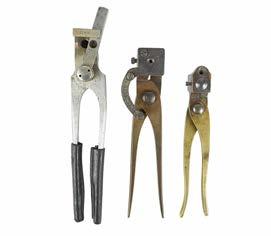
Three bullet moulds, scissors type, vis.: a steel mould to cast an 11 mm threecannelure conical bullet; ii) a brass mould to cast a round nosed bullet of approximately 11 mm with a hollow base, automatic sprue cutter and fixed base plug; iii) a brass mould to cast a hollow based bullet, articulated base plug and angled side channel for pouring lead, mould block marked No 30. [3]
Provenance: The George Geear Collection
£150200
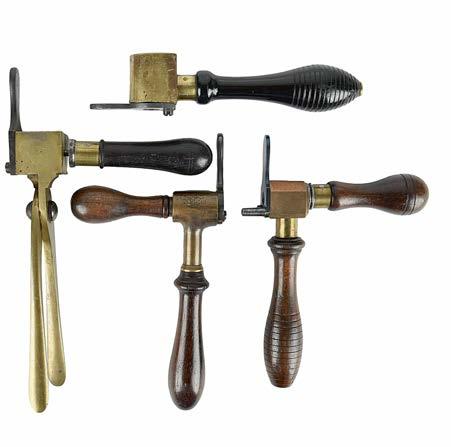

234
Bullet moulds (3): i) a large steel gang mould to cast six twocannelure 72 bore conical bullets, hinged steel blocks with hardwood handles; ii) a brass and mould to cast twelve 38 bore spherical bullets, brass blocks with steel arms; iii) a brass doublesided gang mould to cast thirty 7mm spherical bullets, scissors type. [3]
Provenance: The George Geear Collection
£200300
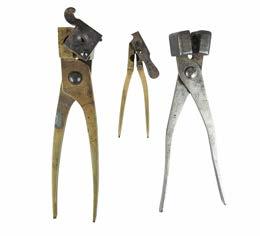
232
Three winged bullet moulds, each casting a projectile for use in a mechanically rifled arm: i) steel, 16 bore, ovoid bullet with two wings, numbered 2069; ii) brass, twowinged bullet of approximately .65 calibre, steel sprue cutter; iii) brass, 84 bore twowinged bullet, numbered 2428, steel sprue cutter; together with a quantity of vintage shot measures and powder measures, mainly of ladle type with adjustable sliding drums, three of tubular form in brass with adjustment by way of plungers marked with graduated scales; also with a ‘Prochrono’ shooting chronograph, boxed; together with a sporting rifle stock blank. [20]
Provenance: The George Geear Collection
£200400
233
A small collection of vintage shotgun and rifle cartridge loading tools, comprising: a Cocker patent 12 bore combination tool, brass with steel lever and wooden handle, patent 5535 of 1884; two Hawksley type table standing decapping and recapping tools, twin columns and double function levers supported by a frame, one 20 bore and the other 12; a Hanbury Barclay type wad loader for 16 bore pinfire, tubular brass body with internal ‘fingers’ to guide the wad through the case mouth, wooden pusher; a nickelplated bullet seater with opensided tubular body and hand screw; and three other similar tools; together with a group of bullet moulds, comprising: a mould to cast a 60 bore winged bullet for the DawJacobs rifle, singlepiece brass mould block impressed ‘G.H. DAW’S IMPROVED MOULD’, steel sprue cutter, tuned ebony handle; a mould with a brass singlepiece block for casting a 38 bore round nosed hollowpoint bullet, block impressed ‘No 38’, steel sprue cutter, screwin nose plug, block and plug each with turned mahogany handle; another similar mould for casting a 44 bore hollow round nosed bullet; and a brass scissor type mould for casting a 10 bore hollow nosed bullet with three cannelures, one arm stamped ‘No 10’, steel sprue cutter, separate nose plug with turned mahogany handle. [12]
Provenance: The George Geear Collection £200300
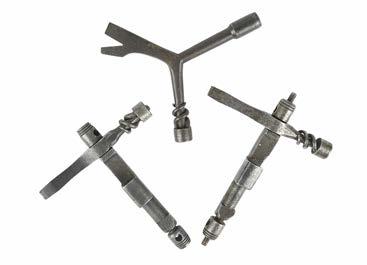
235
A combination tool for Lovell’s percussion arms, Yshaped and incorporating nipple key, pricker, turnscrews and worm, Ordnance marked; together with two Pattern 1853 rifle combination tools, sergeant’s type including cramp, one Ordnance marked, the other unmarked and possibly a later reproduction. [3]
Provenance: The George Geear Collection
£150200
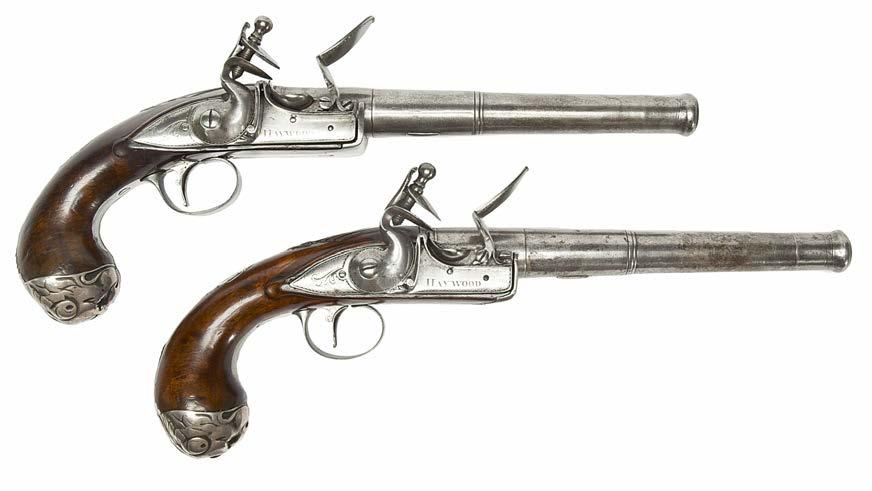
236
A pair of 18th century silver mounted flintlock pistols, of socalled ‘Queen Anne’ type, round turnoff barrels 7.5 in., swollen muzzles, private proof marks, the tops engraved ‘BROUGHTON’; side locks with short borderengraved lock plates signed ‘HAYWOOD’ and with acanthus scrolls to the tails, inverted frizzed springs, swannecked cocks; short stocks of walnut reinforced with steel plates conforming to the barrel channels and the forward edges of the lock plates and extending back to support the trigger guards, embossed silver side plates depicting trophies of arms, silver lion mask butt caps; first half of the 18th century. [2] Section 58(2) no licence required in the UK if possessed as a curiosity or ornament.
£3,5004,500
237
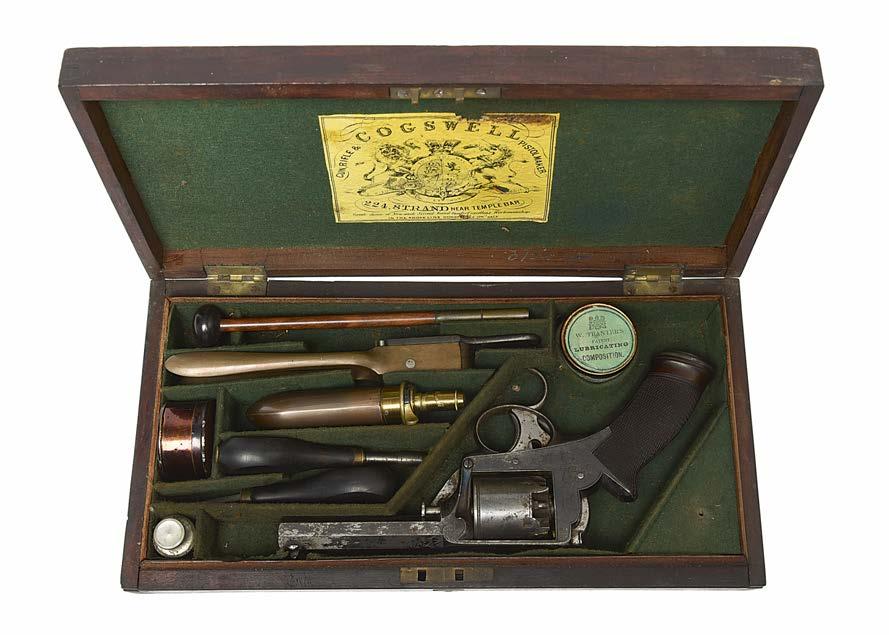
A 84 bore fiveshot Tranter patent doubletrigger percussion revolver retailed by B. Cogswell, serial number 3,784 T, sighted octagonal barrel 4 in., top strap engraved ‘B. COGSWELL. 224 STRAND. LONDON.’, frame engraved with acanthus scrolls, cylinder with roped front border, London proof, second model rammer, chequered grip; in a fitted and green baise lined case with associated accessories including: bullet mould, oil bottle, loading rod, powder flask, and other items; Cogswell trade label (possibly later). Section 58(2) no licence required in the UK if possessed as a curiosity or ornament.
£700900

Francisco Targarona of Madrid: a fine and rare cased pair of Spanish 22 bore convertible ‘Madrid’ lock pistols from the personal collection of Prince Augustus Frederick 1st Duke of Sussex (17731843), each with a 13 inch twostage octagonaltoround barrel, the breech stages named to the Prince in gold inlay ‘DE. S.A.R.P. AUGUSTO’, and with the maker’s gilded seal marks (punzón) all amid geometric and floral accents in gold, divided from the round upper stages by bands of foliate moulding, gold sighting beads at the muzzles, gold lined touch holes; the locks with internal mainsprings and sears projecting through the lock plates, serpentine cocks with ringhead jaw screws, the breasts with projecting spurs to engage the halfcock sears, flying scrolls rising to meet the undersides of the jaws, all with fine foliate engraving and the plates inscribed ‘FRANCO. TARGARONA’ and with a monogram for MADRID; walnut fullstocks with finely engraved steel furniture including trigger guards with ornate finials recessed into moulded borders in the stocks, scrolling side plates engraved with bell husks, and heavy butt caps with long spurs, moulded details to the ram rod channels, steel mounted ram rods; one of the pair with a separate fluted shoulder stock interchanging with its pistol butt by means of a bayonet fitting and having a threaded muzzle under a screw off cover to receive the removable barrel of the other pistol, all resulting in the conversion of the first pistol into a carbine or fowling piece; in a close fitted velvet lined mahogany case with an oval silver plate to the lid engraved ‘PURCHASED AT THE SALE OF His Royal Highness The Duke Of Sussex, 1845’, the base with three flush drawers, one drawer fitted to accommodate a very fine velvet shot bag by Carlos Montargis, the steel head with fluted and engraved spout and a sprung shutter with shell thumbpiece, the arm of the shutter engraved ‘Montargis’; 1790s.
Notes: Prince Augustus Frederick (17731843), was the 6th son of King George III and became Duke of Sussex on the 24th of November 1801. He was notable in his day as an enlightened thinker and abolitionist. He was a supporter of his niece, the popular but unhappy Princess Charlotte, in her struggles with her father the Prince Regent, and he enjoyed the honour of giving away his great niece Queen Victoria on her wedding day. The Duke died in 1843 and the sale of his chattels was conducted by Messrs Christie and Manson over thirteen days at their King’s Street, St James’s premises. Saturday, 1st of July was devoted to ‘Arms and canes’ and the pistols offered here appeared as lot 655 among a total of 110 weapons of various kinds. It is probable that this fine suite, with its gold inlaid dedications ‘DE. S.A.R.P. AUGUSTO’ was presented to him as a diplomatic gift at some point prior to the outbreak of hostilities between Britain and Spain in 1796. The Prince spent much of his early life on the continent, and his correspondence shows that in 1790 he was the guest of María Luisa of Spain, Queen Consort of Hungary, daughter to King Charles III and brother to King Charles IV of Spain, who became Holy Roman Empress later that year. Augustus appears to have enjoyed María’s friendship, and this cordial connection to the royal court of Spain may lie behind the gift of these pistols.
Francisco Targarona was prominent among the elite gun makers of Madrid, where he was active from c. 1778. In 1792 he was appointed gun maker to King Charles IV of Spain (Arcabucero de su Magestad) in succession to Francisco Antonio García with whom he had trained under Francisco López. He joined Diego Alvarez, Juan de Soto and Isidro Soler in the Royal Household. These men were part of a lineage of outstanding craftsmen with its origins in 1530, in which year the Holy Roman Emperor Charles V, who ruled Spain as King Charles I between 1516 and 1556, brought the brothers Simon and Peter

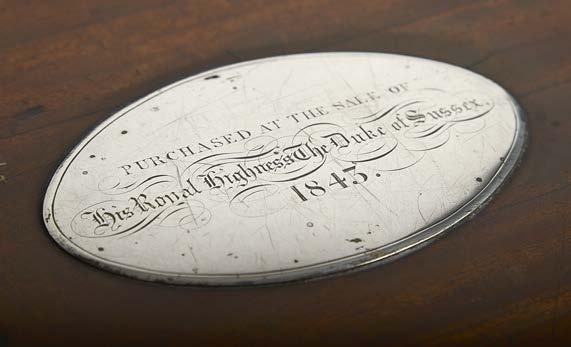
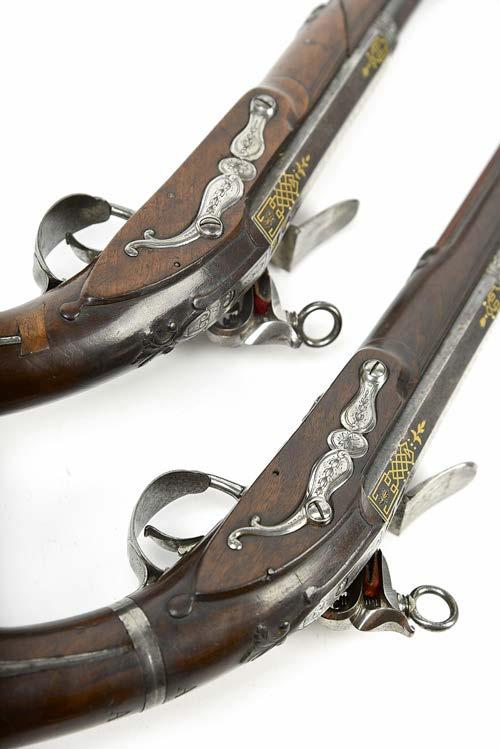
Marquarte from the important gun making centre of Augsburg, to Madrid, where they established one of the finest fiream manufacturing traditions in the world. The terminal date of Targarona’s floruit is uncertain, but he did not survive the violence and upheaval of the first decade of the 19th century.
The characteristic lock constructed by the Spanish makers is the type known to collectors as the Miquelet lock, distinguished by an external mainspring and sears that act laterally through the lock plate. The Madrid lock – a term of convenience employed by the late W. Keith Neal – is a scarce variant form of the Miquelet in which the lateral sears are retained but the mainspring is internal. The cock has the appearance of a conventional (French) flintlock, differing in having discrete projections to engage with the sears. Refined locks of this type were particular to the best Madrid makers between about 1700 and 1800, and are found on arms of the highest quality. The fluted shoulder stock is also typical of Madrid. The system for converting the two pistols into a single short gun is ingenious: the donor pistol has, instead of a true octagonal breech section, a sleeve of the same form, out of which its continuously round barrel is drawn after the key fastener is removed. The breech plug is shallow and slotted at the rear and may easily be removed to expose the female threads. The receiving pistol has a threaded muzzle, concealed in normal use, onto which the donated barrel screws to form a perfect fit. The ram rods are combined in a similar manner, and the butt of the pistol grip is replaced by the shoulder stock. This exhibits a truly remarkable standard of workmanship.
£20,00030,000


Agostino Bustindui (17401802): a very fine Spanish ‘miquelet’ lock sporting gun, twostage barrel 34.5 in., the hexagonal lower stage giving way to a round upper stage having at its base a band of leaf sprays in low relief against a gilded ground, slightly flared muzzle, nickelsilver bead sight with gold inlaid accents on each side, the breech inlaid in gold with scrolling ornaments and bearing the maker’s gilt seal marks (punzón); the steel lock dated 1792 and with characteristic external mainspring and transverse sears acting through the plate, all parts richly embellished with a combination of relief and incuse carving retaining some gilding, punzón of Miguel Castaño to the plate and to the front of the steel; halfstock with curving butt, nickelsilver furniture including a barrel band engraved with acanthus scrolls and the name ‘MANZANERO’ and a band spring projecting from the mouth of an inlaid dolphin, engraved steel trigger guard and butt plate; bone tipped wooden ramrod retained against the barrel by an ornate steel pipe.
£7001,000

240
H. Nock: a rare .650 flintlock volunteer rifled carbine of Baker type with Nock’s patent screwless lock, barrel 25.5 in with standing back sight on a shaped foot and bayonet bar, sevengroove rifling, Nock’s Patent breech so marked on the top flat, enclosed screwless lock engraved ‘H. Nock’ and with an eightpointed star, walnut stock with brass furniture and iron sling swivels, trigger guard engraved ‘No 461’ and butt plate tang engraved ‘31’, butt comb with horse hair filled leather pad, iron ram rod. Section 58(2) no licence required in the UK if possessed as a curiosity or ornament.
£3,0004,000
241

A .750 flintlock India Pattern musket, barrel 39 in., lock marked ‘TOWER’ across the tail and with crowned ‘GR’, ringneck cock, walnut stock with brass furniture, iron ram rod; together with a socket bayonet of corresponding pattern. [2] Section 58(2) no licence required in the UK if possessed as a curiosity or ornament.
£1,2001,600

242
A British .75 India Pattern musket, barrel 39 in., bevelled lock plate marked ‘Tower’ across the tail and with crowned ‘GR’, swanneck cock, stock with regulation brass furniture, iron ram rod, c. 1800. Section 58(2) no licence required if possessed as a curiosity or ornament.
£8001,200

243
A 19th century Belgian .69 flintlock musket, round barrel 36 in. with short hexagonal section at the breech, flat lock with ringnecked cock, fullstock with brass furniture including barrel bands with steel retaining springs, appears smoothbore but control marks indicate a rifled arm. Section 58(2) no licence required in the UK if possessed as a curiosity or ornament.
£200300

244
A 19th century Austrian flintlock sporting gun, twostage barrel 29.5 in. bifurcated back sight with leaf foot mounted on a band, stepped lock inscribed ‘Brecht Weimar’, swannecked cock, scrolling trigger, walnut full stock with horn nose cap, engraved brass furniture, trigger guard with scrolling extension, carved foliate details to the butt and apron, carved border to the ram rod channel, patch box with sliding cover, horn tipped wooden ram rod. Section 58(2) no licence required in the UK if possessed as a curiosity or ornament.
£300500

245
Manufacture Royale d’Armes d’SaintÉtienne: an 18th century French .650 flintlock cadet musket, barrel 30.5 in., breech tang dated 1778, bevelled lock inscribed ‘Manuf. Royale d. St. Étienne’, ringnecked cock, full stock with brass furniture, butt stamped ‘MAS’ over ‘1778’, steel ramrod. Section 58(2) no licence required in the UK if possessed as a curiosity or ornament.
£300500

246
John Probin: an early 19th century flintlock blunderbuss, brass twostage hexagonaltoround barrel 15 in., an astragal to the rear of the swollen muzzle, the left shoulderflat of the breech struck with the ‘I.P’ mark of John Probin of London (floruit 1826 c.1847) and ‘PROVED’ in two lines; flat lock with border engraving and stepped tail and signed ‘J PROBIN’, swannecked cock engraved with an acanthus scroll; walnut stock with engraved brass furniture, the butt plate tang well embellished with scrolls and a stepped border, the side plate similar, oval brass escutcheon with beaded border, horn tipped wooden ram rod. Section 58(2) no licence required in the UK if possessed as a curiosity or ornament.
£1,5002,000
247

An English flintlock blunderbuss, brass twostage hexagonaltoround barrel 14.5 in., flaring muzzle, top flat of the breech engraved ‘MAIDSTONE’, ordnance commercial proof marks, lock with bevelled plate engraved with scrolling foliage at the tail, swannecked cock; walnut cock with wellengraved brass furniture, trigger guard with acorn finial, openwork side plate; c. 1800, with associated steel ram rod. Section 58(2) no licence required in the UK if possessed as a curiosity or ornament.
£1,2001,600
248

A 19th century English percussion double coach gun, sidebyside barrels of approximately 12 bore shortened to 16.5 in., hollow top rib inscribed ‘W. LEE MAKER’, breakoff breeches, Birmingham proof, locks engraved with game scenes, chequered walnut stock with steel furniture, brass tipped wooden ram rod.
£150200
249

A British .66 percussion Yeomanry Carbine of 1844, sighted barrel 20 in., breech stamped with control marks and ‘1844 ENFIELD’, lock marked with crowned ‘VR’ and ‘TOWER 1844’, walnut fullstock with brass furniture, butt plate engraved ‘D.Y.C.’ over ‘W’ over ‘18’, steel saddle bar with captive ring, stock with various stamped markings including a Board of Ordnance mark to the butt and ‘S. BUTLER’ below the saddle bar, barrel retained by two key fasteners, captive steel ram rod. Section 58(2) no licence required in the UK if possessed as a curiosity or ornament.
£500600
250

A percussion conversion Austrian rifled cavalry carbine, sighted barrel 14 in., drum and nipple conversion from flintlock, flat lock with date mark for 1855 and spurious British Tower marks, stock with steel furniture including a double saddle ring mounted on a combined side plate and saddle bar. Section 58(2) no licence required in the UK if possessed as a curiosity or ornament.
Notes: Large number of this model was sold out of Austrian service to Union forces during the American Civil War. They later circulated in the commercial market and it seems that the ‘Tower’ marks were added by the Birmingham trade to increase their appeal.
£150250

251
A British .577 1853 Pattern riflemusket, second model with solid barrel bands retained by springs let into the stock, tangent/ladder back sight, regulation brass furniture and button head ram rod. Section 58(2) no licence required in the UK if possessed as a curiosity or ornament.
£200300

252
A British .577 1856 Pattern short rifle, barrel 33 in. with threegroove rifling and bayonet bar to the right, tangent/ladder back sight, lock dated 1869 and engraved with a crown and light scrolling foliage, snap cap on chain, iron furniture, screw clamping barrel bands, jag head ram rod. Section 58(2) no licence required in the UK if possessed as a curiosity or ornament.
£200300

253
Westley Richards: a commercial .577 percussion rifle of service type, barrel 32.5 in., Birmingham single definitive proof mark, tangent/ladder back sight, lock marked ‘WESTLEY RICHARDS & CO’, upper screw clamping band and lower Baddeley band, stocked to within 1.5 in. of the muzzle, brass furniture, steel ram rod with square section jag head. Section 58(2) no licence required in the UK if possessed as a curiosity or ornament.
£300400

254
A British 1858 pattern (converted) Indian service percussion musket, originally an 1853 pattern riflemusket, the barrel bored smooth and fitted with a simple standing back sight, lock plate dated 1860, stocked in second model configuration with solid barrel bands retained by springs, brass furniture, steel button head ram rod. Section 58(2) no licence required in the UK if possessed as a curiosity or ornament.
£200300

255
A 19th century Indian .660 percussion musket configured in the manner of the first model Brunswick rifle, barrel 35.5 in. with breakoff breech and bayonet bar, back sight removed, back action lock with line engraved border, full stock with brass furniture, key barrel fasteners passing through rectangular brass escutcheons, steel ram rod. Section 58(2) no licence required in the UK if possessed as a curiosity or ornament.
£200300
256

John Dickson & Son: a .45 Long Chamber AlexanderHenry falling block sporting rifle, round barrel 23.75 in. with one fixed and one folding leaf backsight on an island block, inscribed ‘ALEXR. HENRY. 12 SOUTH ST. ANDREW ST. EDINBURGH PATENT NOS. 1471 AND 367.’, Birmingham proof, finely scroll engraved action, righthanded backaction lock with fine scroll engraving and ‘JOHN DICKSON & SON’, lock plate shaped to conform to the taper of the grip, safety bolt, action lever latching to the trigger guard, chequered half stock of wellfigured walnut with horn foreend cap and vacant silver escutcheon. Section 58(2) no licence required in the UK if possessed as a curiosity or ornament.
£2,0003,000
257

John Rigby & Co: a fine .500 Black Powder Express double hammer rifle, serial number 13545, barrels 26 in., flat matted top rib with one fixed and one folding leaf backsight and engraved ‘JOHN RIGBY & CO DUBLIN & LONDON’, border engraved breeches; scroll engraved underlever action, back action locks with nonrebounding hammers and safety bolts, lock plated engraved ‘JOHN RIGBY & CO.’, long top strap; chequered walnut pistol grip stock with engraved steel furniture, butt with toe and heel plates, foreend with key fastener; in a fitted leather covered and brass bound case, relined interior with later accessories including turnscrews and steel oil bottle. Section 58(2) no licence required in the UK if possessed as a curiosity or ornament.
Notes: Completed in September 1870 for Captain D. McEvoy.
£2,4002,800

258
A British .577/.450 MartiniHenry artillery carbine, barrel 21.25 in., tangent/ladder back sight graduated to 1,800 yards, bayonet bar on upper barrel band. Section 58(2) no licence required in the UK if possessed as a curiosity or ornament.
£200300
259

A deactivated 7.62x54R MosinNagant service rifle, dated 1938, serial number C103667, barrel 29 in., tangent back sight, standard military configuration, with current EU deactivation certificate dated 01/10/2024. No licence required in the UK.
£200300
260

A percussionconversion smoothbored carbine, twostage barrel 29 in., breakoff breech, drumandnipple percussion conversion; flat lock with stepped tail, converted from flintlock with a later hammer, later signed ‘Gill’; set up in a military configuration with a twopart full stock divided at the centre with brass plates, brass furniture, trigger guard with acorn finial, the wrist with an old repair involving iron straps and a reinforcing plate opposite the lock, iron ram rod.
£100150

B.S.A. Co.: a commercial .303 Magazine LeeMetford (Enfield) Mk II bolt action service rifle, serial number 23278, secondary barrel 30.25 in. with Enfield rifling, tangent/ladder back sight, bolt with dust cover and round cocking piece, magazine cutoff, no safety catch, eightround magazine, long range volley sights, butt socket impressed ‘B.SA. Co.’, stocked in standard service configuration with bayonet bar for the Pattern 1888 bayonet, piling swivel, butt plate with trap, butt plate tang impressed ‘BLANCH & SON LONDON’ (retailer) and with the initials ‘W.C.F.’, Birmingham nitro proof. Section 1 A Firearms Certificate or RFD Authority is required to purchase this lot.
Notes: Established in 1809, John Blanch & Son is one of the oldest of the London gun makers. The firm also retailed weapons, including various models of Lee actioned rifles. ‘W.F.C.’ was presumably the original owner.
£700900
Ƒ 262

R.S.A.F. Enfield: an extremely rare .303 LeeMetford (Enfield) Mk I boltaction cavalry carbine issued to the 2nd Life Guards, serial number 9090B, action dated 1895, secondary (1902) barrel 20.75 in. with fivegroove Enfield rifling, tangent/ladder back sight graduated to 2,000 yards, bolt with dust cover and turned down handle with flattened knob, safety catch on cocking piece, magazine cutoff, sixround magazine with link loop in front, Dring to the left of the butt socket, sling bar let into right of butt, delta metal butt plate with trap, full stock with springretained barrel band, nose cap incorporating low foresight protector wings and extending to shroud the end of the barrel, clearing rod passing through nose cap, Nock’s form and bolt stamped ‘M.T. 94’ (Morris Tube), butt socket impressed ‘ENFIELD’ over ‘1895’ over ‘I’ all under a VR crown, brass butt disc impressed ‘4.96’ over ‘2ND L.G’ over ‘2’, barrel and action with Victorian Ordnance proof and inspection marks, 1989 Birmingham Nitro proof. Section 1 A Firearms Certificate or RFD Authority is required to purchase this lot.
Notes: The Carbine, Magazine, Lee Metford Mk I, for cavalry only, was approved on the 29th of September 1894. Limited numbers were produced before the Dring sling loop on the butt socket was deleted from the specifications in March 1896 and armourers were given instructions for removing them from existing specimens. A large proportion of these carbines were further modified to the LeeEnfield carbine specification by the removal of the sling bar on the butt and any remaining Dring sling loops, by the addition of screws to secure a leather cover for the back sight, and by changes in other particulars. Yet others were more radically converted for issue to the Royal Irish Constabulary or to colonial forces. The carbine offered here is, therefore, an extremely rare survivor retaining (with the exception of the barrel) its original features. It was once paired with a Morris Tube subcalibre insert for short range target practice, and the butt disc shows that it was issued, in April 1896, to the 2nd Life Guards as carbine number 2. £2,5003,500
Ƒ 263

B.S.A. Co.: a .303 S.M.L.E. Mk III* bolt action service rifle, serial number A93326, dated 1916, later target barrel 25 in., by B.S.A. and fitted by Martin, bolt with round cocking piece, butt socket impressed ‘B.S.A. Co’ over ‘1916’ over ‘SHT. L.E.’ over ‘III*’ all under a GR crown, full stocked in standard service configuration, vacant brass butt disc, Birmingham military nitro proof. Section 1 A Firearms Certificate or RFD Authority is required to purchase this lot.
£300500
264

Holland & Holland: a .22LR break action rook rifle, serial number 21400, octagonal barrel 26 in., converted with a liner from .295 semismooth bore, one standing and two folding back sights, inscribed with the maker’s name and address and ‘WINNERS OF ALL THE ‘FIELD’ RIFLES TRIALS’, threaded muzzle, action richly engraved with acanthus scrolls and with ‘HOLLAND & HOLLAND’ to banners on each side, automatic safety with gold ‘SAFE’, chequered walnut pistol grip stock with oval cheek piece, Birmingham proof. Section 1 A Firearms Certificate or RFD Authority is required to purchase this lot.
£9001,200

Ƒ 265
Greener: a .22 Hornet Martini action takedown sporting rifle, serial number 013961, round barrel 26 in., one standing and two folding back sights, border engraved action with safety catch, split action body with clamping screw to release barrel, chequered straight hand stock, later fitted scope rail (prevents removal of barrel) with a Pecar 4 power telescopic sight, Birmingham proof. Section 1 A Firearms Certificate or RFD Authority is required to purchase this lot.
£300400

Ƒ 266
Westley Richards: an early and rare 12 bore barinwood double hammer gun, serial number 12058, slightly swamped barrels 30 in., top rib inscribed ‘PATENT’ and ‘WESTLEY RICHARDS. 170. NEW BOND ST. LONDON’, doll’s head extension, scroll engraved fences, inclined strikers reset by the extractors on closing, pivoting action lever inscribed ‘WESTLEY RICHARDS PATENT’, scroll engraved sidelocks signed ‘WESTLEY RICHARDS’, dolphinhead hammers falling in a manner evocative of a pinfire gun, chequered stock of well figured walnut extending to cover the bar and meeting the keyfastened foreend in a wellformed knuckle joint, steel butt plate; in a leather covered oak gun case, the beize lined fitted interior with trade label and maintenance instructions to the lid. Please note that this gun is not offered as serviceable and should not be fired. It is offered as a collector’s gun only, accompanied by its proof exemption certificate. Section 2 A Shotgun Certificate or RFD Authority is required to purchase this lot.
Notes: Please note that this rare and collectable gun, built in 1869, has been exempted from proof by the Birmingham Proof House on the grounds that it “is not intended to be fired, is unlikely to withstand the proof test and might be severely damaged if subjected to proof”. The gun is not offered for sale as servicable, and should not be fired. A valid Shotgun Certificate or RFD status is nonetheless required for purchase. Offered with a copy of Westley Richards’ order book confirming the date of manufacture, a covering letter from the maker dated 1983, and the Birmingham Proof House certificate dated 1991.
£500700
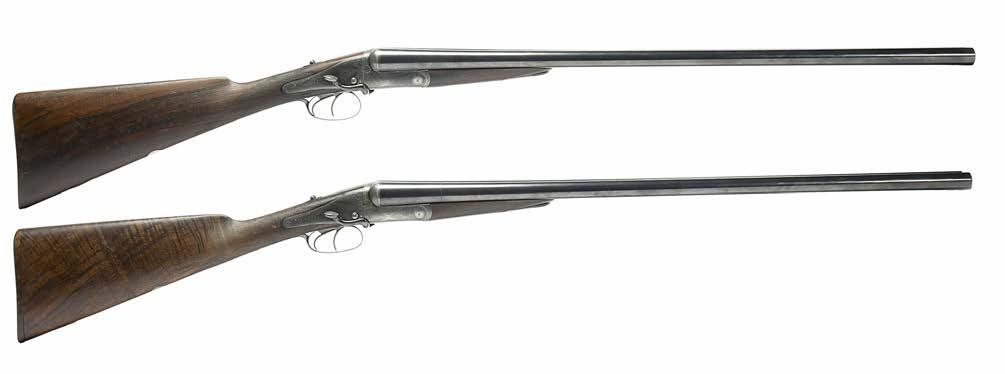
Boss & Co.: a pair of 12 bore side lock ejector double sporting guns, serial numbers 3989 and 3990 and numbered 1 and 2 to the top ribs, sleeved barrels 28 in., top ribs inscribed ‘BOSS & Co 73 ST JAMES’S STREET LONDON’, 2.5 in. chambers, side lever actions and back action side locks with fine foliate scroll engraving, lock plates inscribed ‘BOSS & Co’, automatic safeties with gold ‘SAFE’, walnut straight hand stocks, lever release foreends; in their original and named fitted leather case with some associated accessories, and a copy of the maker’s record. Section 2 A Shotgun Certificate or RFD Authority is required to purchase this lot.
Notes: The maker’s records show that these guns were ordered in 1888 by Selwyn R. Pryor Esq. This agrees with the name on the lid of the case.
£600800
Ƒ 268
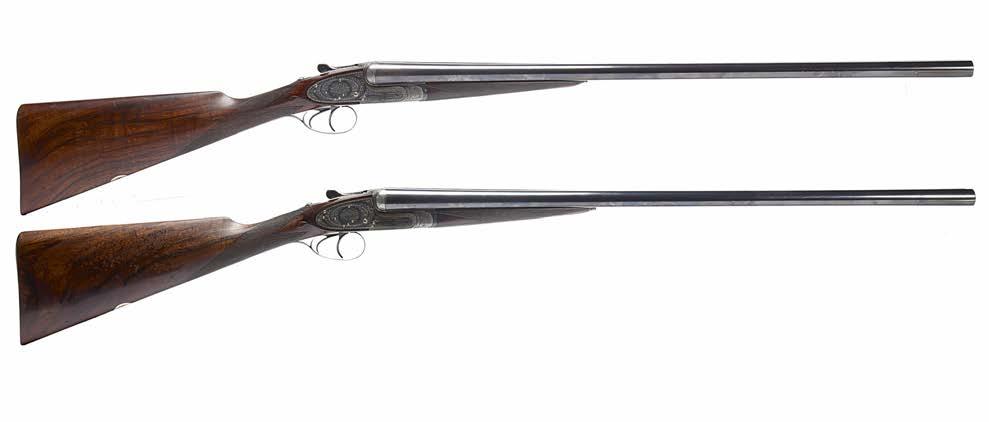
Charles Lancaster: a fine pair of 12 bore assisted opening sidelock ejector double sporting guns, serial numbers 17310 and 17311 and numbered 1 and 2 in gold to the top ribs, action levers and foreends; barrels 28 in., inscribed ‘CHARLES LANCASTER’ and ‘7 BURY STREET. ST JAMES. LONDON.’, 2.5 in. chambers, scroll engraved fences with moulded acanthus bands, automatic safeties with gold ‘SAFE’, locks and actions finely and profusely engraved with scrolling foliage and floral bouquets, locks signed ‘CHARLES LANCASTER’, chequered straighthand stocks with engraved steel furniture, Anson release foreends, gold escutcheon engraved ‘N.W.’, London nitro proof; in a best leather covered and brass bound double gun case with fitted interior and Stephen Grant and Joseph Lang trade label, a silver presentation plaque inscribed “AUGUST 2ND 1936 / TO NEVILLE FROM ROBBIE” and with a personal dedication (hallmarked London 1935), accessories including a steel oil bottle, leather bound canvas field cover, lid and cover both initialled ‘G.N.C.W.’; also with a single gun case and cover, constructed and appointed to match and with identical silver presentation plaque. Section 2 A Shotgun Certificate or RFD Authority is required to purchase this lot.
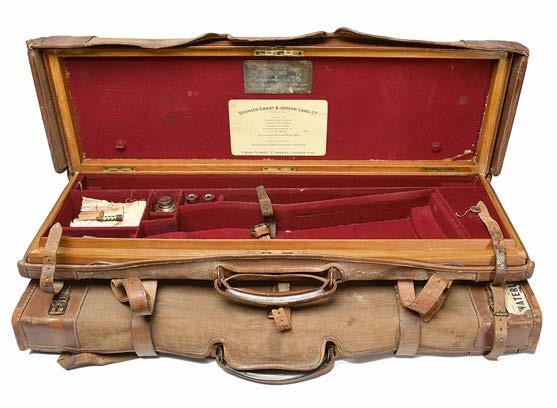
Provenance: Lieutenant Colonel George Neville Clive Wigram, M.C., 2nd Baron Wigram.
Notes: Lieutenant Colonel George Neville Clive Wigram, M.C., Grenadier Guards, 2nd Baron Wigram, received these guns together with the fly rod in lot 294 as a 21st Birthday present from Robert Grant, 2nd Baronet Grant of Forres, in 1936. He was commissioned in the Grenadier Guards in the following year, and served with great distinction in the Second World War, winning a Military Cross in 1945. See also lot 288.
£2,5003,500

Ƒ 269
E. M. Reilly & Co., a 12 bore underlever action double hammer gun, serial number 15350, ‘damacus’ barrels 30 in., 2.5 in. chambers, acanthus engraved action and locks, the lock plates further engraved with game birds and ‘E.M. REILLY & Co. LONDON’, fences with decorative moulding, rebounding hammers, chequered straight hand stock with engraved steel furniture, key fastened foreend, Nitro reproof. Section 2 A Shotgun Certificate or RFD Authority is required to purchase this lot.
£400600
Ƒ 270

W.R. Pape: a 12 bore box lock ejector double sporting gun, serial number 7611, ‘Damascus’ barrels 29 in., top rib inscribed ‘W. R. PAPE. NEWCASTLEONTYNE. WINNER OF THE LONDON GUN TRIALS IN 1858, 1859, 1866 & 1875.’, dolls head extension, Anson & Deeley patent action finely engraved with acanthus scrolls and floral bouquets and with ‘W. R. PAPE’ to each side, automatic safety with gold ‘SAFE’. chequered straight hand stock of well figured walnut with engraved steel furniture including toe and heel plates to the butt, Deeley release foreend, vacant gold escutcheon, London black powder proof. Section 2 A Shotgun Certificate or RFD Authority is required to purchase this lot.
£500700
Ƒ 271

Westley Richards: a ‘Gold Name’ 12 bore drop lock ejector double sporting gun, serial number 8723, ‘damascus’ barrels 30 in., hollow top rib with gold inlaid ‘1’ and with doll’s head extension, box lock with removable floorplate and hand detachable locks, plain action with scalloped back, ‘WESTLEY RICHARDS’ inlaid in gold to each side and ‘WESTLEY RICHARDS EJECTOR’ engraved to the top, pivoting top lever with sliding bolt, automatic safety with gold ‘SAFE’ indicator, chequered straighthand stock, foreend with Deeley release, Birmingham nitro proof. Section 2 A Shotgun Certificate or RFD Authority is required to purchase this lot.
£7001,000
Ƒ 272

Henry Atkin: a 12 bore side lock ejector double sporting gun, serial number 2954, barrels 27 in., engraved ‘HENRY ATKIN’ and ‘7 BURY ST ST JAMES,S LONDON ENGLAND’, number three of a set and so numbered in gold to the hollow top rib and the action lever, 2.5 in. chambers, double trigger bar action side lock with fine scroll engraving, lock plates inscribed ‘HENRY ATKIN’, fences carved with sprays of acanthus, automatic safety with gold ‘SAFE’, chequered 14.5 in. straight hand stock of well figured walnut, Anson release foreend, comb of butt fitted with a scarce J. Mansfield patent game counter with knurled thumb wheel, London nitro proof. Section 2 A Shotgun Certificate or RFD Authority is required to purchase this lot.
Notes: With Atkin Grant & Lang certificate of origin showing that this gun was completed on the 27th of September 1929 by Henry Atkin at 88 Jermyn Street, London; and that it had new barrels fitted at a later, unrecorded, date.
£1,0001,200

Ruger: a .2506 M77 bolt action sporting rifle, serial number 7447736, unsighted freefloating barrel 23.2 in. with threaded muzzle, internal magazine with hinged floor plate, tang mounted safety, chequered stock with rubbered butt, fitted with a Schmidt & Bender 6x42 telescopic sight and a Harris bipod. Section 1 A Firearms Certificate or RFD Authority is required to purchase this lot.
£150250

Ƒ 274
Union Armera: a .410 folding double hammer gun, serial number 47740, barrels 26.5 in., side lever action, rebounding hammers, semipistol grip stock, Spanish nitro proof. Section 2 A Shotgun Certificate or RFD Authority is required to purchase this lot.
£2030
275
Sterling Armament Co: a .22 HR81 air rifle, serial number 2672, underbarrel charging lever, boltaction loading port, globe foresight, back sight adjustable for windage and elevation, half stock with rubbered butt and knurled grip panels. Not for sale to under 18s.
£150200
276

An English 16 bore percussion holster pistol, octagonal twist barrel 7.75 in., with acanthus engraving at the breech and ‘LONDON’ to the top flat, breakoff breech, platinum blow out plug, Birmingham proof; scroll engraved lock inscribed ‘THOS NEWMAN’, safety bolt, dolphin head hammer; full stock with engraved steel furniture, chequered grip, vacant escutcheon, captive steel ram rod. Section 58(2) no licence required in the UK if possessed as a curiosity or ornament.
£250350
277
Webley 7 Scott Ltd.: a .177 Webley Mark II (Target Model) air pistol, serial number 36236, in original card box with promotional literature; together with a tin of Webley .22 ‘Special Pellets’. Not for sale to under 18s proof of age will be required on collection.
£100200
278
A good collection of vintage shooting miscellanea, including: shot and powder flasks, cleaning equipment, powder measures, a miniature rifle range Target Rubber No. 9 sealed in original box, and other items. [qty]
£80120
279
A good lot of shooting equipment, including: a leather covered and brass bound shotgun cartridge magazine, partitioned interior with leather lifters, to hold about 150 cartridges, John Dickson & Son label inside the lid; a leather legofmutton gun case; a James Purdey & Son retailed 12 bore gun cleaning kit, comprising threesection rod, mop, brush and jag, all in a fitted wooden case; a steel cabinet for four guns, integral ammunition compartment, with one set of keys; two leather cartridge belts, and other items. [qty]
£150250

280
A collection of vintage bullet moulds, comprising: a steel scissor type mould for a cannelured conical bullet, approximately 11mm, with a channel for a nose plug (plug not present), pivoting sprue cutter; a .450 brass mould of similar type fitted for a screwin nose plug (plug not present); a steel example of the same type for a revolver bullet; a Mole Patent brass double cavity mould to throw a round and a conical bullet for a small calibre revolver, steel sprue cutter; a steel double cavity revolver bullet mould with automatic sprue cutter; and a brass gang mould to throw six 58 bore round bullets. [6]
£200300
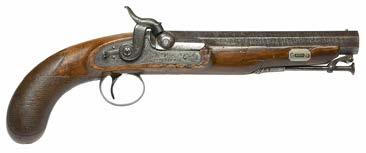

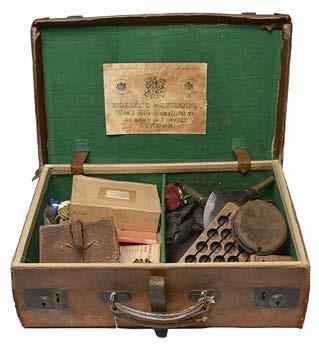

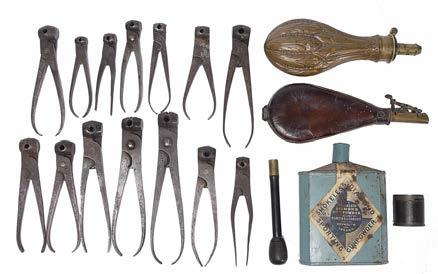
281
A collection of vintage black powder shooting accessories, including: fourteen single cavity ball moulds, various bore sizes, sprue cutters incorporated in the handles; a Curtis’s & Harvey ‘Smokeless Diamond’ powder tin; an empty S.G. 12 bore cartridge box, label with broad arrow mark; and other items. [qty]
£150250
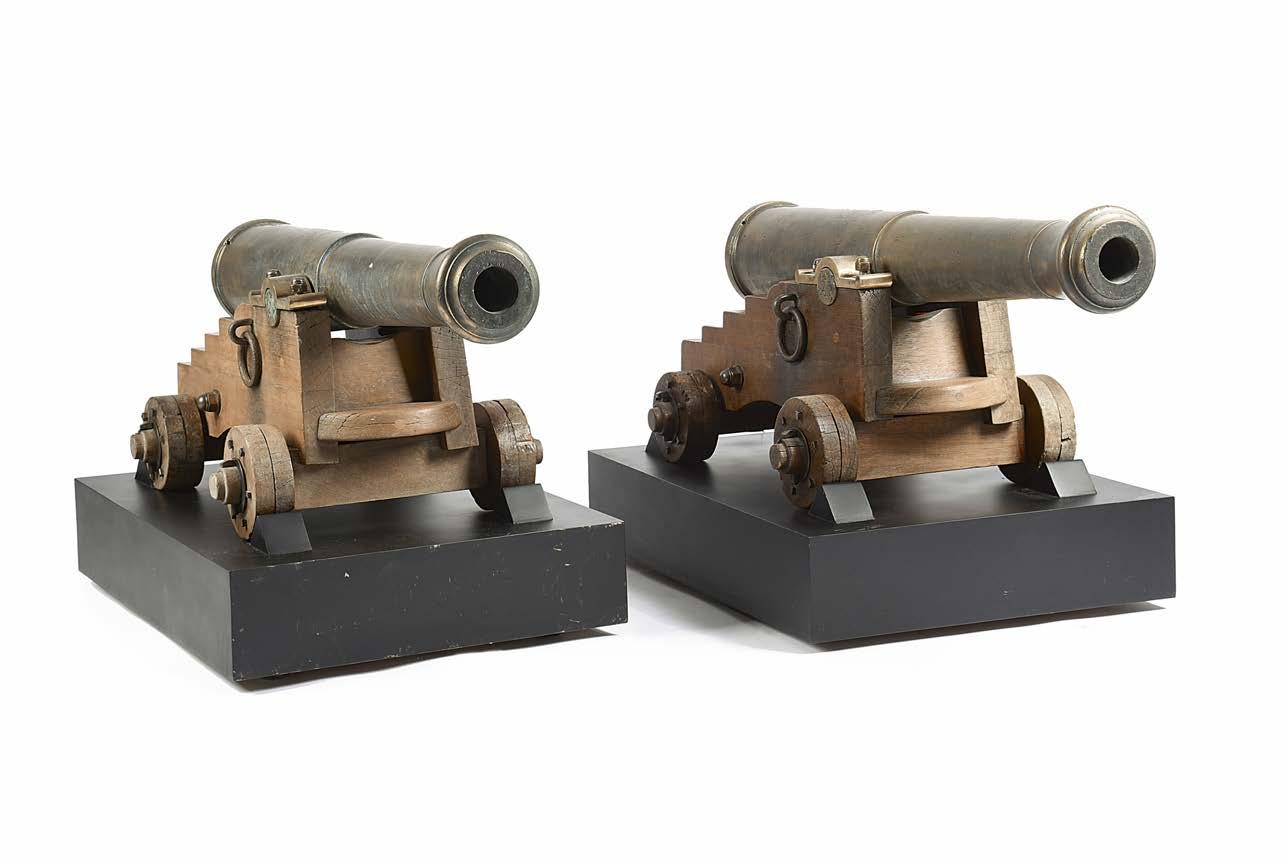
282
A pair of 19th Century continental bronze cannon, twostage ordnances 40.5 in. long including the cascobels and of 2.1 in. bore diameter, breech sections engraved with the Russian Imperial eagle, barrels stepped in front of the trunnions, with tapering chases and swollen muzzles with low astragals, touch holes within teardrop shaped partition,s breeches drilled to receive cannon locks, right trunnions inscribed 'PO 85 K', and left 'No 764'/'No 774', mounted on wooden carriages of naval or fortress type with iron ring bolts and complete with quions, carriages with some later components, each with a modern steel display base. [2]
£10,00015,000

283
A very good Edwardian cannon, sighted twostage brass ordnance 26.75 long and of 1.4 in. bore diameter, mounted on a brass field carriage with elevating wheel acting via linkages on a vertical screw fitted to the cascobel, spoked oak wheels with iron rims and brass hubs, oak ammunition boxes on the axle trees, double ended ram rod/sponge.
£5,00010,000

284
The coronation robe and coronet worn by Colonel the Right Honourable Clive Wigram, 1st Baron Wigram, G.C.B., G.C.VO., C.S.I., P.C., F.Z.S., at the coronation of King George VI and Queen Elizabeth in 1937 and again at the coronation of Queen Elizabeth II in 1953, by Ede & Ravenscroft, the robe of crimson velvet lined with silk, miviner cape with two lines of ermine tails, collar and facings of miniver pure; the coronet comprising a silvergilt band with gadrooned border surmounted by six silvered ‘pearls’, erminetrimmed crimson velvet cap of maintenance with silk lining and gold tassel; the coronet in its card box and the whole preserved in an Ede & Ravenscroft toleware trunk with ‘LORD WIGRAM’ to a brass plate on the lid.
Provenance: By descent
Notes: Clive Wigram was born in 1873 and following an education at Winchester College and RMA Woolwich he embarked on a long and distinguished career in the British and Indian armies and at court. He served with the 18th Bengal Lancers in the Tirah Expedition from 189798, and with Kitchener’s Horse in the 2nd AngloBoer War, for which he was mentioned in despatches. He was AidedeCamp to two Viceroys of India, and Assistant Chief of Staff to the Prince of Wales (later King Edward VII) in India, later serving as his Equerry. He was promoted Colonel in 1919. The many prestigious position that he held at court also included Private Secretary to the Sovereign (1931) and Permanent Lord in Waiting from 193660. He received numerous honours for his services, including Companion of the Order of the Star of India in 1911 and Knight Grand Cross of the Order of the Bath in 1933. He rose within the ranks of the Royal Victorian Order, receiving the Royal Victorian Chain in 1937. In 1935 he was raised to the peerage as Baron Wigram of Clewer in the County of Berkshire. He was also a keen sportsman and a firstclass cricketer.
£1,0001,500

285
Fifth Royal Irish Lancers: a kettledrum banner, or drum cloth, the regimental badge displayed in rich bullion work and embroidery to a dark green velvet ground, fringed silver bullion work border, in a purposemade glazed display frame.
Notes: Presented upon the resignation of his commission, c. 1906, to Harry FaudelPhillips, who had been commissioned 2nd Lieutenant in the 5th Lancers in 1902. An Old Etonian, he rejoined the 5th Lancers for the First World War and was later Deputy Provost Marshal Aldershot Command. He was awarded the French Croix de Guerre in 1917. Together with his wife, Olive, he founded the Pony Club in 1929, and in the Second World War he served as a Major in the Home Guard (Y sector, London District).
£500700
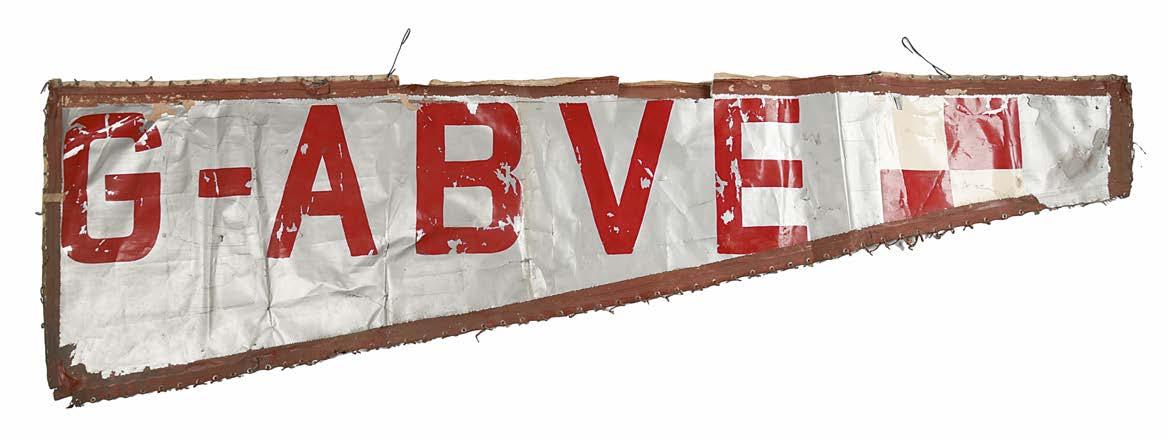
286
Several sections of the canvas airframe cover from the second of two Arrow Active aerobatic biplanes (Active 2), comprising a tapering fuselage panel of silver doped canvas displaying the aircraft's registration mark 'GABVE' in red, and a small area of red and white chequering, a row of grommets along each edge retaining pieces of cord, 222 cm (87.5 in.) long; together with larger sections taken from the wing surfaces, also displaying parts of the registration mark. [5]
Notes: The Arrow Actives were designed and build by Arrow Aircraft under its founder Arthur Cecil Thornton in the early 1930s. Active 2 was originally capable of 137 mph and competed twice in the King's Cup Race. It was rebuilt in 1958 and 1989.
£150200
Royal Military College Sandhurst: a Victorian gentleman cadet’s helmet plate, coppergilt and enamel, eightpointed star surmounted by a crown, the centre with ‘VR’ cypher to a red enamel encircled by the motto ‘NEC ASPERA TERRENT’ to a blue enamel garter; together with a pair of Victorian officer’s epaulettes of the 21st Regiment of Foot, in their Japanned tin case; a Victorian officer’s belt clasp; a pair of Hampshire Regiment shoulder boards; and a pair of 19th century pastel portraits of an officer of the Coldstream Guards and his wife.
£400600
288
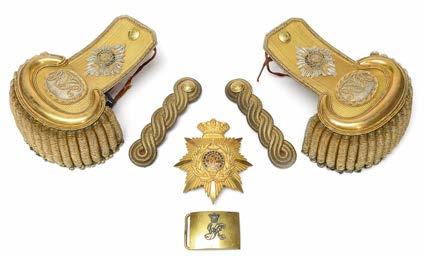
A collection of military and court apparel and equipage, comprising: the leveeweight 1854 pattern Foot Guards officer’s sword of Lieutenant Colonel George Neville Clive Wigram, M.C., Grenadier Guards, 2nd Baron Wigram, blade etched with battle honours and the owner’s initials, nickelplated steel hilt with flaming grenade to the cartouche, with plated steel scabbard and leather covered field scabbard and in a chamois sword bag; the same officer’s sword belt and aiguillettes; a pair of officer’s ankle boots with two pairs of spurs and complete with articulated wooden trees; a pair of white dress gauntlets, and an Elizabeth II Royal Household evening tailcoat.
Provenance: By descent.
Notes: The 2nd Baron Wigram was born in 1915 and educated at Winchester College and Magdalen College, Oxford, where he joined the OTC. He was commissioned in the Grenadier Guards in 1937, served in the British Expeditionary Force in France, and was evacuated from Dunkirk in 1940. He returned to the European theatre as a Captain in the Normandy Landing in June 1944. Serving in the Guards Armoured Division he earned the immediate award of the Military Cross for his gallant and skillful leadership of a squadron of the 2nd Armoured Battalion, Grenadier Guards part of the 5th Guards Armoured Brigade. On the 30th of March 1945, by now a Major, he seized the town of Aalten on the line of advance North from the Rhine, in the face of fierce opposition, securing bridges, taking prisoners, and enabling the Brigade to continue its advance. His sword and aiguillettes were also worn by his son Andrew, 3rd Baron Wigram, who followed him into the Grenadier Guards. See also lots 268 and 294.
£300400
289
Group Captain Sir Douglas Bader, CBE, DSO & Bar, DFC & Bar, DL, FRAeS: the celebrated Second World War RAF flying Ace’s service issue ATP wristwatch, with silver dial, Arabic numerals and luminous markers, the 15 jewel manual wind movement signed Timor, the case with fixed bars and marked ‘A.T.P.’ under a broad arrow, numbered 68012; offered together with Bader’s RAF identity tag; a copy of a Bader biography: Paul Brickhill, ‘Reach for the Sky’; Andy Saunders, ‘Bader’s Last Flight’; Dilip Sarkar, ‘Bader’s Tangmere Spitfires, the untold story, 1941’; a Robert Taylor print ‘Spitfire’ signed in pencil by Bader and by Johnnie Johnson, another print ‘Duel of Eagles’ signed by Adolph Galland, and a quantity of associated photographs and ephemera. [qty]
Provenance:
Sotheby’s. 13th April 1999
Watches of Knightsbridge, 12th July 2014, lot 54. Sold in these rooms, 20th November 2019, lot 451
Notes: Douglas Robert Steuart Bader became a double leg amputee following a plane crash in 1931. He nevertheless returned to active duty at the start of the Second World War and scored numerous kills before being made a prisoner of the Germans. While in captivity he made several escape attempts, in spite of his disability.
£3,0004,000
290
DDay/Operation Neptune interest: two handdrawn charts: the first covering the English Channel between the Straights of Dover and Dartmouth/Les Sept Iles (including the area of the invasion beaches) showing radar stations on both sides and marked in red and green ink with their zones of coverage, marked "TRACING FROM CHARTS F.0346, F.0347, F.0348 / D.C.P. WARD W.R.N.S. PORTSMOUTH JUNE 1944", 107 x 97 cm; the second covering The Solent and Southampton Water and marked with the positions of landing craft and other vessels, entitled inter alia "KEY DIAGRAM (TRACING FROM CHART No 2045)" and "State at 1400 D 1", partial label verso ("Commander Branson" ?) 73 x 57 cm. [2]
Notes: Operation Neptune was the official code name for what is today remembered as the Normandy Landings of June the 6th 1944. Neptune was the main offensive component of the overarching strategy named Operation Overlord. The Normandy Landings, which will have their 81st anniversary in the week of this auction, involved an immense logistical effort on the part of the Royal Navy. This lot offers the buyer an original relic of those momentous days, as well as a direct insight into the planning involved.
£500600
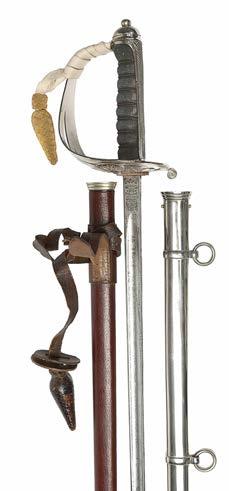

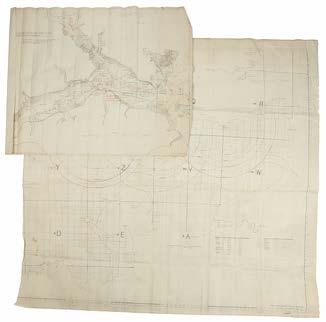
291
H.M.S. Kenya: a silver tompion plate, of circular form, applied lion rampant guardant against alternating plain and reeded waves, a dedication engraved in serif capitals ‘PRESENTED BY THE PEOPLE OF KENYA TO H.M.S. KENYA. LAUNCHED ON THE 18TH AUGUST 1939’, all within a roped border, by the Goldsmiths & Silversmiths Company, London, 1941, 11.2cm. £200300
292
An astral ships clock, brass cased with heavy glass cover, white dial with black markings, large outer ring marked in minutes, numbered 0552/4619413. £150200
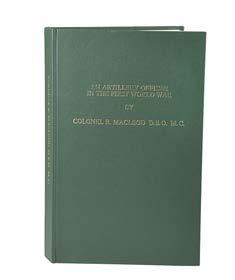
293
Colonel Roderick McCleod, D.S.O., M.C., ‘An Artillery Officer in the First World War’, privately published, cased bound in green cloth covered boards with gold lettering, holepunched text block.
Provenance: A gift by the author to a relative of the current owner.
Notes: This very rare book is a personal account of the Great War by Colonel Roderick McCleod, D.S.O., M.C., Royal Artillery, who was born on the 13th of November 1891 and entered the Royal Artillery as a 2nd Lieutenant on the 23rd of December 1911. He had attained the rank of Captain (Acting Major) by the end of the war, and his D.S.O. was gazetted on the 1st of January 1919 for “distinguished service in connection with military operations in Italy”. He had previously been awarded the M.C. (London Gazette 4th of June 1917).
Roderick McLeod was involved in the Curragh Incident of March 1914, and served in the Battle of Mons and at Le Cateau where he was wounded. He was evacuated to the United Kingdom and returned to the Western Front in 1915 to participate in numerous other battles. Part of his service was as a liaison officer with the Royal Flying Corps. He was sent to Italy in November 1917 and fought in the Battle of the Asiago Plateau.
This copy of his memoir, which is in firstclass condition, is accompanied by a letter from the first owner confirming that she received it directly from Colonel McLeod, who was a family friend.
£200300
295
A large collection of arms & armour and militaria reference books, including: Brian Robson, ‘Swords of the British Army. The Regulation Patterns 1788 to 1914’, revised edition, hardcover; D.W. Bailey, ‘British Military Longarms 17151815’; John M. Yumoto, ‘The Samurai Sword. A Handbook’; Richard Fuller and Ron Gregory, ‘Military Swords of Japan 18681945’; Arthur L. Kipling and Hugh L. King, ‘Head Dress Badges of the British Army’, volumes one and two; Robert Hamilton, ‘Victoria Cross Heroes of World War One’; and numerous other titles. [qty]
£200300
296
Three reference books relating to Purdey gunmakers, vis.: L. Patrick Unsworth, ‘The Early Purdeys’; Donald Dallas, ‘Purdey Gun & Rifle Makers, The Definitive History’; and Richard Beaumont, ‘Purdey’s The Guns and The Family’; all hard bound with dust jackets. [3]



294
A split cane fly fishing rod by Ogden Smith, in a leather covered fitted case with an Ogden Smith ‘Exchequer’ fly reel, and accessories comprising: spring balance, fly oil bottle, fly case, fly tin with flies, and clasp knife, all engraved with the initials ‘N.W.’.
Provenance: Lieutenant Colonel George Neville Clive Wigram, M.C., 2nd Baron Wigram
Notes: Lieutenant Colonel George Neville Clive Wigram, M.C., Grenadier Guards, 2nd Baron Wigram, received this rod together with the guns in lot 268 as a 21st Birthday present from Robert Grant, 2nd Baronet Grant of Forres, in 1936. He was commissioned in the Grenadier Guards in the following year, and served with great distinction in the Second World War, winning a Military Cross in 1945. See also lot 288.
£150200
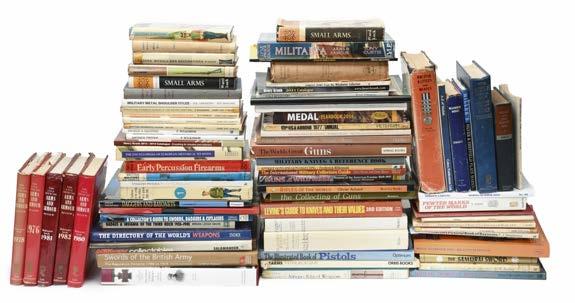
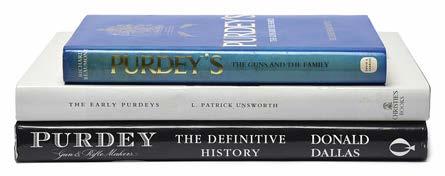
£200300
City Centre Salerooms
Monday to Friday 9am – 5pm
Old Sarum Galleries
Monday to Friday 9am – 5pm
All our auctions are on view at least two days prior to the sale and details will be found in the relevant catalogues.
All first time buyers need to register with us. To register, you will need to provide two forms of identification:
1. a passport or photographic driving licence
2. a utility bill or document showing your name and address
You can register in person or by contacting client services on 01722 424500 or emailing id@woolleys.live
You will be asked to show your documents or email copies.
PLEASE NOTE: Registering with our website, or any third party website, does not automatically register you to bid with us.
See below for the different options for bidding. Please note that you may be asked to provide two forms of identification, even if you have bid with us before, in order that we are compliant with Money Laundering Regulations.
To bid at auction you will need a paddle number. This can be obtained from client services either during the view or on the day of the sale.
If you are unable to attend the sale you can leave a commission bid. This will be executed on your behalf by the auctioneer who will purchase the lot as cheaply as possible bearing in mind any reserve price and other bids.
It is usually possible to bid on the telephone by prior arrangement with client services
Live online bidding is now available free of charge for most of our auctions via bid.woolleyandwallis.co.uk, enabling you to take part in the bidding from anywhere in the world live as it happens.
The Buyer shall pay the hammer price together with a premium thereon of 26% plus VAT @20% (totalling 31.2% inclusive) on the first £500,000 and 20% plus VAT @20% (24% inclusive) thereafter.
The relevant department will be pleased to give condition reports on any lot, where practical. All weights and measures given in the catalogue should be regarded as approximate.
The colours printed in the catalogue are not necessarily true.
These will be posted on our website shortly after the sale.
Woolley & Wallis do not offer a packing and despatch service but the following are carriers in our area.
Alban Shipping +44 (0)1582 493099 info@albanshipping.co.uk www.albanshipping.co.uk
Kimdan Ltd +44 (0)7973 389436 andy@kimdan.co.uk
Mailboxes +44 (0)1962 622133 info@mbewinchester.co.uk www.mbe.co.uk/winchester
ZIXIS Fine Art Limited +44 (0)7873 981026 zixisfineart@163.com www.zixisfineart.co.uk
Please note that we cannot be held responsible for any damage or loss to items once they are in the hands of a carrier.
If you are exporting your property, import taxes, customs duties and other fees may apply at the country of destination. It is also your responsibility to ensure that your shipment can be lawfully imported to the destination country.
Please note that due to the withdrawal of the Retail Export Scheme by HMRC, we are unable to provide VAT refund documentation (C88) for handcarried exports.
In order to qualify for a VAT refund, your lots must be exported by a shipper and valid export documentation must be provided.
Payment is due immediately after the auction in pounds sterling. If you are a first time buyer we will need your name, address and bank details and will require funds to be cleared before purchases can be released.
The following methods of payment may be made:
Bacs, debit and credit cards
Wire transfers should be sent to:
Lloyds Bank plc, Blue Boar Row, Salisbury SP1 1DB. Account no. 00957707
Sort code 309741
IBAN no. GB20LOYD30974100957707
BIC code LOYDGB21063
Debit and Credit cards: Visa, Mastercard, Amex or Union Pay.
Where practical, payment can be made and purchases collected during the auction.
We reserve the right to add storage charges to all lots not collected within 30 calendar days of the sale. This will include a handling fee of £20 (+ VAT) per consignment and a storage charge of £2 (+ VAT) per lot per day. No goods will be allowed to be collected until these charges have been paid.
Lots marked with an dagger (†) are subject to VAT on the hammer price. Lots marked with an omega (Ω) have been temporarily imported from outside the EU and are subject to VAT at 5% on the hammer price and the buyer’s premium. In online catalogues, the Sales Tax % column indicates the rate of VAT on hammer price.
Please note that lots marked λ may be subject to CITES Regulations when exported.
The CITES Regulations may be found at www.defra.gov.uk/ahvlaen/importsexports/cites/
Lots marked with a Φ symbol are potentially subject to a levy.
Droit de Suite is a royalty payable to a qualifying artist or the artist’s heirs each time a work is resold during the artist’s lifetime and up to a period of 70 years after the artist’s death.
Royalties are calculated on a sliding percentage scale based on the hammer price excluding the buyer’s premium. The royalty does not apply to lots selling below £1,000 and the maximum royalty payable on any single lot is £12,500.
Droit de Suite, which is not subject to VAT, will be added to the buyer’s purchase price and then passed on to the relevant collecting agency.
Royalties for Droit de Suite are as follows:
4% Up to £50,000
3% £50,000.01 200,000
1% £200,000.01 350,000
0.5% £350,000.01 500,000
0.25% In excess of £500,000
Up to a maximum levy of £12,500
Lots marked Ƒ in the catalogue, or by any other means identified as controlled firearms, are subject to the UK firearms/shotgun licencing regime, and should only be viewed/purchased by individuals with appropriate licences. It is the responsibility of the bidders to ensure that they are legally authorised to acquire the lot that they are bidding for. In the event that such a lot is successfully bid for by an individual who is not authorised to possess it, that individual will be required to pay for it, but will not be allowed to take physical possession of it. The auctioneers will reoffer the lot on behalf of the buyer in a future auction; or may accept instructions to dispose of it by some other legal means, at their discretion.
Valuations are a core part of our business and are usually carried out by a senior specialist or directors. Accuracy, speed and above all confidentiality are paramount.
Written valuations for insurance can vary from a single item to a large estate. Before starting we discuss the various options available so that the valuation is specifically tailored to individual client’s needs.
For valuations of an entire house contents an itemised bound valuation is produced and can be accompanied by photographs when required. In addition to providing an inventory, written valuations can prevent painful arguments with a loss adjuster in the event of a claim.
Woolley & Wallis valuations are accepted by all leading insurance companies.
We offer a speedy and professional service for executors and trustees and provide bound valuations for probate and duplicate copies when required. Since security is often a consideration, we can usually arrange for a house to be cleared and sent for auction, our Valuations Department ensures that executors are informed of which sales are involved and the results thereof.
We also carry out valuations for Family Division, Capital Gains Tax, and Private Treaty Sales.
Contact Jeremy Lamond +44 (0)1722 424502 | valuations@woolleys.live
Free verbal valuations of items for sale are available by appointment. Please email valuations@woolleys.live or call +44 (0)1722 424500




Please dial +44 (0)1722 followed by the number listed below
MEDALS & COINS, ARMS & ARMOUR
Ned Cowell 341469
Molly O’Reilly 446980
20TH CENTURY DESIGN
Michael Jeffery 424505
Zoe Smith 446955
AFRICAN & OCEANIC ART
ANTIQUITIES
Will Hobbs 339752
Molly O’Reilly 446980
ASIAN ART
John Axford MRICS 424506
Alexandra Aguilar 424583
Freya YuanRichards 424589
Jeremy Morgan +44 (0)7812 601098
Michelle Yu 424571
Olivia Jones 424591
BRITISH AND CONTINENTAL CERAMICS & GLASS
Clare Durham 424507
CHINESE PAINTINGS & CALLIGRAPHY
Freya YuanRichards 424589
Michelle Yu 424571
FURNITURE, WORKS OF ART & CLOCKS
Mark YuanRichards 411854
Neil Grenyer 446974
Jim Gale 339161
Sarah Stone 339161
Victoria Elwell 339161
JAPANESE ART
Alexandra Aguilar 424583
Olivia Jones 424591
JEWELLERY
Marielle Whiting FGA 424595
Jonathan Edwards FGAA (Consultant) 424504
Jacob Carpenter 424586
Freya Miller 424586
Beth Reardon 424586
PAINTINGS
Victor Fauvelle 446961
Ed Beer 446962
Victoria Sturgeon 446970
Heidi Easton 446970
SILVER
Rupert Slingsby 446956
Archie Swann 446959
Becky TillyTrickett 446957
VALUATIONS FOR INSURANCE & PROBATE
Jeremy Lamond MRICS FRSA 424502
Neil Grenyer 446974
Frances Woodhams
Hannah Farthing (Trainee Valuer)
CLIENT SERVICES
Ruth Pike (Client Services Manager) 424500
Julie Langstaff
Gemma Pointer
Riin RohtlaSzeverenyi
Demi JuenoChapman
Sarah Lancaster
PHOTOGRAPHER
Fahmeeda Yasmin
MARKETING
Chloe Davie 446951
PRESS
Sandie Maylor +44 (0)7976 311172
ACCOUNTS
Ania Antkowiak
BOARD OF DIRECTORS
John Axford MRICS Chairman
Natalie Milsted FCCA
Managing Director
Alexandra Aguilar Director
ASSOCIATE DIRECTORS
Ed Beer
Ned Cowell
Clare Durham
Victor Fauvelle
Will Hobbs
Michael Jeffery
Jeremy Lamond MRICS FRSA
Rupert Slingsby
Marielle Whiting FGA
Freya YuanRichards
Mark YuanRichards

